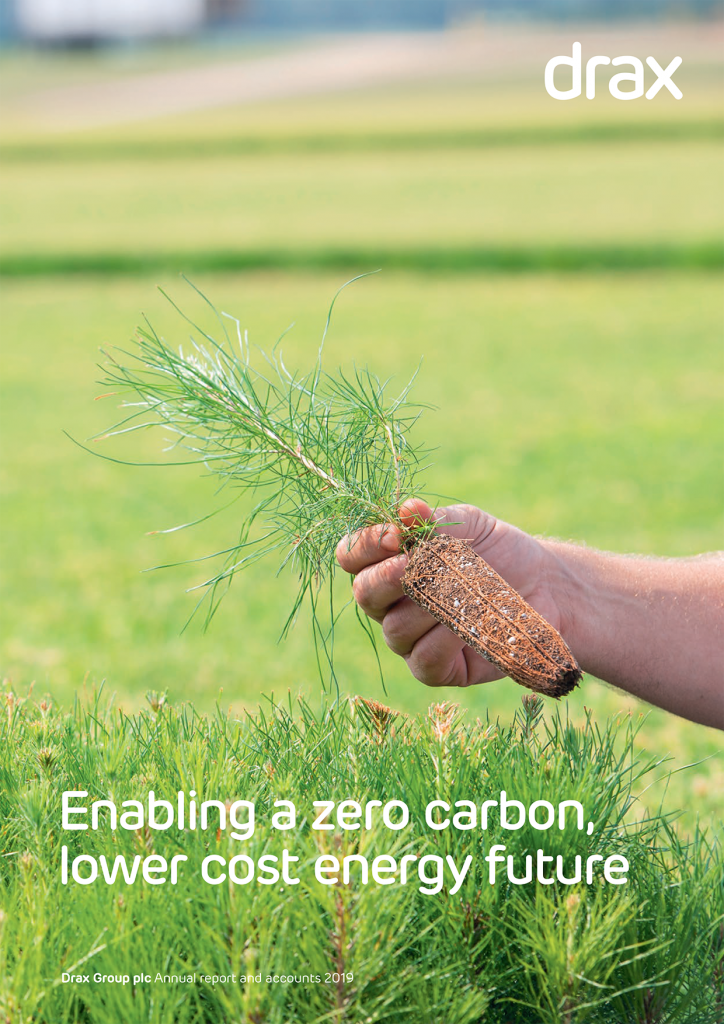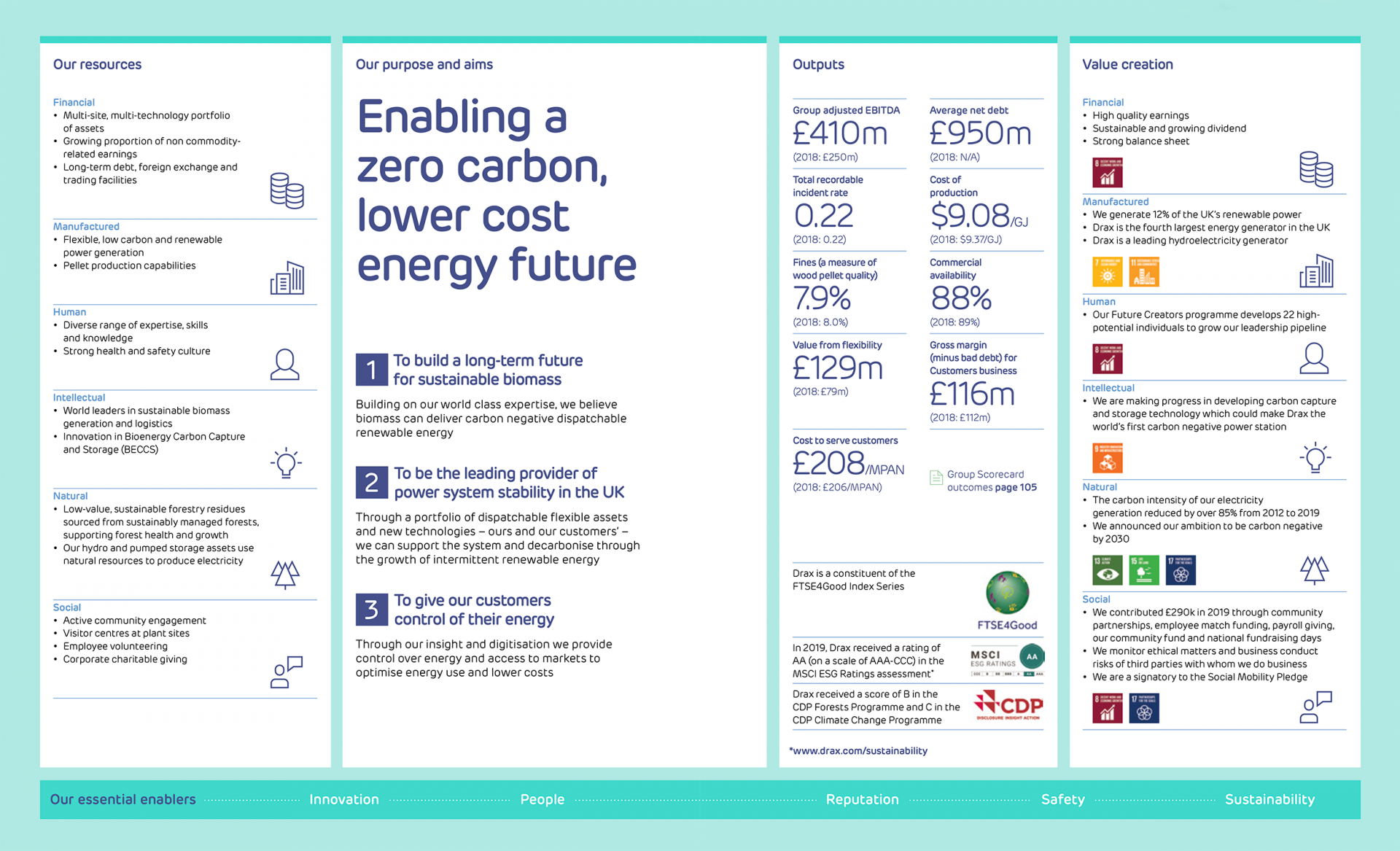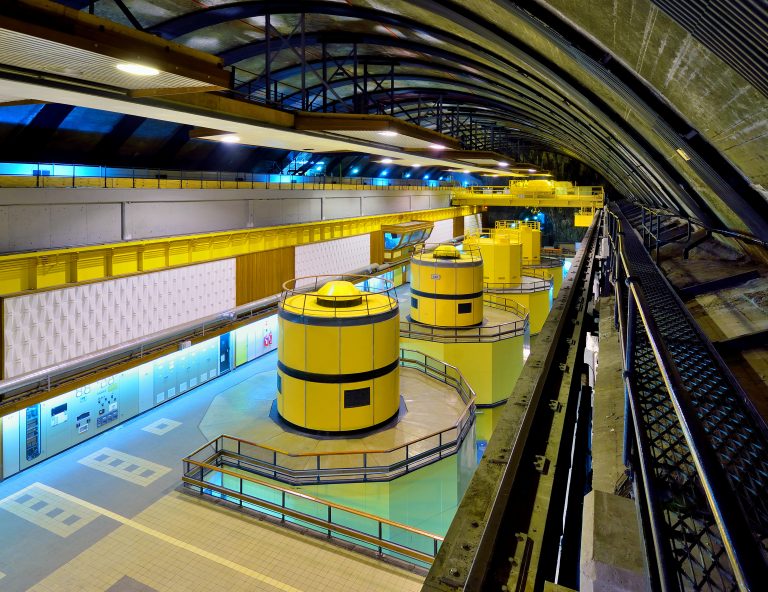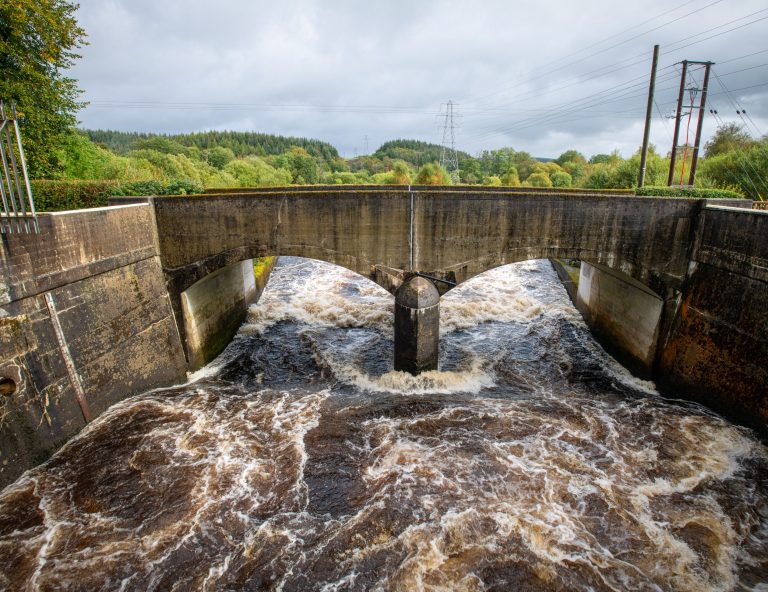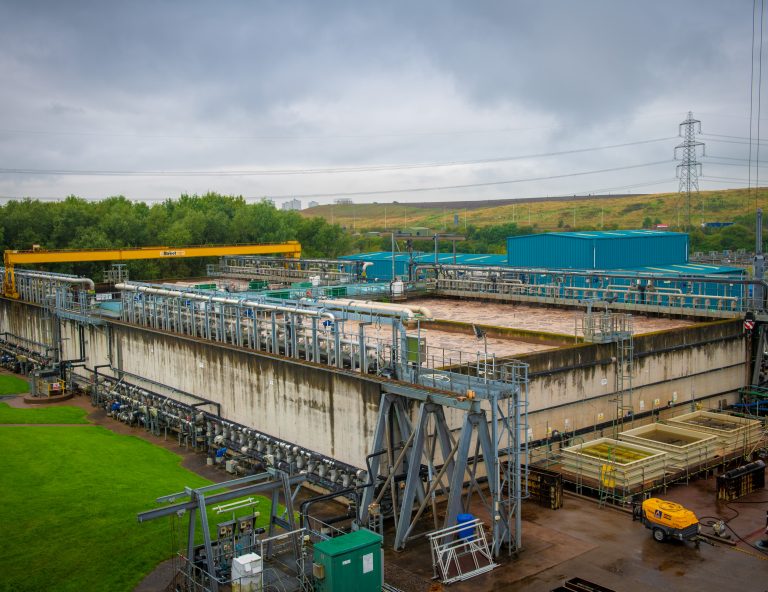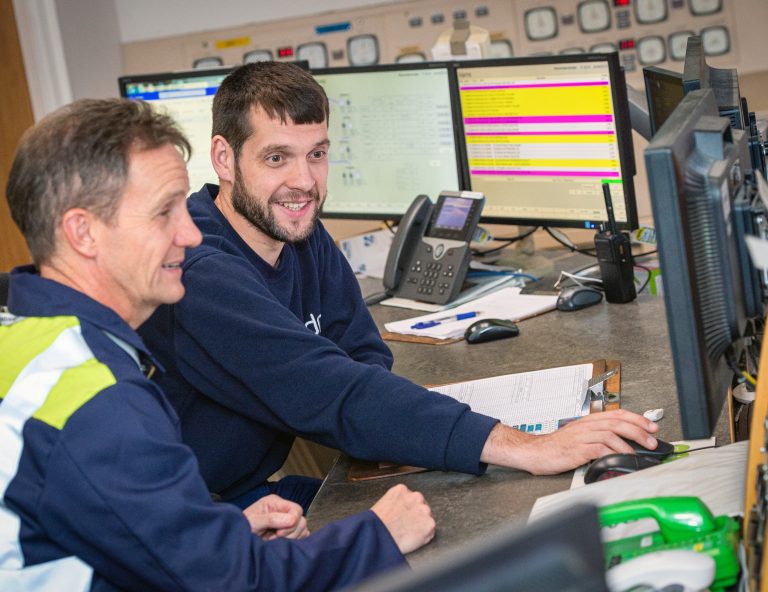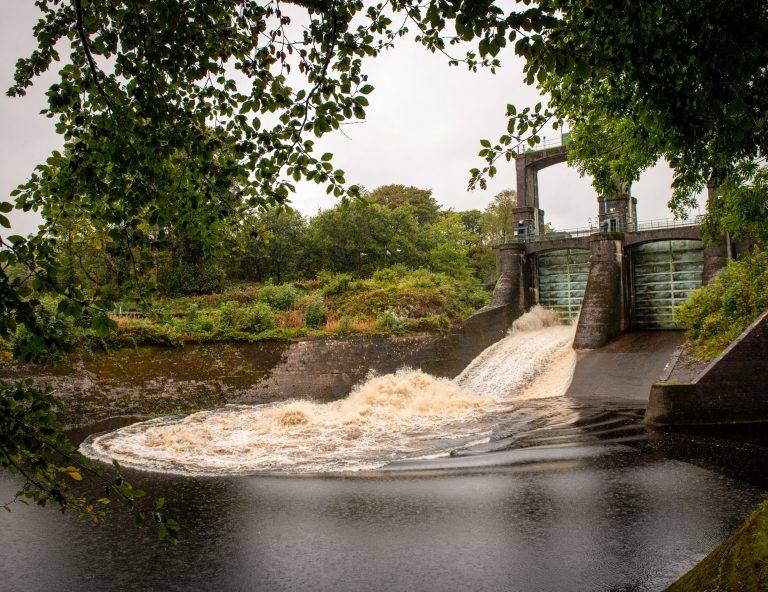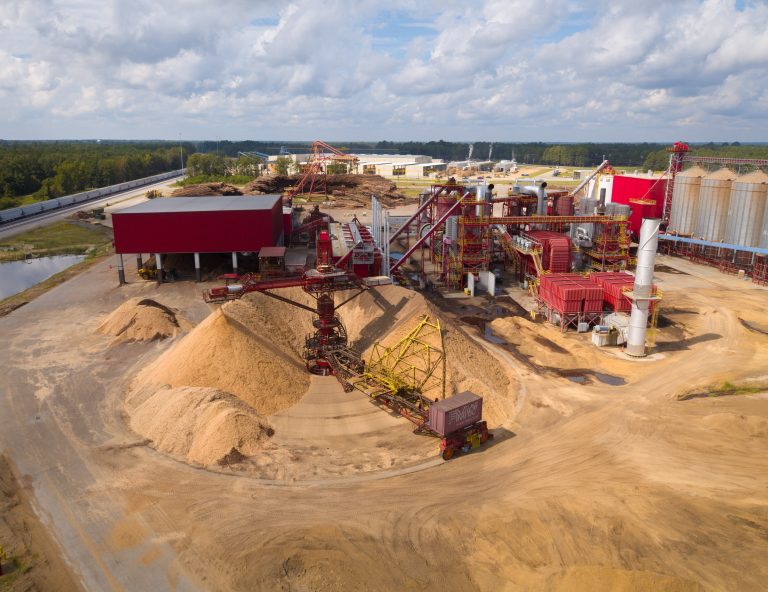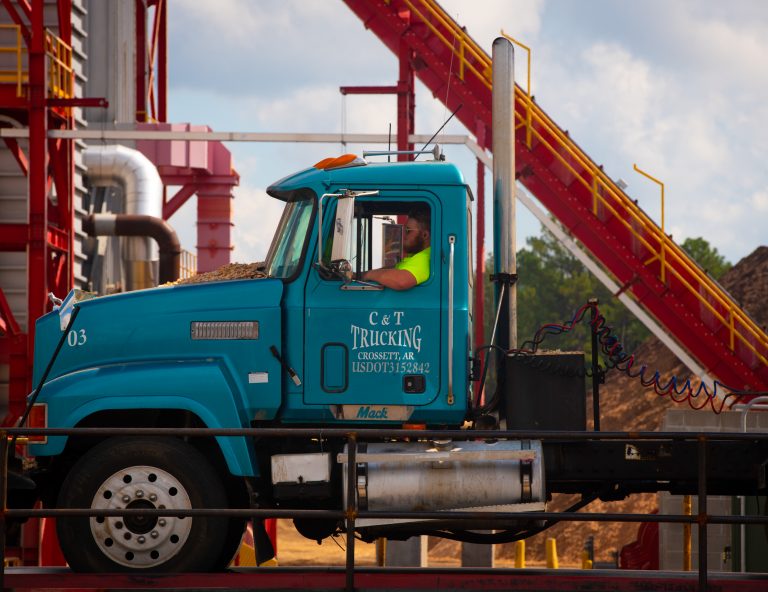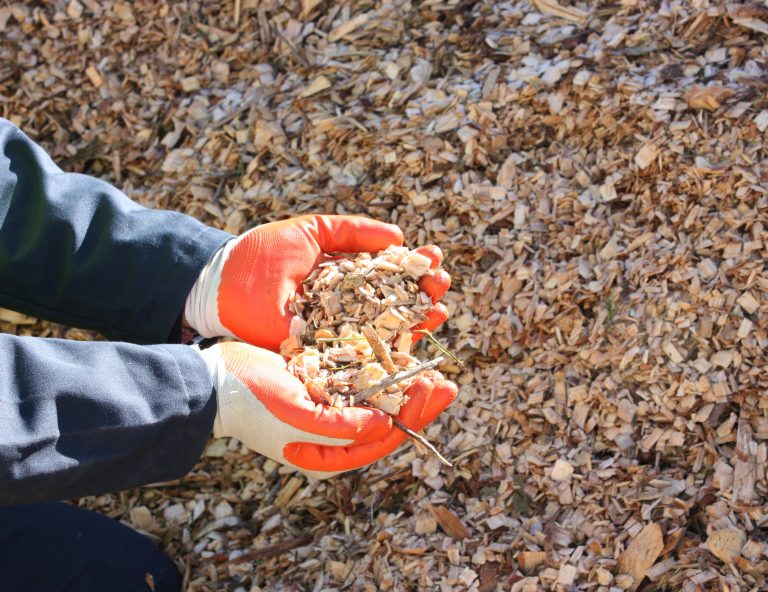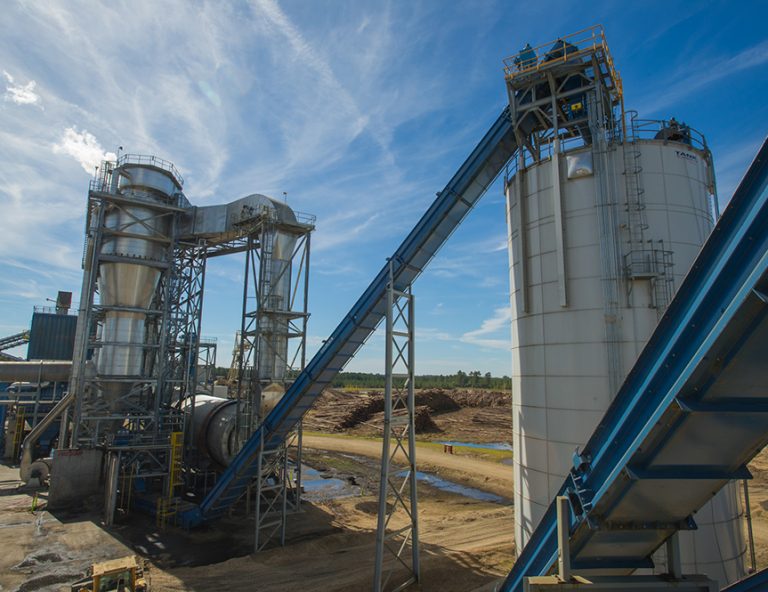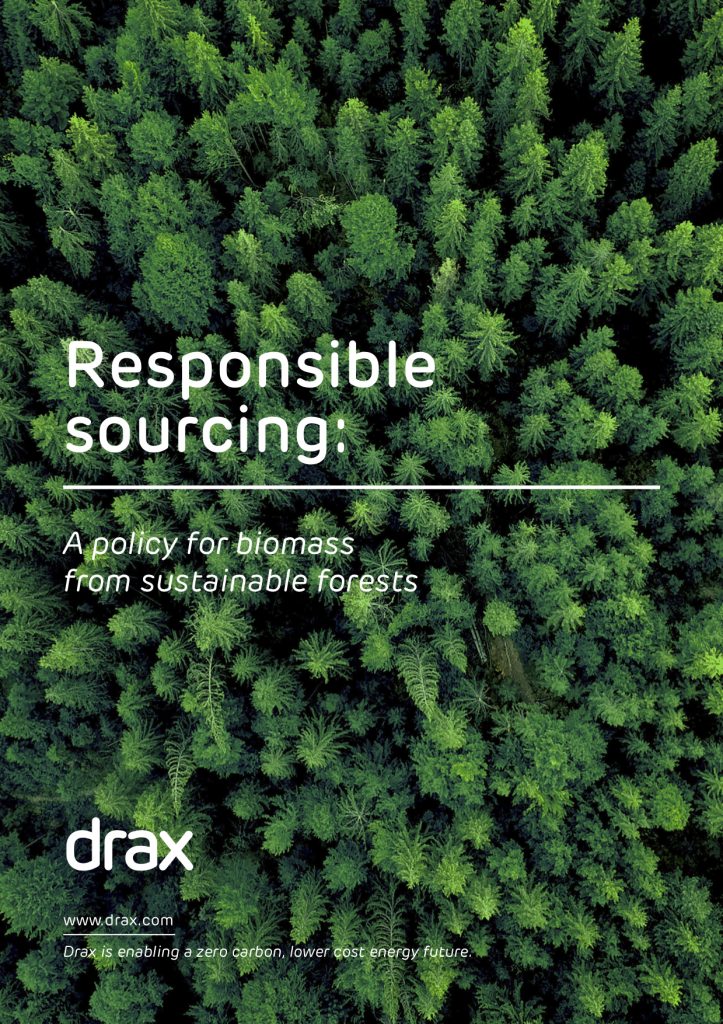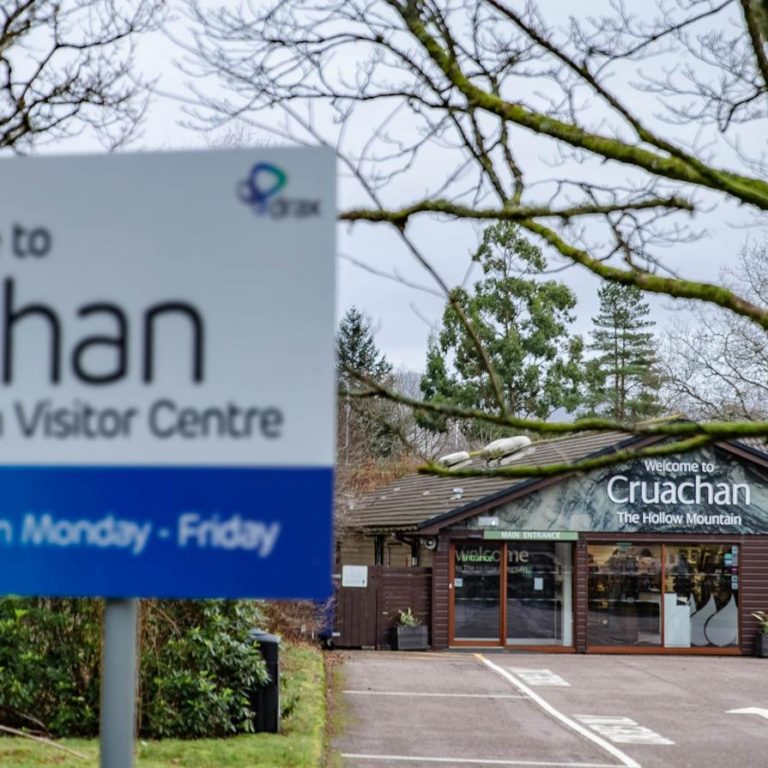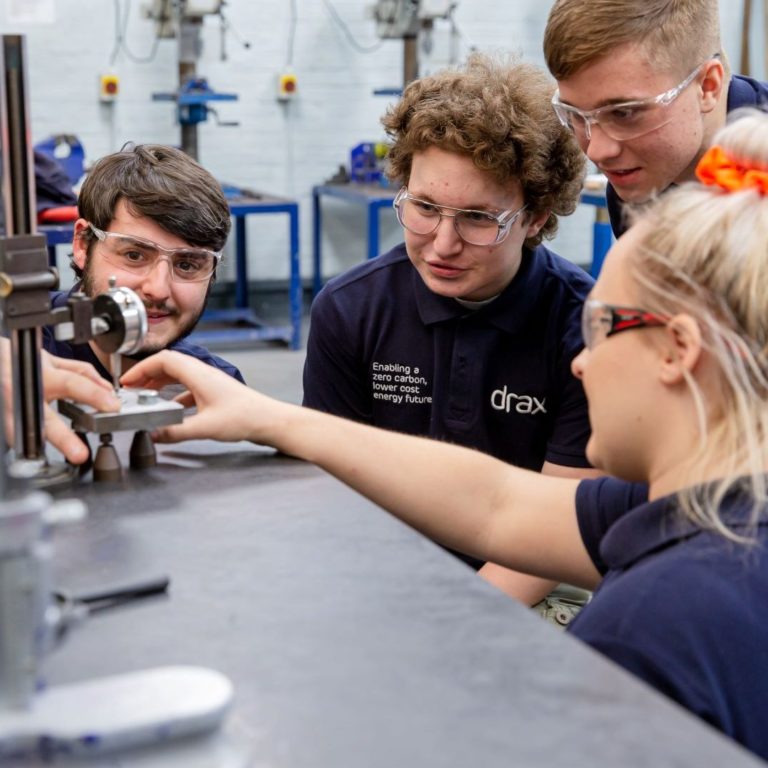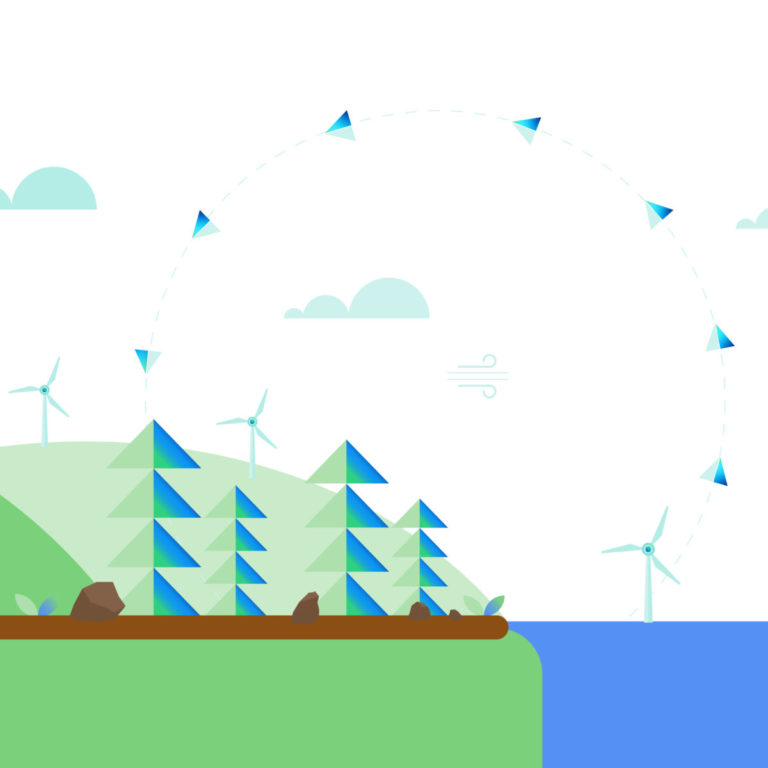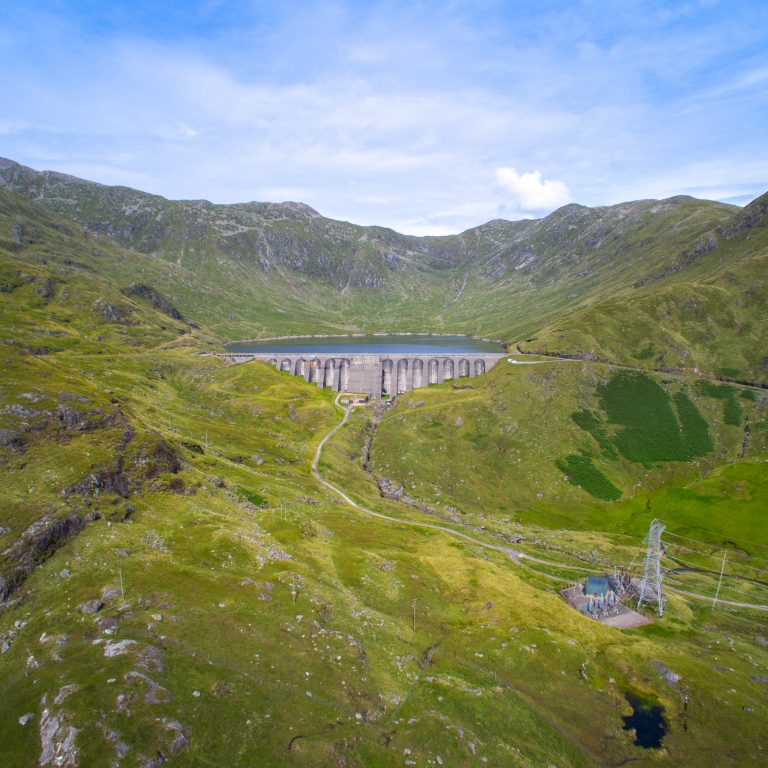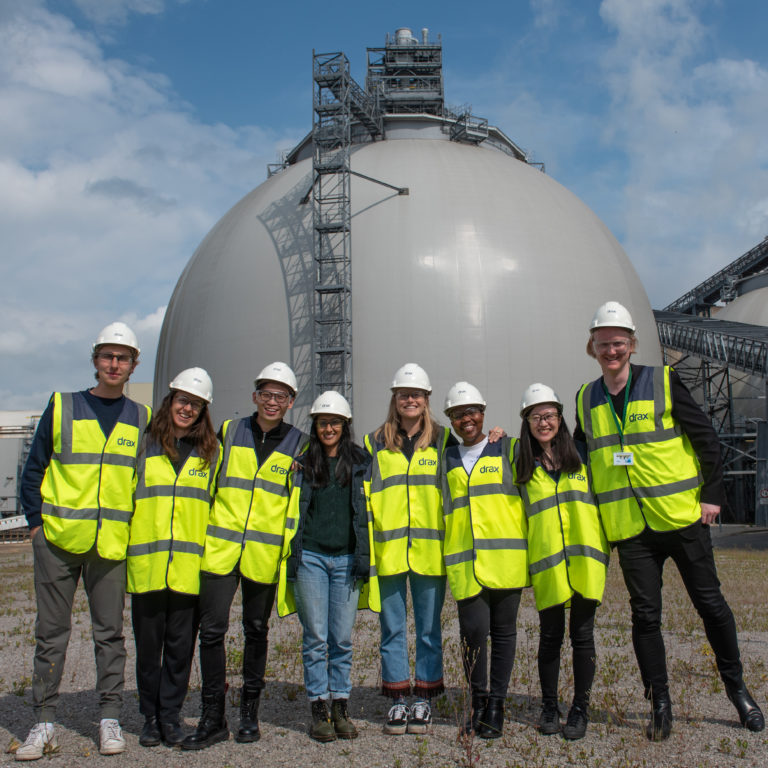Enabling a zero carbon, lower cost energy future
Chapter 1:
Welcome, 2019 highlights and activities at a glance
Welcome to Drax Group
Our purpose is to enable a zero carbon, lower cost energy future.
Our ambition is to become carbon negative by 2030. Being carbon negative means that we will be removing more carbon dioxide from the atmosphere than we produce throughout our operations – creating a negative carbon footprint for the company.
Our strategic aims are:
-
To build a long-term future for biomass
Building on our world class expertise, we believe biomass can deliver carbon negative dispatchable renewable energy.
-
To be the leading provider of power system stability
Through a portfolio of dispatchable flexible assets and new technologies – ours and our customers’ – we will support the system and decarbonise through the growth of intermittent renewable energy.
-
To give our customers control of their energy
Through the provision of insight and digitisation we provide control over energy and access to markets to optimise energy use and lower costs.
This webpage presents the Strategic Report section. View the full Drax Group plc Annual Report and Accounts PDF.
2019 Highlights

1) We calculate Adjusted financial performance measures, which are specific to Drax and exclude income statement volatility arising from derivative financial instruments and the impact of exceptional items, to provide additional information about the Group’s performance. Adjusted financial performance measures are described more fully on page 131 of the full PDF report, with a reconciliation to their statutory equivalents in note 2.7 to the consolidated financial statements on page 149 of the full PDF report. Throughout this document we distinguish between Adjusted financial performance measures and Total financial performance measures, which are calculated in accordance with International Financial Reporting Standards (IFRS).
Our core activities at a glance
We operate an integrated value chain across three principal areas of activity: sustainable wood pellet production; flexible, low carbon and renewable energy generation; and energy sales and services to business customers.

PELLET PRODUCTION
A leading producer of wood pellets from sustainable low-value commercial forestry residues
Our pellets provide a sustainable, low carbon fuel source. This can be safely and efficiently delivered through our global supply chain and used by Drax’s Generation business to make flexible, renewable electricity for the UK. Our manufacturing operations also promote forest health by incentivising local landowners to actively manage and reinvest in their forests.
Our assets:
- 2 x 525 kt pellet plants
- 1 x 450 kt pellet plant
- 350 kt planned expansion of existing facilities, under construction
- 2.4 Mt export facility at Baton Rouge port
Pellets produced
1,407kt
Sales of pellets
£229m

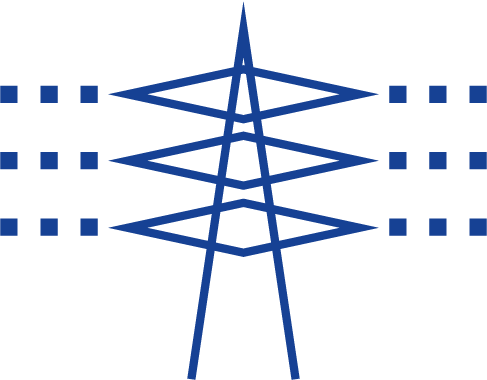 GENERATION
GENERATION
A portfolio of flexible, low carbon and renewable UK power generation
Our multi-site, multi-technology generation portfolio provides power and system support services to the electricity grid. This portfolio provides long-term earnings stability and opportunities to optimise returns from the transition to a low carbon economy.
Our assets:
- Renewable biomass – 2.6GW
- Hydro – 0.6GW
- Thermal:
- Gas – 2.0GW
- Coal – 1.3GW
Generation
17.3TWh
Renewables
79%
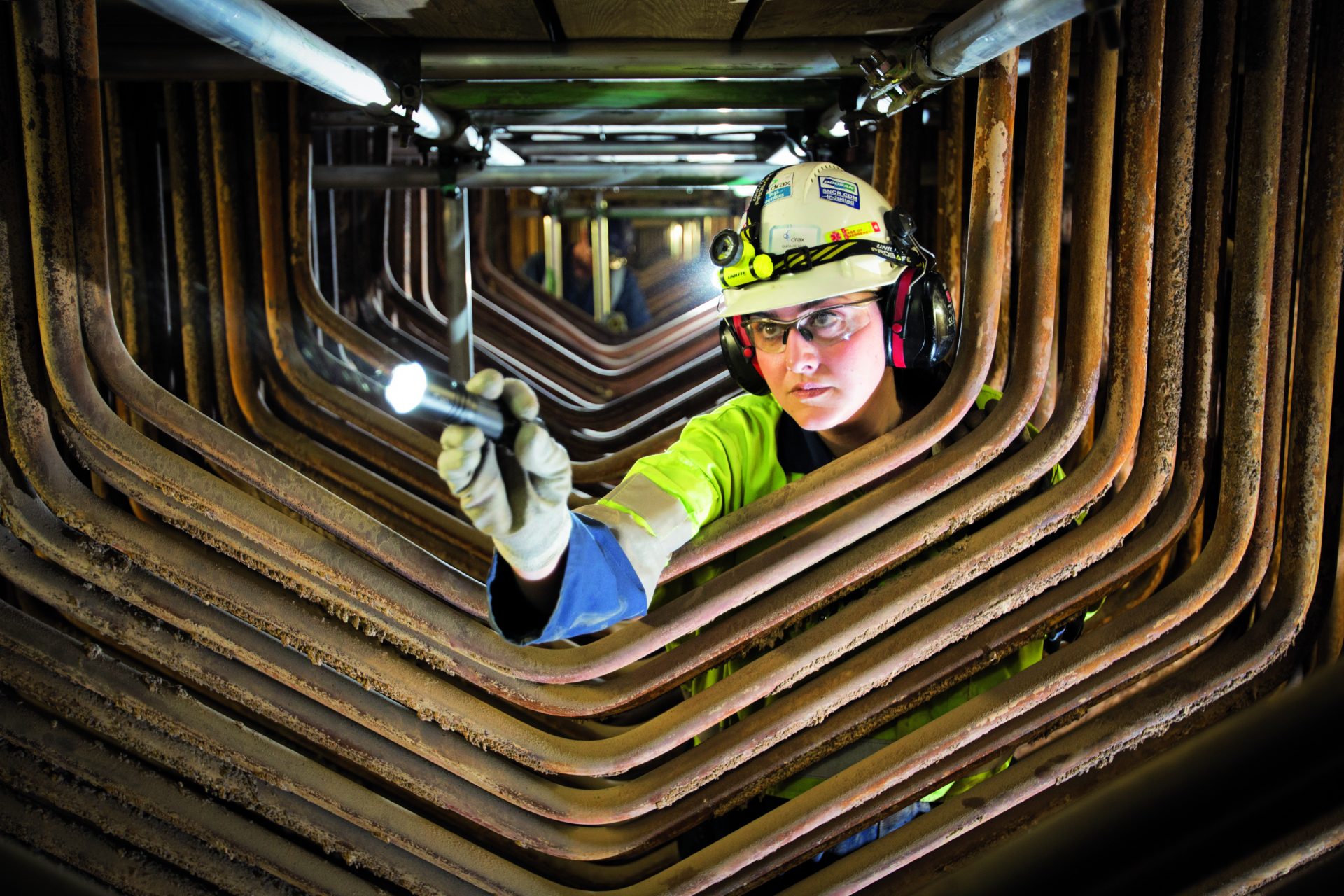
CUSTOMERS
A leading supplier of renewable energy solutions to industrial and business customers
Our B2B Energy Supply business – comprised of Opus Energy and Haven Power – is the third largest B2B power supplier in the UK and the largest supplier of renewable energy to British businesses.
We are giving our customers control of their energy, which in turn supports the stability of the energy system.
Our assets:
- Opus Energy
- Haven Power
Customer meters
419k
Electricity and gas sales
18.9 TW

Chapter 2:
Business Model
Chapter 3:
Chair's Statement and Group CEO's review
Chair’s Statement
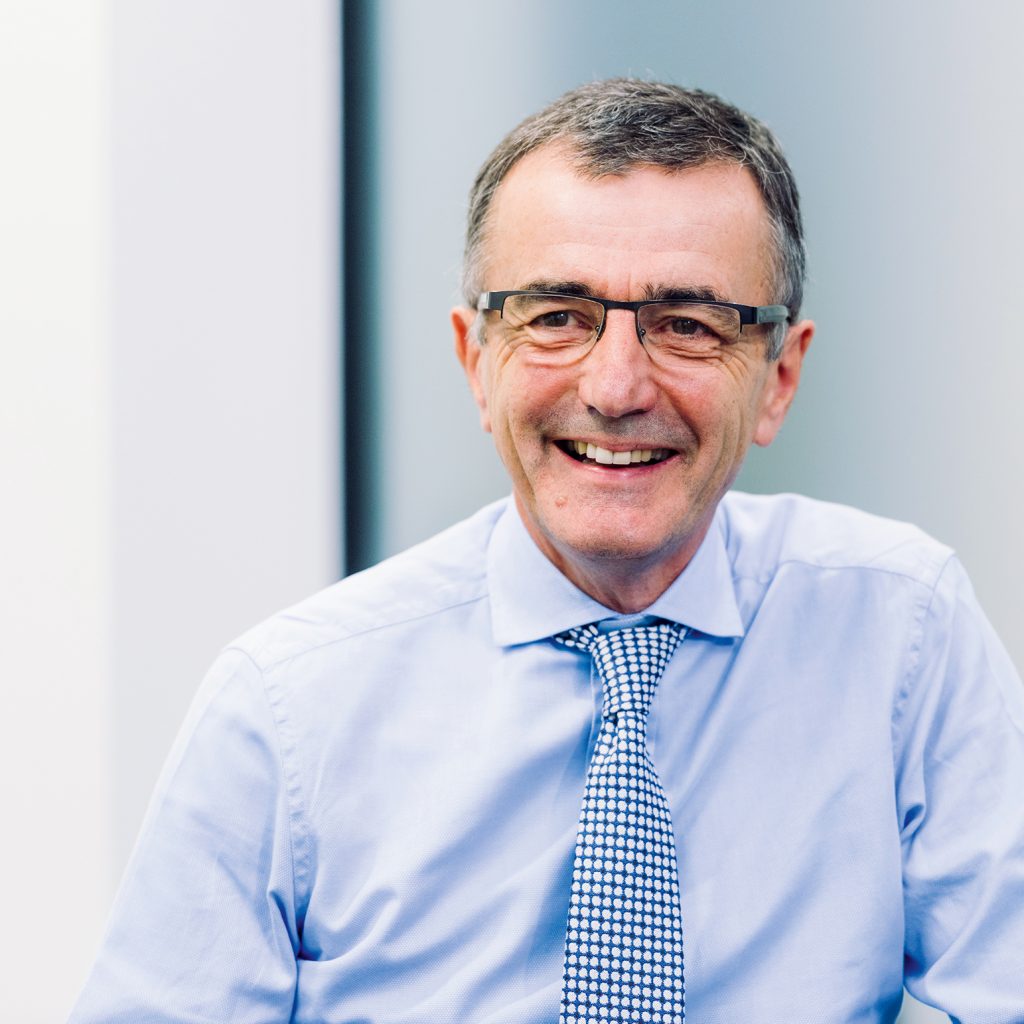
Investment Case
-
Critical to decarbonisation of the UK’s energy system and a major source of flexible, low carbon and renewable power from a nationwide portfolio of generation technologies
-
Underlying growth in the core business and attractive investment opportunities
-
Increasing earnings visibility, reducing commodity exposure
-
Strong financial position and clear capital allocation plan
“We continue to advance our purpose of enabling a zero carbon, lower cost energy future.”
Philip Cox, CBE Chair
Introduction
Drax Group’s purpose is to enable a zero carbon, lower cost energy future.
Since 2012 Drax has reduced its reported carbon emissions by over 85%. In December, we took a step further and announced an ambition to become carbon negative by 2030. With the right support and negative emissions framework from the UK Government, we believe we can realise this ambition.
Through these activities we expect to play a major role in delivering the UK’s legally binding objective to become carbon neutral by 2050.
The Group’s purpose informs our strategy through which we aim to build a long- term future for sustainable biomass, become the leading provider of system stability in the UK and give customers control of their energy.
In 2019 we continued to make good progress in delivering this strategy. In doing so we are delivering higher quality earnings, reducing commodity exposure and creating opportunities for growth aligned with the UK’s carbon neutral agenda.
Biomass has a long-term role to play in the UK and global energy markets as a flexible and sustainable source of renewable energy, as well as a means to deliver negative emissions. Key to securing this long-term role is reducing the cost of biomass. We aim to increase biomass self-supply to five million tonnes by 2027, which we believe will drive significant cost reduction and attractive returns to shareholders. We have made good progress in 2019 and will continue to implement measures to reduce costs and develop expansion opportunities in 2020.

The Group is working with a range of partner organisations to outline a plan for the decarbonisation of the Humber area. This is an industrial area in the northeast of England with one of the highest levels of CO2 emissions, making it a natural and cost-effective location for the deployment of carbon capture and storage, using Bioenergy with Carbon Capture and Storage (BECCS) at Drax Power Station. Through these initiatives we hope to deliver long-term benefits to a wide range of stakeholders and support the UK’s transition to net zero.
This is one example of how our engagement with stakeholders is an enabler to the delivery of our strategy. On pages 24 to 29 of the of the full PDF report, we provide further detail on our stakeholders and how members of the Board, including Non-Executive Directors, have participated in discussions and sought to understand views in order to inform decision making.
Drax Power Station is the UK’s largest single source of renewable electricity, providing 11% of the total. During 2019 the Generation business managed a programme of major planned outages. The business also optimised biomass operations to reflect weather-related biomass supply chain constraints. Over the same period coal generation has reduced, reflecting challenging market conditions. Following a comprehensive review of operations and discussions with National Grid, Ofgem and the UK Government, the Board of Drax has determined to end commercial coal generation at Drax Power Station. Drax will shortly commence a consultation process with employees and trade unions with a view to ending coal operations in September 2022. Under these proposals, commercial generation from coal will end in March 2021 but the two coal units will remain available to meet Capacity Market obligations until September 2022.
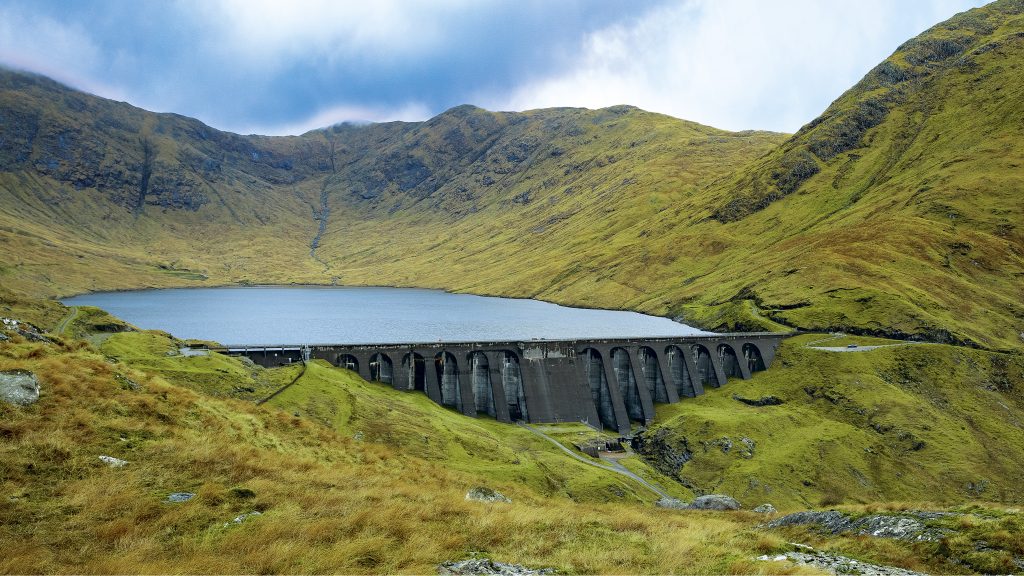
Dam and reservoir, Cruachan Power Station
In December 2018 we completed the acquisition of a portfolio of hydro and gas generation assets from ScottishPower, making Drax the fourth largest electricity generator in the UK and a leading provider of system support services. During 2019 we successfully integrated these assets into our generation portfolio. The assets have performed strongly, with returns significantly ahead of the Group’s cost of capital.
Following weather-restricted production in the first quarter of 2019, our US Pellet Production business produced at full capacity. Our focus remains on the production of good quality and low-cost biomass. Although pellet quality improved in 2019, it was below the level we expect and we are focused on delivering further improvements during 2020.
In our Customers business, which supplies electricity and gas to business customers, we made progress reducing cost, increased the margin per MWh and installed more smart meters year-on-year. However, in a challenging market financial performance was below the level we expect and we have more work to do to realise the opportunities we continue to see in this area. During 2019 we consolidated the management team at Haven Power and Opus Energy into a single integrated team. We expect this new structure to improve operational efficiency.
Results and dividend
Adjusted EBITDA in 2019 of £410 million grew by 64% compared to 2018 (£250 million). This reflects high levels of performance from the hydro and gas generation businesses, as well as continued growth in our Pellet Production business.
At the 2019 half year results we confirmed an interim dividend of £25 million (6.4 pence per share). The Board proposes to pay a final dividend in respect of 2019 of £38 million, equivalent to 9.5 pence per share, making the full year 2019 dividend £63 million (15.9 pence per share) (2018: £56 million, 14.1 pence per share). This represents a 13% increase on 2018 and is consistent with our policy to pay a dividend which is sustainable and expected to grow as the strategy delivers stable earnings, strong cash flows and opportunities for growth.
The Group has a clear capital allocation policy which it has applied throughout 2019. In determining the rate of growth in dividends from one year to the next the Board will take account of contracted cash flows, the less predictable cash flows from the Group’s commodity based business and future investment opportunities. If there is a build-up of capital, the Board will consider the most appropriate mechanism to return this to shareholders.
Governance and values
Sustainability is at the heart of the Group and its culture. It covers the sustainable sourcing of biomass, which is a core principle of the Group, and also long-term sustainability. This means achieving a positive economic, social and environmental impact and considering long, medium and short-term factors in our stewardship of the business.
We are committed to promoting the UN Global Compact principles on respect for human rights, labour rights, the environment and anti-corruption.
Our aim is to maintain an open and collaborative culture across the Group. Setting the right standards helps to protect the business and the interests of our stakeholders. We remain committed to the highest standards of corporate governance, and the Board and its committees play an active role in guiding the Company and leading its strategy.
In 2019 we saw several changes to the Board, including the appointment of Andy Skelton as Chief Financial Officer (CFO).
Andy is highly experienced, having previously served as CFO at Fidessa Group plc.
We greatly value the contribution made by our Non-Executive Directors and during a time of growth their role remains especially important. David Lindsell, Tony Thorne and Tim Cobbold each stepped down, and I would like to thank all three for their very significant contributions to the Board and the stewardship of the business.
John Baxter joined the Board in April 2019 and brings a wealth of industry, engineering and safety management expertise.
Our people
Our people – employees and contractors – remain a key asset of the business and we are focused on creating a diverse and inclusive working environment that is both safe and supportive.
We recognise the importance of listening to employees to understand their concerns and act on them. To that end, in 2019, we established an enhanced programme of workforce engagement to improve communication and feedback between the Board, senior management and our workforce. Together with Will Gardiner, our CEO, I participated in meetings with the chairs of our newly established engagement forums. More information on this can be found on page 28 of the full PDF report.
Safety is a long-held and central commitment of our operational philosophy. While the number of incidents is low, we need to remain vigilant and work to reduce them. We are committed to the highest standards and have continued our efforts to strengthen our approach to health, safety and wellbeing governance across the Group.
To conclude, in 2019 we delivered strong financial performance and made good progress with our strategic objectives. I look forward to building on these in 2020. Through this strategy we will deliver sustainable long-term value, support the communities in which we operate and realise our purpose of enabling a zero carbon, lower cost energy future.
Philip Cox CBE
Chair
Group CEO Review

2019 Highlights
-
Strong growth in Adjusted EBITDA
-
Delivered ahead of target net debt to Adjusted EBITDA ratio, after adjusting for deferred cash receipt of Capacity Market payments
-
Reduction in CO2
-
Reduction in biomass self-supply cost
-
Strong system support performance
-
Completion of private placement and ESG debt facilities
-
Development of Bioenergy Carbon Capture and Storage project
“Our ambition is to become a carbon negative company by 2030.”
Will Gardiner, Group CEO
2019 was an important year for Drax Group. Following the acquisition of the hydro and gas generation assets from ScottishPower in December 2018, we are now the UK’s fourth largest generator, meeting 5% of its power requirements, and generating 12% of the country’s renewable power.
In 2019, we continued to advance our purpose of enabling a zero carbon, lower cost energy future. In December 2019, we announced a world first ambition to become a carbon negative company by 2030, removing more CO2 from the atmosphere than we put into it. We have made significant progress towards that goal, as the carbon emissions from the Group have reduced by over 85% since 2012. We now expect to take this a step further with the end of commercial coal generation in 2021 and the formal closure of the coal units in 2022. For more information on this please see page 118 of the full PDF report.
The safety and wellbeing of our workforce is paramount to the Group. We continue to invest in the systems, governance and training to keep our workforce and assets safe.
Total Recordable Incident Rate (TRIR), a key scorecard measure of safety, was 0.22. This was the same as in 2018 although behind the challenging scorecard target for 2019. Safety remains our priority and as always there is more we can do in our pursuit of zero incidents.
Alongside a good operational performance, we delivered Adjusted EBITDA of £410 million, an increase of 64% on 2018. We propose to pay a dividend in respect of 2019 of £63 million, an increase of 13% on 2018. By the end of 2019, net debt was £841 million, 1.9x net debt to EBITDA, ahead of target of 2.0x, after adjusting for deferred cash receipt of Capacity Market payments of £72 million, received in January 2020.
Purpose and Strategy
Drax’s purpose, to enable a zero carbon, lower cost energy future, sits at the heart of everything we do. We see growing opportunities to create value for shareholders as well as significant benefits for all stakeholders as we deliver that purpose.
2019 saw increasing global recognition of the need for urgent action to tackle climate change by reducing greenhouse gas emissions. The UK Government has taken a lead by putting in place legally binding targets to deliver net zero carbon emissions across the UK economy by 2050. This is an ambitious target which can only be delivered with action and investment now.
We are playing a key role in this transformation. The CO2 emissions at Drax Power Station were less than one million tonnes for the first time, a 97% reduction since 2012, and it is now the UK’s largest source of renewable power generation.
This was achieved through our continued focus on renewable biomass combined with operational excellence and innovative engineering.
While others target net zero, in December 2019, Drax became the first company in the world to announce an ambition to become carbon negative by 2030 – removing CO2 from the atmosphere using Bioenergy with Carbon Capture and Storage (BECCS) to safely capture and store CO2 at scale.
In May 2019 the UK Committee on Climate Change published its pathway for how the UK can deliver net zero carbon emissions by 2050. It highlighted the need for BECCS. Drax is in a leading position to deliver BECCS at scale in the UK and provide as much as a third of the negative emissions the UK will require. We believe we can deliver the engineering solution, but our ambition also requires the right regulatory framework and policy support to underpin an investment decision.
To support that process, in May 2019, we joined with National Grid and Equinor to advocate for a framework to support the development of a carbon cluster in the Humber region, one of the most carbon intensive areas of the UK. This programme is called Zero Carbon Humber.
The Group’s purpose informs the three pillars of our strategy (i) to build a long-term future for biomass, (ii) to be the leading provider of power system stability and (iii) to give our customers control of their energy.
In 2019 we continued to make good progress delivering our purpose and strategy. Through addressing UK energy needs, and those of our customers, our strategy is designed to deliver excellent long-term financial performance across the Group. In doing so we are reducing our historic exposure to commodity markets and delivering higher quality earnings, strong cash generation, increased dividends to shareholders and further opportunities for growth.
A good example of this is the successful integration of a generation portfolio of flexible, low-carbon and renewable hydro and gas generation assets acquired in December 2018. Our expanded asset base has improved the risk profile of the Group and provided more opportunities to deliver system support services to the UK energy market. Our expected EBITDA from these assets was £90-£110 million and they have delivered £114 million of high-quality earnings, with financial returns significantly ahead of the Group’s cost of capital.
As part of our strategy to deliver a long-term future for sustainable biomass, in November 2019, we announced plans to expand our supply chain to self-supply five million tonnes of biomass to our generation business by 2027. In 2019 we self-supplied 1.4 million tonnes. We expect this expansion to be delivered through existing sites, new developments and a wider fuel envelope of sustainable biomass. Through these initiatives we expect to reduce the cost of biomass from around £75/MWh to £50/MWh by 2027, assuming an exchange rate of $1.45/£. This is a level at which we believe renewable electricity from biomass can be economic without the current support mechanisms.
These activities, alongside the development of a biomass trading capability, could enable Drax to develop an unsubsidised biomass generation business by 2027, with the option to service wood pellet demand in Europe, North America and Asia.
Summary of 2019
Overall performance of the Group and its business units is measured as part of our Group Scorecard which covers a combination of financial, environmental, social and governance issues. The Group’s score in 2019 was 0.9, with a score of 1.0 being on target.
Adjusted EBITDA, a key financial KPI, of £410 million represents a 64% increase on 2018. This includes £78 million of Capacity Market income in respect of the whole of 2019 and the last two months of 2018.
Despite challenging weather conditions in early 2019, Pellet Production increased output across the full year from 1.35 million tonnes to 1.40 million tonnes. At the same time, the cost of producing and delivering wood pellets to our port facility at Baton Rouge reduced from $166/tonne in 2018 to $161/tonne in 2019, although challenges remain in terms of pellet quality.
In Generation, the integration and performance of the acquired assets was a success. At Drax Power Station we managed lower levels of biomass availability, which restricted generation in early 2019. By optimising biomass generation under the Renewables Obligation (RO) scheme we were able to partially offset the constraint by producing higher levels of biomass generation later in the year, particularly December, in which we reported record monthly renewable generation. The business also completed a programme of major planned outages across the portfolio.
In our Customers business, which supplies electricity and gas to business customers, we have made progress reducing cost, however performance elsewhere has been below our expectation. This in part reflects a challenging market and we have more work to do to deliver the opportunities we continue to see in this area.
During the year we completed the refinancing of the funding used to acquire the hydro and gas generation assets. These new facilities extend the Group’s debt maturity profile to 2029, incorporating a £125 million Environmental, Social and Governance (ESG) facility with a mechanism that adjusts the interest margin based on Drax’s carbon emissions against an annual benchmark. We believe we are one of the first companies to implement such a feature within its debt, demonstrating our commitment to embedding ESG in financial performance. The Group’s cost of debt is now below 4% and below 3% on the new facilities, reflecting a reduced business risk.
Operational review
In the US, our Pellet Production operations reported Adjusted EBITDA of £32 million up 52% (2018: £21 million).
High levels of rainfall in the US Gulf in early 2019 restricted the level of commercial forest extraction and the availability of low-cost fibre for wood pellet production. This in turn had an impact on the shipment of pellets from the port of Baton Rouge. Since then commercial forestry processes, wood pellet production and shipments to the UK have increased. As a result, wood pellet volumes for 2019 were 1.40 million tonnes, up 4% (2018: 1.35 million tonnes).
Pellet quality, as measured by the amount of fines (larger particle-sized dust) in each cargo, is a KPI for the Group. Lower levels of fines result in fuel that is easier and safer to handle at ports and at Drax Power Station. The quality of the pellets we produced was below our target level in 2019 and we are taking steps to address this issue in 2020.
We have remained focused on opportunities across the supply chain to deliver improved operational performance and cost savings as part of our programme to reduce the cost of biomass to £50/MWh by 2027. We have made good progress with increased volumes, operational improvements and greater utilisation of low-cost fibre which have contributed to lower cost wood pellet production.
A co-location agreement with Hunt Forest Products (a sawmill operator) led to the development of a sawmill next to our LaSalle site. The sawmill commenced production in February 2019 providing greater access to low-cost sawmill residues, lower transportation costs and a reduction in the number of stages in the production process.
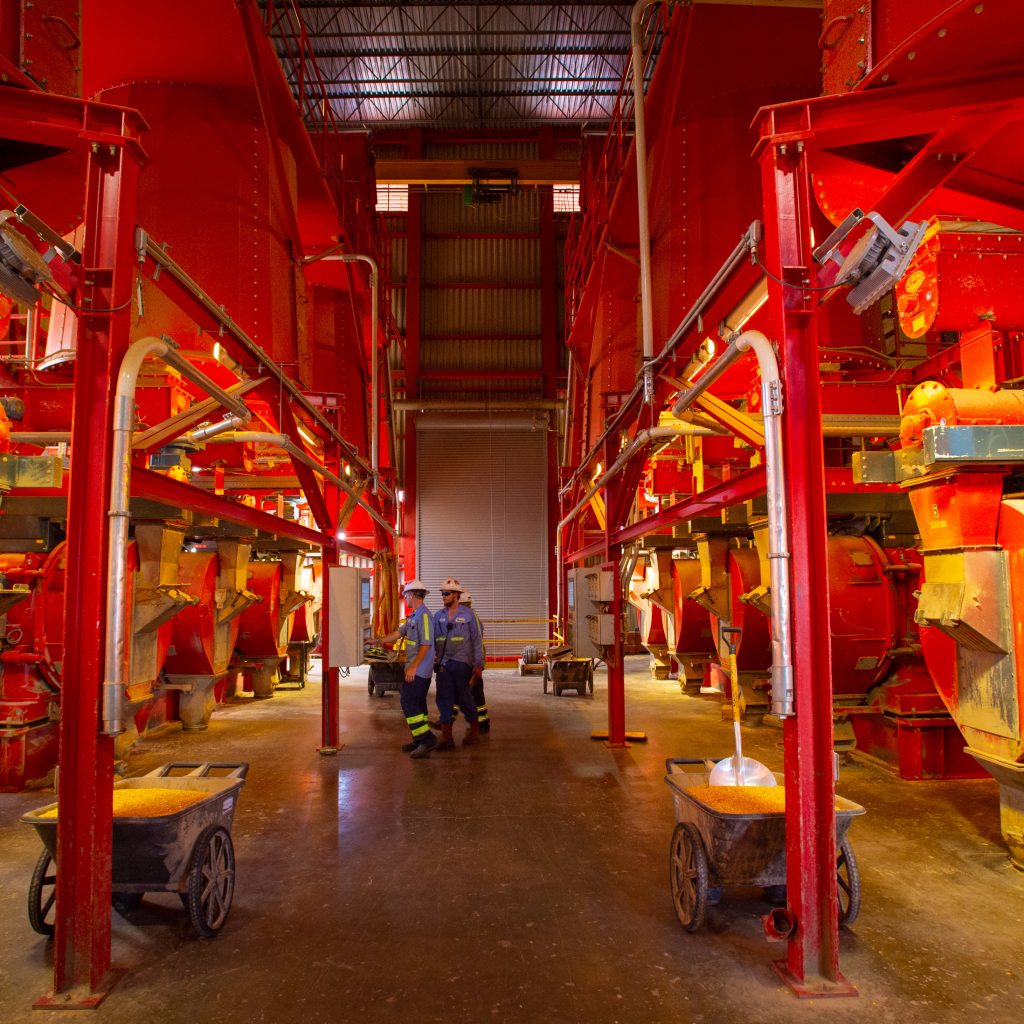
LaSalle pellet plant
A new rail spur linking LaSalle to the regional rail network and our port facility at Baton Rouge was commissioned in May 2019. This will increase transportation efficiency, provide economies of scale and reduce both cost and carbon footprint.
We expect to benefit from further economies of scale in rail associated with the commissioning of an enlarged chambering yard at the port of Baton Rouge in 2020, allowing 80-car train sets to operate from our LaSalle and Morehouse sites.
These initiatives and others have contributed to a year-on-year reduction in cost per tonne of 3%, which represents a saving of $5 per tonne compared to 2018.
We expect to deliver further savings by expanding our existing sites (LaSalle, Morehouse and Amite) by 350,000 tonnes over the next two years – an investment of £50 million. This will expand total capacity to 1.85Mt, provide economies of scale and allow greater utilisation of low-cost residues. We believe these projects offer returns significantly ahead of the Group’s cost of capital, with payback in advance of 2027.
These larger projects are accompanied by small operational improvements such as greater efficiency in the loading of road haulage, saving 50 cents per tonne. Over time these improvements, when applied across the supply chain, can deliver significant incremental savings.
Taking the savings in 2019 together with the other initiatives we have described, we believe there are opportunities to reduce the cost of biomass by $35 per tonne (£13/MWh) on our existing portfolio by 2022. This represents good progress, but more work and investment will be required to deliver our goal of making biomass power generation economically sustainable without subsidy. We expect to do this by using a greater proportion of lower cost wood residues, expanding our self-supply capacity to five million tonnes and exploring ways to expand our fuel envelope to include a wider range of sustainable low-cost biomass residues.
“We have remained focused on opportunities to reduce the cost of biomass to £50/MWh by 2027.”
Will Gardiner, Group CEO
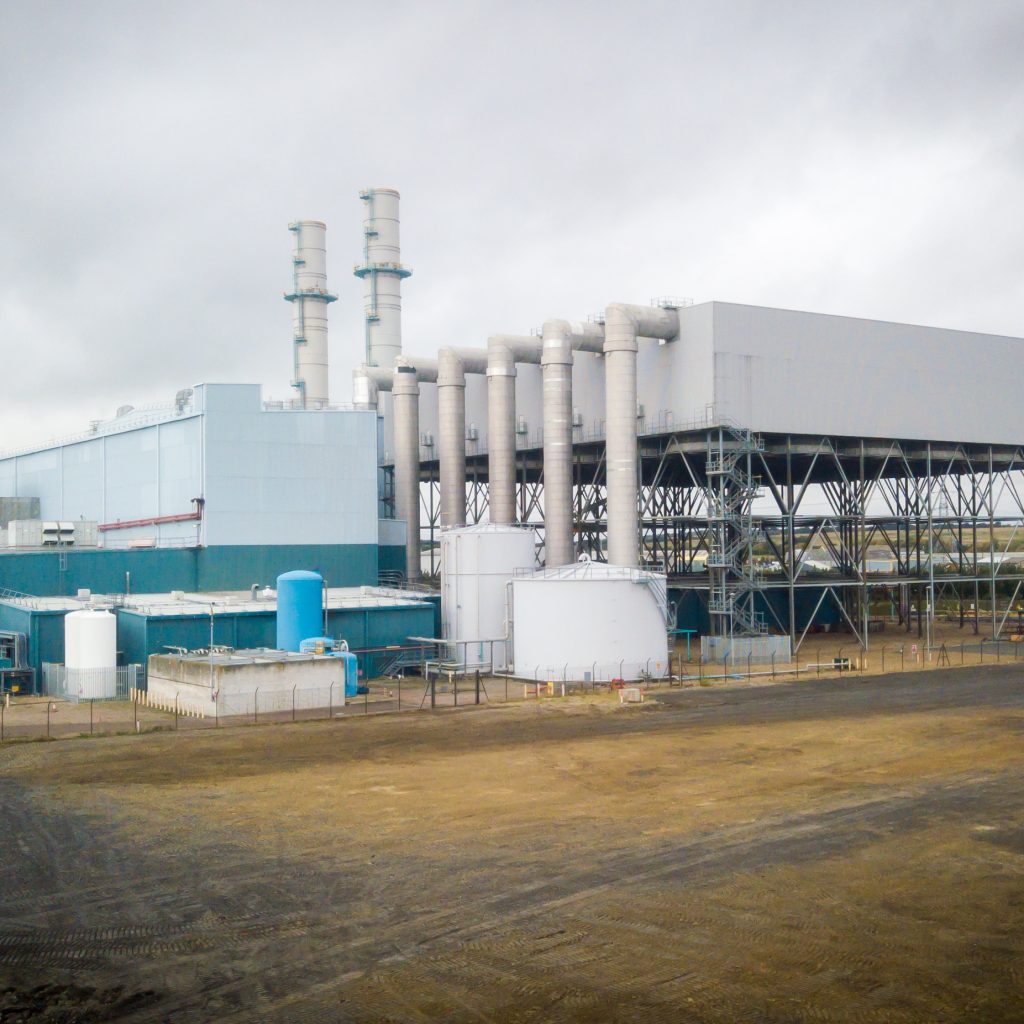
Damhead Creek Power Station
In Generation, Adjusted EBITDA of £408 million was up 76% (2018: £232 million). This includes £114 million from the hydro and gas generation assets acquired in December 2018. These assets have performed strongly, exceeding our financial expectation in the first year of ownership.
Commercial availability, which measures the time we are available to operate in our markets, was 88% (2018: 89%). This was below our target and principally reflects restricted biomass generation in the first quarter of 2019 and gas unit outages.
The engineering challenges associated with such an outage are significant and the completion of the work and recommissioning, which allowed a strong operational performance, is testament to the skill and commitment of our people.
In 2019, we completed two major planned biomass outages, including the first in a series of three high-pressure turbine upgrades which we expect to increase thermal efficiency and reduce the cost of biomass generation.
Notwithstanding these planned outages our biomass units produced 11% of the UK’s renewable electricity – enough to power four million homes. This level of renewable generation, combined with the flexibility of our expanding portfolio, allows the Group to support the continued deployment of intermittent renewables and the UK’s plans for decarbonisation.
Over the last five years the operational experience with biomass generation has been positive and we are now exploring a wider range of sustainable biomass materials. In time we believe that utilisation of this expanded fuel mix will support a reduction in the cost of biomass generation.
Our hydro assets, which include the Cruachan pumped storage power station as well as Lanark and Galloway hydro schemes, have performed strongly, providing flexible, renewable and low carbon electricity. Cruachan Power Station – the largest of these assets (440MW) – plays an important role in the provision of system support services to the UK energy market. Over 80% of Cruachan’s earnings are from non- commodity sources, including Balancing Market activities, Ancillary Services and the Capacity Market.
We operate 2.0GW of Combined Cycle Gas Turbines (CCGT) – Damhead Creek, Shoreham, Rye House and Blackburn. These units produced 2.9TWh, representing around 17% of our total generation. The location of three of the four units in southeast England makes them well placed to provide system support services to the UK energy market.
During the year we completed two planned outages, including turbine repairs and interim inspection work at Shoreham Power Station, providing the option for a future turbine upgrade to take place.
Since the start of 2019 seasonal electricity prices have weakened, reflecting a mild winter and high levels of European gas storage. The market for coal generation has remained challenging and our two coal units continue to focus on short-term power market opportunities during higher demand periods. Coal generation of 0.6TWh represents 4% of the Group’s output.
Where we sold forward volumes on a limited basis, weaker power prices allowed us to buy back some of those volumes at a lower price, adding margin.
The flexibility and dispatchable nature of our generation portfolio is an important source of value and was a key factor in our acquisition of the hydro and gas generation assets. Given the shift towards wind generation, which will provide the majority of the UK’s future electricity requirements, we anticipate a growing need for system support services. In 2019 Value from Flexibility (a scorecard measure of the value from flexible power generation, system support services and attractively priced coal fuels) was £129 million (2018: £79 million), which was ahead of plan, reflecting a 63% increase on 2018.
We believe there is a need for flexible, large-scale dispatchable generation, but this must support the UK’s target of net zero carbon emissions by 2050. To that end we continue to develop options for four 299MW Open Cycle Gas Turbines (OCGTs) and 5.4GW of CCGTs between Damhead Creek and Drax Power Station.
We expect the CCGTs to be among the most efficient assets in their class and hence sit high in the UK merit order, in addition to being available for system support services. The OCGTs will perform a system support role and meet peak power demand at short notice.
An appropriate clearing price in a future Capacity Market will be required to underpin investment in new-build gas. We will remain disciplined through this process and at the most recent auction in January 2020 Drax did not accept a Capacity Market agreement for these projects. We remain committed to developing the most cost-effective capital programmes for all of our gas projects, which we believe can make them competitive in future capacity auctions.
Planning approval for the CCGT at Drax Power Station is subject to a judicial review and we will not participate in future Capacity Market auctions until the outcome is known.
Our Customers business, which focuses on B2B supply, has faced a challenging market environment. Taken together with integration costs, Adjusted EBITDA of £17 million is lower than prior year (2018: £28 million). This includes £8 million of investment in restructuring to integrate the Haven Power and Opus Energy brands under a single operating structure. The creation of a single management team is now complete and will help drive alignment of decision making, effective market segmentation and operational efficiencies.
During the year significant focus was given to cash collection to address historic challenges associated with bad debt at Opus Energy. As a result we have seen further improvements in the management of bad debts during the period, reflected in a reduced charge to the income statement of £18 million (2018: £31 million), whilst maintaining a prudent level of provision.
We have a differentiated market position – selling purely renewable power, helping over 2,000 independent renewable generators access the market and developing products which will meet our customers’ needs. We continue to believe this approach will support long-term growth.
Over time, we expect this business, through efficiency and demand-side response, to contribute increasingly to balancing the power system and we are excited about our opportunity to make a difference in this area.
Biomass sustainability
Under well-established UK and European legislation, sustainably sourced biomass is a renewable source of electricity. The rules and the science which underpins this treatment are clear.
We source low-cost sawmill residues and forest residues, which are a by-product of commercial forestry processes, and thinnings from growing forests, which help improve forest stocks and forest health. The CO2 emissions are absorbed by new forest growth. We use feedstocks that have been shown to have no carbon debt associated with them.
“We maintain a rigorous and robust approach to biomass sustainability.”
Will Gardiner, Group CEO
We maintain a rigorous and robust approach to biomass sustainability, ensuring the wood fibre used and pellets produced are fully compliant with the UK’s mandatory sustainability standards as well as those of the European Union. Since the introduction of the Renewable Obligation Certificate (ROC) scheme in 2002 Drax has maintained full compliance with UK and European legislation.
However, there are carbon emissions associated with the biomass supply chain. Under UK legislation biomass is the only source of electricity generation required to report its supply chain emissions. The Group’s biomass life cycle carbon emissions are 124 kgCO2-eq/MWh of electricity (2018: 131 kgCO2-eq/MWh), less than half the UK Government’s 285 kgCO2-eq/MWh of electricity limit for biomass. This equates to an 87% carbon emission saving against coal, inclusive of biomass supply chain emissions, but excluding those of coal, which means the actual saving from biomass is even greater.
Reflecting this and a lower level of coal generation, reported carbon emissions under the European Union Emissions Trading Scheme fell by 50% to 113tCO2/ GWh (2018: 226tCO2/GWh).
Strengthening our leadership on biomass sustainability, we introduced a new Responsible Sourcing Policy for Biomass and established an Independent Advisory Board, chaired by Sir John Beddington, the UK’s former Chief Scientific Adviser. We responded to the Climate Disclosure Programme’s (CDP) Climate Change and Forests questionnaires.
Environmental, social and governance
The health, safety and wellbeing of our employees and contractors is vital to the success of the Group and remains our priority. We believe that a safe and sustainable business model is critical to our strategy and long-term performance. In 2019 we implemented a new Group- wide approach to health, safety and wellbeing, as well as the establishment of a new Group-wide workforce engagement forum.
In March 2019 we published our second gender pay report. While the data showed that our businesses were in line with the energy sector overall, it highlighted that we still have work to do.
In June 2019, we published our third statement on the prevention of slavery and human trafficking in compliance with the UK Modern Slavery Act (2015) and we are a signatory to the UN Global Compact (UNGC). We are committed to promoting the UNGC principles on respect for human rights, labour rights, the environment and anti-corruption.
Brexit
Brexit remains a key issue for the UK.
To date, the impact on the Group has been limited, with the principal risk being weaker Sterling affecting the cost of biomass, which is generally denominated in US dollars. Through our use of medium- term foreign exchange hedges the Group has protected its position out to 2024 at rates close to those that we saw before the Brexit referendum vote.
Outlook
Our focus remains on progressing our strategy: to build a long-term future for sustainable biomass; to be the leading provider of system stability in the UK and to give customers control of their energy. Through achieving these strategic objectives we expect to deliver tangible financial benefits – long-term earnings growth, strong cash generation and attractive returns for our shareholders.
These activities continue to be underpinned by safety, sustainability and operational excellence.
In Pellet Production we remain focused on the production of good quality pellets at the lowest cost, cross-supply chain optimisation and an expanded self-supply capacity to five million tonnes by 2027.
Our Generation proposition is strong: flexible, renewable and low carbon electricity and system support services. We will continue to provide high levels of renewable electricity to the UK and support increased deployment of intermittent renewables necessary to support the UK’s transition to a net zero carbon economy.
Flexible dispatchable gas has an important long-term role to play in supporting the transition to a net zero carbon economy. We will optimise our portfolio to meet this demand and develop carbon capture and storage ready projects – options which could include hydrogen fuelling – subject to the right price in future capacity auctions.
Our ambition to become a carbon negative company is underpinned by the development of BECCS. Working in partnership, and with the right support from the UK Government, we could develop BECCS at scale before 2030. By reducing our biomass supply chain cost we will support this objective and deliver further attractive returns to shareholders.
In our Customers business we will remain focused on operational excellence, reducing our cost to serve customers, growing gross profit per MWh and managing bad debt. We will offer attractive propositions and develop our presence in the market for system support through flexible demand management and other value-added services.
We are making good progress with the delivery of our strategy and will build on this as we achieve our targets. We will also continue to play an important role in our markets as well as realising our purpose of enabling a zero carbon, lower cost energy future for the UK.
Will Gardiner
Group CEO
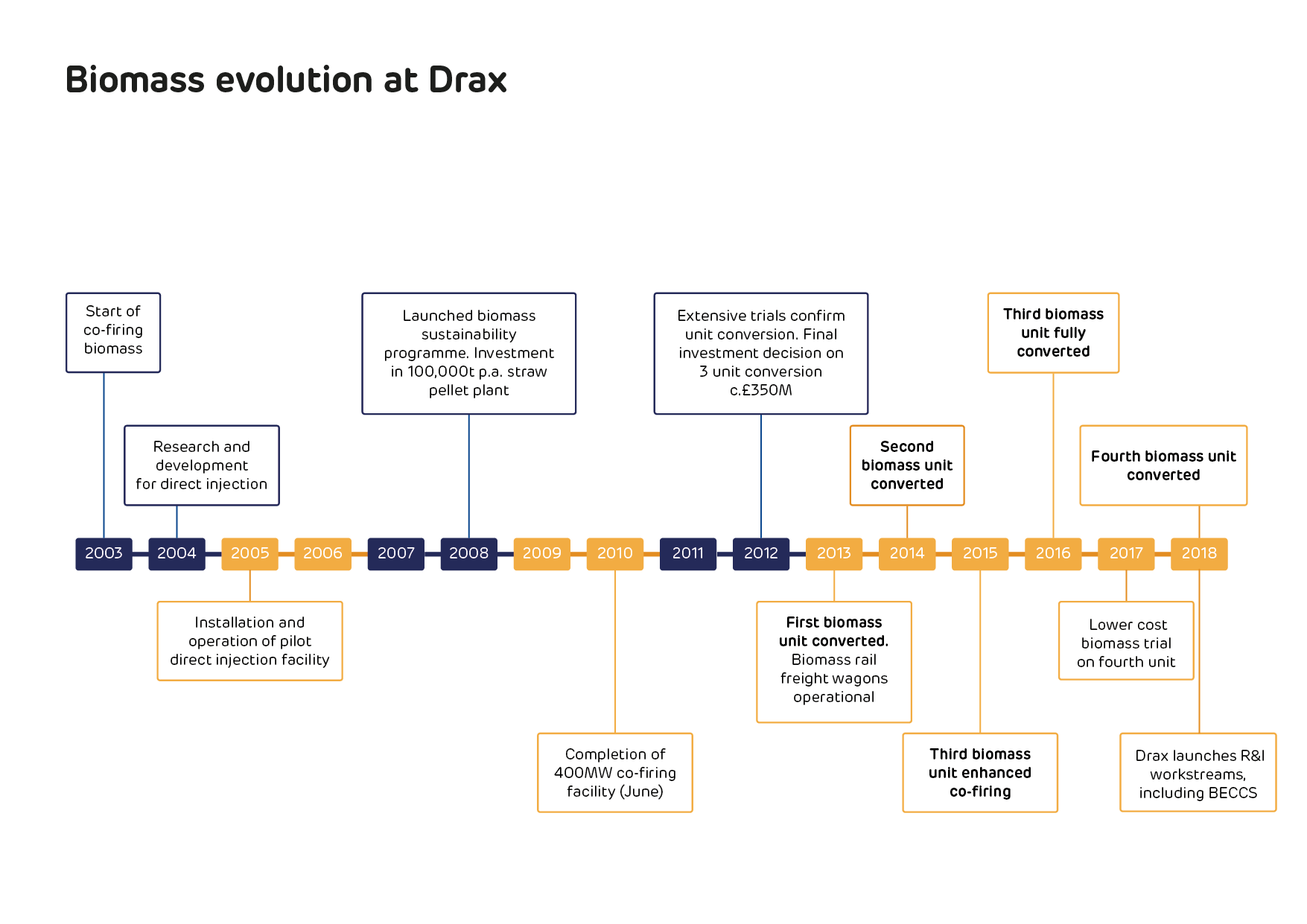
Q&A
How is Drax helping the UK reach its climate goal to be net zero by 2050?
We’re committed to a zero carbon, lower cost energy future and are stepping up our efforts to help the UK become net zero by 2050. We have already successfully converted two thirds of Drax Power Station to run on sustainable biomass instead of coal in what was the largest decarbonisation project in Europe. This means we’re generating 12% of the UK’s renewable electricity and we’ve reduced our carbon emissions by more than 85% since 2012.
We now want to become a carbon negative company by 2030, which we can do by applying carbon capture and storage technology to our biomass units. This is known as BECCS and, through our BECCS pilot project at Drax Power Station, we have the capability to capture one tonne of carbon a day. With the right investment framework and support mechanisms in place, we believe we could capture 16 million tonnes of CO2 a year.
What are negative emissions and why are they important?
Negative emissions mean Drax will be removing more carbon dioxide from the atmosphere than it produces from its operations. The UK needs negative emissions to help offset emissions from sectors that are harder to decarbonise than transport and power, for example aviation and shipping.
Both the UN’s Intergovernmental Panel on Climate Change and the UK’s Committee on Climate Change have said negative emissions with BECCS technology will be critical to limiting global temperature rise to 1.5 degrees.
What impact has the move to biomass had on Drax’s carbon emissions?
Biomass has been a critical element in the UK’s decarbonisation journey, helping the country get off coal much faster than anyone thought possible.
Since 2012, at Drax Power Station we have reduced our carbon emissions by 97%, becoming the largest decarbonisation project in Europe.
And we want to do more.
We’ve also expanded our generation operations to include hydro and gas generation, and we’ve continued to bring coal off the system.
What happens to the forests where Drax sources its biomass?
Sustainable biomass from managed forests is helping to promote healthy forest growth and biodiversity as well as decarbonising the UK’s energy system.
The biomass we use comes from sustainably managed forests that supply industries like construction and furniture. We use residues from forestry and sawmills, like sawdust, that other industries don’t use.
The biomass that we use is renewable because the forests are growing and continue to capture more carbon than we emit from the power station.
Why did you decide to work at Drax?
I want to use all of our capabilities to fight climate change. I also want to make sure that we listen to what everyone else has to say to ensure that we continue to do the right thing. Our people are very engaged on issues relating to climate change and I’m proud of the passion and innovation I see around the business.I took this job because Drax had already made a contribution to the energy transition in the UK. Climate change is the most important challenge we face and I passionately believe Drax has a crucial role in tackling it.
Does building gas power stations mean the UK will be tied into fossil fuels for decades to come?
Our energy system is changing rapidly, as we increase our use of wind and solar energy, but the wind doesn’t always blow and the sun doesn’t always shine, so we need technologies that can operate when needed to fill in those gaps.
We’re looking at a range of options to generate power and support the electricity system as it decarbonises. These include BECCS, hydrogen and gas, which can help enable more renewables to connect to the system.
As I said already, gas is one option we’re looking at but it won’t happen without the right investment conditions. If we do decide to build new natural gas plants, we will make sure that it is ready for carbon capture and storage. We will also look at converting the plants to run on hydrogen.
Chapter 4:
Financial Review
Group Financial Review
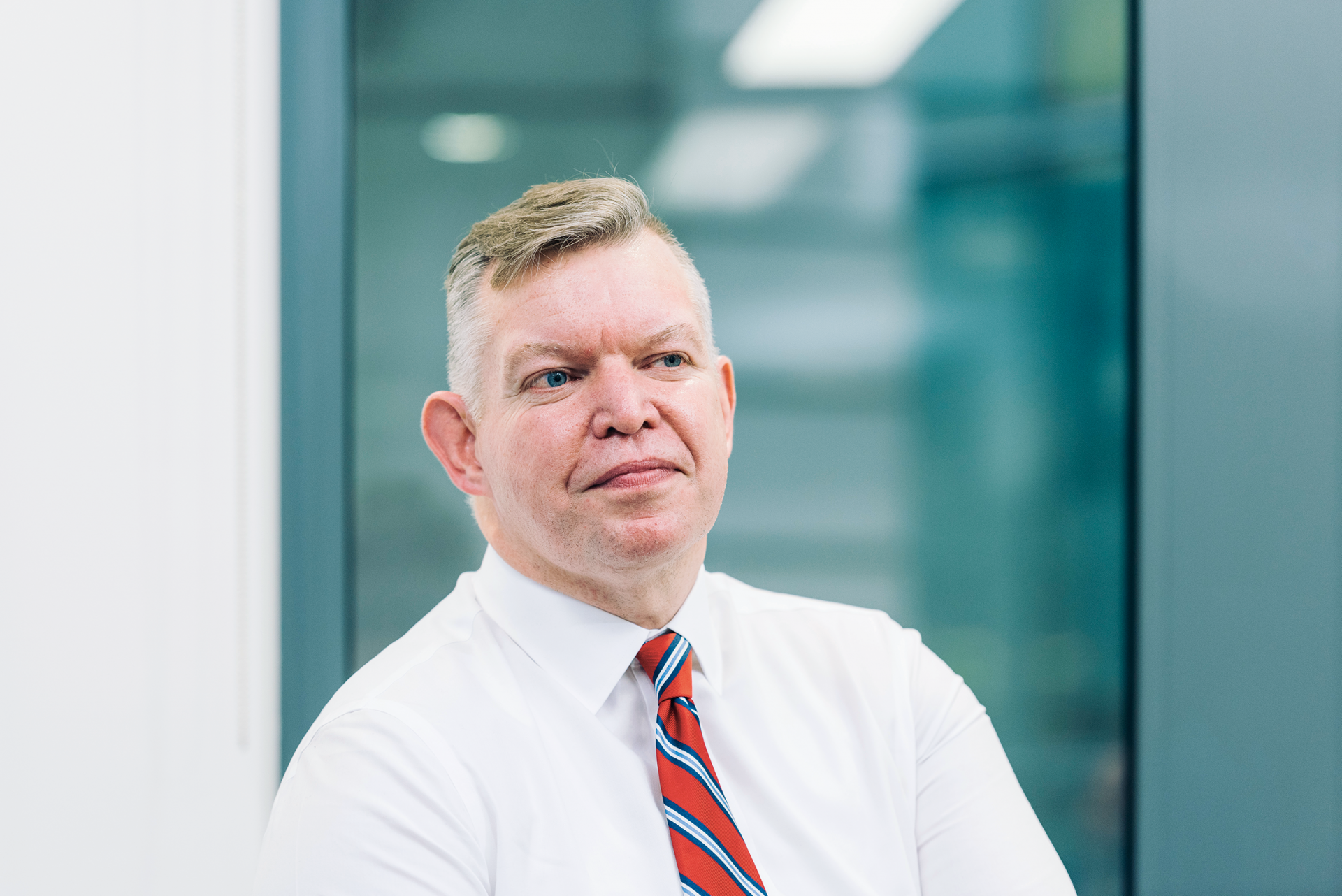
“We’ve delivered 64% growth in Adjusted EBITDA and a Net Debt to Adjusted EBITDA ratio ahead of our target of 2x.”
Andy Skelton, Chief Financial Officer
2019 Highlights
-
64% Adjusted EBITDA growth to £410 million
-
Delivered net debt to Adjusted EBITDA ratio ahead of target of 2x, after adjusting for deferred cash receipt of Capacity Market payments of £72 million, received in January 2020
-
Strong performance of acquired generation assets with Adjusted EBITDA of £114 million
-
Significant increase in Adjusted profit after tax to £118 million resulting in improved Adjusted earnings per share of 30 pence
-
Total operating profit of £62 million, increased from £60 million
-
Net cash flow from operating activities of £413 million, compared to £311 million in 2018
-
13% increase in dividend to £63 million or 9 pence per share
Introduction
The Group has delivered significant growth during 2019, with Adjusted EBITDA increasing by 64% from £250 million in 2018, to £410 million.
Total operating profit, which includes the effect of remeasurement losses of £133 million (2018: remeasurement gains of £38 million) on derivative contracts, also increased from £60 million in 2018 to £62 million.
Our new portfolio of pumped storage, hydro and gas generation assets (hereafter referred to as the “new generation assets”), acquired on 31 December 2018, delivered Adjusted EBITDA of £114 million. Growth was further supported by an increased contribution from renewable power generation from sustainable biomass at Drax Power Station and our Pellet Production business.
This performance is particularly pleasing when considering the challenges we faced in the first half of the year where both our pellet production operations and biomass generation were impacted by lower levels of biomass supply as a result of historically bad weather conditions in the US Gulf.
Following the reinstatement of the UK Capacity Market in October 2019, the results for the year include £78 million of capacity market income, including £7 million for the period in 2018 after its suspension.

The associated cash was subsequently received after the year end and does not form part of our reported net debt at 31 December 2019.
The Group improved its access to capital during 2019. We refinanced the acquisition bridge facility, used to part-fund the acquisition in December 2018 of the new generation assets from ScottishPower, in three stages.

In May, we issued an additional US$200 million of the existing 2025 6.625% loan notes. In July, we entered into two new senior debt facility agreements, a £375 million private placement and a £125 million environmental, social and governance (ESG) facility. The average rate of the two new facilities is below 3%, reducing the Group’s overall cost of debt to below 4%, reflecting a reduced business risk profile.
Driven by strong cash generation in the period, supported by active management of working capital, net debt at 31 December 2019 was £841 million (2018: £319 million), delivering a net debt to Adjusted EBITDA ratio of 1.9x, ahead of our target of 2.0x for the year end after adjusting for the deferred receipt of £72 million cash in respect of Capacity Market payments received in January 2020.
We remain committed to a sustainable and growing dividend. The Board will recommend at the forthcoming Annual General Meeting a final dividend that takes total dividends for the financial year to £63 million, or 15.9 pence per share, an increase of £7 million or 1.8 pence per share when compared to 2018.
Financial Performance
Adjusted EBITDA
Group consolidated Adjusted EBITDA of £410 million includes a contribution of £114 million from our new generation assets, acquired at the end of 2018.
This is an excellent result and exceeds our forecast range of £90-£110 million, reflecting strong operational performance across the portfolio, better than expected performance in ancillary and balancing services and excellent progress with the integration of the assets into our existing generation business, which is now complete.
In total, the Generation business contributed Adjusted EBITDA of £408 million (2018: £232 million), an increase of £176 million or 76%. This performance comes despite industry- wide challenges with wood pellet production and associated supply constraints in the first half of the year, and includes the contribution of £114 million from our new generation assets, described above.
Following the reinstatement of the Capacity Market in October 2019, we have recognised related income totalling £78 million across the Generation portfolio. Our financial results for 2018 excluded £7 million of capacity market income following its suspension in October 2018, and this amount has now been recognised in 2019.
Total output at Drax Power Station reduced, as we continue our transition away from coal; however, our biomass units delivered output broadly in line with 2018, of 13.4TWh (2018: 13.7 TWh).
The small reduction in part reflected an outage over the summer period on Unit 1, which is supported by the Contract for Difference (CfD) regime.
Despite lower CfD generation, overall renewable support under the CfD and ROC regimes remained broadly in line with the prior period, due to higher ROC generation and indexation of support payments.
Overall captured spreads improved following efficiency gains as a result of our programme of investment in the performance of generating units at Drax Power Station and benefits from our trading position and portfolio.
We continue to derive value from flexibility (balancing mechanism, ancillary services and advantaged fuels), which improved from £79 million in the prior year to £129 million in 2019, an increase of 63%. Our new hydro and pumped storage assets performed particularly strongly in this area, a demonstration of the contribution of the acquisition to our strategy to become the leading provider of system stability in the UK.
The Generation business acquires biomass pellets predominantly in US dollars, which we actively hedge over a rolling five-year period, to manage our foreign currency exposure to a weaker pound. The renewable support (CfD and ROCs) received in respect of biomass generation are subject to UK inflation indices. This exposure is managed as part of our active long-term financial derivatives hedging programme.
We hold a large portfolio of forward and option contracts for various commodities and financial products, the nature, value and purpose of which is described in note 7.2 to the consolidated financial statements. These contracts are held to de-risk the business, by protecting the sterling value of future cash flows in relation to the sale of power or purchase of key commodities. We manage our exposures in accordance with our trading and risk management policies.
From time to time, for example where market conditions or our trading expectations change, action may be needed in accordance with these policies to rebalance our portfolio. This year such activity included restructuring in-the- money foreign currency exchange contracts, to balance short and long periods across the duration of the hedge. During 2019 we also realised value from closing out positions as expectations for coal generation reduced, the benefit of which is included in value from flexibility, above. The financial impact of these activities – which is driven by market prices at the point of execution – is recognised in the cost of sales of our Generation business and therefore is reflected in our Adjusted Gross profit and Adjusted EBITDA.
Our Customers business contributed Adjusted EBITDA of £17 million in 2019, an £11 million reduction when compared to 2018.
The 2019 result for Customers includes £8 million of investment cost in the restructuring of the business, to more closely integrate our two brands and bring them under one management team (In 2018, £3 million of restructuring and integration costs were treated as exceptional and excluded from Adjusted results in the first year post-acquisition of Opus Energy), and a further £7 million for the development of next-generation IT systems (2018: £6 million).
We delivered the new ERP system at Opus Energy during the second half of 2019 but have stopped the implementation of a new billing system and are in ongoing discussions with the supplier. We have incurred approximately £19 million of costs to date, held on the balance sheet, which we believe have value and will be recovered.
Overall volumes sold were down by 9% compared to 2018, which largely reflects a mild 2018/19 winter that led to a challenging first half of the year.
As a result, overall gross profit fell from £143 million in 2018 to £134 million in 2019.
During the year, significant attention was focused on improving cash collections, where we have seen a positive performance. As a result of this, in addition to a £6 million benefit in respect of resolution of legacy credit balances, bad debt charges reduced from £31 million in 2018 to £18 million in 2019. The higher charge in the prior year reflected an increased level of provisioning required due to reduced collection performance, plus a £3 million one-off expense in respect of SME business. The closing provision at 31 December 2019 of £41 million is slightly lower than the prior year (2018: £44 million), reflecting the improved performance during the year.
Pellet Production Adjusted EBITDA of £32 million increased 52% from £21 million in 2018.
Facilities at Drax Biomass include the LaSalle pellet plant and tree nursery at Weyerhaeuser
Production in the year increased slightly to 1,406kt (2018: 1,351kt), reflecting a full year of operations at the LaSalle pellet plant. This would have been higher but for challenging weather conditions in the first quarter, resulting from unseasonably high rainfall and associated high river levels, which materially restricted output at all three of our pellet plants and caused difficulties in loading ships at the port.
We have made good progress with biomass cost reduction projects in the year, with the average cost per gigajoule of our self-supplied pellets falling to US$161/tonne in 2019 compared to US$166/tonne in the prior year.
Key contributions to this saving came from the benefit of a full year of lower operational costs as a result of the headquarters relocation from Atlanta to Monroe during 2018 and the rail spur project at our LaSalle plant, commissioned in early May 2019, saving transport costs across the rest of 2019 with a positive impact on supply chain emissions. Furthermore, the sawmill co-location project at the same plant has delivered further savings.
The total savings from these projects delivered in 2019 was £14 million, which more than offset the weather impact described above.
Central and other costs of £46 million have increased by £18 million in 2019.
This increase includes incremental research and innovation costs associated with key strategic initiatives – including those relating to Bio-Energy Carbon Capture and Storage (BECCS).
As we described at the half year, and in connection with the integration of the acquired generation assets; we incurred one-off costs implementing a new organisational structure that we believe will enable us to execute our strategy more effectively. Costs associated with delivering working capital initiatives have also increased.
Total Operating Profit
Total operating profit of £62 million has increased 3% from £60 million in 2018. This includes the effect of acquisition and restructuring costs and remeasurement gains and losses on derivative contracts that are excluded from Adjusted results. Our policy and approach to calculating Adjusted results is set out on page 131 of the full PDF report.
Acquisition and restructuring related costs of £9 million (2018: £28 million) reflect the first-year costs of integrating the new generation assets into our existing Generation business, following transaction costs associated with the acquisition last year. The integration is now complete, and in line with our policy no further acquisition and restructuring costs in relation to the acquired assets will be excluded from Adjusted EBITDA in 2020.
Net fair value remeasurement losses on derivative contracts included in operating profit were £131 million (2018: gains of £38 million) reflecting movements in the mark-to-market position on our portfolio of commodity and financial derivative contracts, to the extent they do not qualify for hedge accounting.
The losses in 2019 are predominantly the result of the strengthening of sterling in the period and the resulting impact on the value of our extensive portfolio of foreign currency exchange contracts, which provide a rolling five-year hedge against changes in exchange rates for fuel purchases denominated in foreign currencies.

Profit After Tax and Earnings per Share Adjusted profit after tax of £118 million compares to £42 million for the prior year, resulting in Adjusted earnings per share (EPS) of 30 pence (2018: 10 pence) which represents a 200% increase.
Improvements in Adjusted profit after tax and EPS largely reflect the growth in Adjusted EBITDA described above, although this has been partially offset by higher depreciation charges resulting from the new generation assets, and an increase in interest charges as a result of the new debt issued to part-fund the acquisition, as described in further detail below.
Total profit after tax of £1 million is lower than £20 million for last year, with a corresponding reduction in Total EPS from 5 pence in 2018 to nil pence in 2019.
Total profit after tax reflects exceptional items and certain remeasurements, including the derivative remeasurements and acquisition and restructuring costs described above. In addition, it includes a further £5 million of interest charges relating to the acquisition bridge facility. These costs have been treated as exceptional given the direct link to the acquisition and their one-off nature (2018: £7 million).
The total tax credit of £3 million (2018: £6 million) reflects an effective tax rate that is lower than the standard rate of tax in the UK. This principally reflects the benefit of patent box tax credits in respect of biomass research and development expenditure. Total patent box credits included in the overall tax credit for 2019 are £8 million (2018: £8 million).
Cash taxes paid during the year were £9 million (2018: £1 million).
Capital Expenditure
We maintain a disciplined approach to capital expenditure, with all significant projects subject to appraisal and prioritisation by a Capital Committee prior to approval, overall ensuring adherence to our capital allocation policy and maintenance of an appropriate net leverage profile.
Total capital expenditure of £172 million in 2019 was higher than £114 million in the prior year.
The increase principally reflects additional expenditure in respect of the new generation assets, strategic projects and investments to progress our objective of increasing self-supply of pellets to 5 million tonnes and reduce the cost of pellets.
We have made an initial investment in biomass expansion projects in the Pellet Production business, ahead of full delivery in 2020, in line with our strategy to expand self-supply. We have also continued investment in our gas development projects – our four OCGT sites, a new CCGT at Drax Power Station and the expansion option at Damhead Creek.
Cash and Net Debt
At 31 December 2019, total borrowings were £1,245 million (2018: £608 million) and net debt was £841 million (2018: £319 million).
Following the reinstatement of the Capacity Market in October, we accrued the £78 million of associated income in full; however, the cash payments were not received until after the year end.
After adjusting for the receipt of £72 million of cash in January 2020 in respect of Capacity Market payments, covering the standstill period, this reflects a net debt to EBITDA ratio for 2019 of 1.9x (2018: 1.3x), within our target of less than 2x. Without adjusting year end net debt for this payment our closing net debt to EBITDA ratio was 2.1x.
The increase in borrowings and net debt in 2019 reflects the additional debt drawn to part-fund the acquisition of the new generation assets, for which the cash consideration was settled in January 2019.
Taking this into account, and allowing for a full year of EBITDA from the new generation assets in 2018, this represents a significant deleveraging on a like-for- like basis from a net debt to EBITDA ratio of 3.1x.
On 2 January 2019, the Group drew down £550 million from the £725 million acquisition bridge facility to partially fund the acquisition, with the remainder of the consideration funded from the Group’s cash resources. At inception, the acquisition bridge facility was due to mature in the second half of 2020.
During 2019, we refinanced the acquisition bridge facility in three stages, including two new long-term debt facilities.
On 16 May 2019, we issued an additional US $200 million of the existing 2025 6.625% US dollar loan notes. The proceeds from the issuance were used to repay £150 million of the drawn down acquisition bridge facility. Reflecting the strong investor appetite, the notes were issued at 101.5% of their face value which, when swapped back into sterling, achieved an interest rate of 4.74%.
On 24 July 2019, we entered into two new senior debt facilities agreements, a £375 million private placement with infrastructure lenders with maturities between 2024 and 2029, and a £125 million ESG facility agreement that matures in 2022. The ESG facility includes a mechanism that adjusts the margin based on carbon emissions against an annual benchmark.
Together these new facilities extend the Group’s debt maturity profile beyond 2027 and reduce the Group’s overall cost of debt to below 4%.
A full reconciliation of the Group’s borrowings in the period is provided in note 4.3 to the consolidated financial statements.
The Group continued to generate strong cash from operating activities in 2019, with a total inflow of £413 million in 2019 (2018: £311 million). The increase principally reflects improved profitability, the contribution from newly acquired generation assets and a disciplined approach to working capital, partially offset by increased interest payments on the expanded debt portfolio.
In addition to the improvements in operating performance described above, the Group has a strong focus on cash flow discipline. We also use various methods to manage liquidity through the business’ cash generation cycle.
The Group has access to a £315 million revolving credit facility, which can be used to manage low points in the cash cycle, which expires in 2021. No cash was drawn under this facility at 31 December 2019 (2018: £nil). We actively optimise our working capital position by managing payables, receivables and inventories to ensure that the working capital committed is closely aligned with operational requirements.
The key working capital benefits in 2019, in terms of cash flow, arise from making sales and purchases of ROC assets and rebasing foreign currency exchange contracts.
Historically, cash from ROCs has typically been realised several months after the ROC was earned at the end of the ROC compliance period; however, the Group is able to limit the overall impact of ROCs on working capital by making separate sales and purchases in the compliance period.
For 2019, such transactions generated a net cash inflow of £131 million and supported an overall working capital inflow from ROCs of £54 million. The Group also has access to facilities enabling it to sell ROC trade receivables arising on a non-recourse basis. These facilities were not utilised at 31 December 2019 (2018: £nil).

During 2019 the Group rebased several foreign currency contracts, which resulted in a working capital benefit. The total cash released from related trades still outstanding at the end of the year was £84 million (2018: £3 million) reflected in cash generated from operations. By undertaking a similar exercise on cross-currency swaps, we released a further cash benefit of £23 million (2018: £nil). This has no impact on Adjusted EBITDA, the gains are held on the Group’s balance sheet, until the rebased trades expire.
In addition, the Group has access to a £200 million receivables monetisation facility (extended from £150 million in 2018), which accelerates associated cash flows and mitigates exposure to credit risk, and a number of payment facilities to leverage scale and efficiencies in transaction processing. We also facilitate a supply chain financing scheme, which enables certain suppliers to access payment earlier than contractually agreed payment terms and supports the wider working capital efficiency of the Group. The balances outstanding at 31 December 2019 and change in utilisation in respect of each of these facilities is set out in note 4.4 to the consolidated financial statements.
The overall net cash inflow for the year was £122 million (2018: £66 million), after cash payments for capital expenditure of £171 million (2018: £104 million), dividend payments of £59 million (2018: £53 million), net proceeds from new borrowings of £653 million (2018: net repayment of £5 million) and payments in respect of acquisitions of £692 million (2018: £nil).
Distributions
We have a long-standing capital allocation policy – a commitment to robust financial metrics that underpins our strong credit rating, invest in our core business, pay a sustainable and growing dividend and return surplus capital to shareholders as appropriate.
At the Annual General Meeting on 17 April 2019, shareholders approved payment of a final dividend for the year ended 31 December 2018 of 8.5 pence per share (£34 million). The final dividend was paid on 10 May 2019.
On 23 July 2019, the Board resolved to pay an interim dividend for the six months ended 30 June 2019 of 6.4 pence per share (£25 million), representing 40% of the expected full year dividend. The interim dividend was paid on 11 October 2019.
At the forthcoming Annual General Meeting, on 22 April 2020, the Board will recommend to shareholders that a resolution is passed to approve payment of a final dividend for the year ended 31 December 2019 of 9.5 pence per share (£38 million), payable on or before 10 May 2020. Shares will be marked ex-dividend on 23 April 2020. This brings the total dividend payable for 2019 to £63 million and delivers 13% growth on 2018.
The Group’s £50 million share buy-back scheme, which commenced in April 2018, concluded in January 2019. In total, 13.8 million shares were repurchased and are now held in treasury.
Other Information
New Accounting Standards
The impact of adopting IFRS 16 during the financial year – the new accounting standard for leases – is set out in note 8.3 to the consolidated financial statements. On transition, the Group elected to use the practical expedient available, allowing the standard to only be applied to those contracts identified as leases under the previous standards. As a result, adoption of IFRS 16 has not resulted in any retrospective changes to amounts recognised in the Group’s annual consolidated financial statements for the year ended 31 December 2018.
Adoption of IFRS 16 has resulted in a reduction of operating costs in 2019 of £7.4 million, with the costs of leases now reflected as depreciation and interest charges.
Had the standard been applied in 2018, the equivalent reduction in operating costs for the year ended 31 December 2018 would have been £6.3 million.
Restatement of Comparative Financial Information
The Group consolidated financial statements (see page 133 of the full PDF report), include comparative information for the year ending 31 December 2018.
The 2018 comparatives have been restated, from those originally published, in respect of the following items:
- Finalisation of the opening values of assets and liabilities acquired in respect of the acquisition of the new generation assets on 31 December 2018. During 2019, we concluded a completion statement process and identified adjustments to fixed asset values totalling £4 million. The net effect of these changes was a £5 million increase in consideration payable and a £3 million reduction in goodwill. See note 5.1 to the financial statements.
- Correction of an historical error identified in respect of translation of fixed assets in our US-based business into the consolidated group financial Application of the correct foreign exchange rates resulted in an increase in fixed asset carrying values at 1 January and 31 December 2018 of £34 million and £56 million respectively, with an equivalent amount recognised in the translation reserve. The correction has no impact on previously reported profit or cash amounts.
Andy Skelton
Chief Financial Officer
Remuneration At A Glance
A new Remuneration Policy which aligns with our purpose of enabling a zero carbon, lower cost energy future and rewards sustainable long-term performance
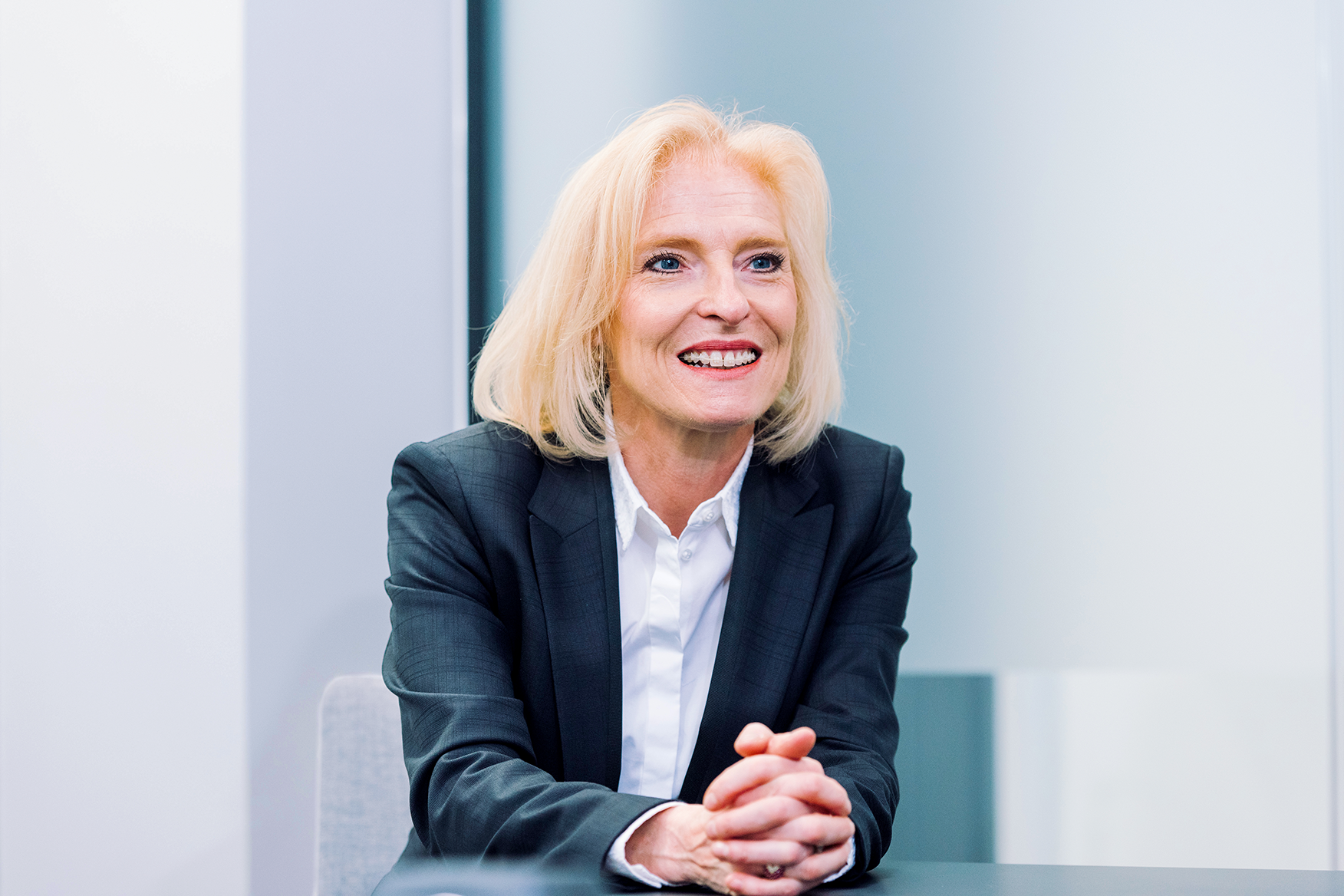
“The Committee has undertaken a full review of the policy, taking into account shareholder feedback.”
Nicola Hodson, Remuneration Committee Chair
Drax has continued to evolve since the last full review of the Directors’ Remuneration Policy (the policy). The Group has a broader position in the energy market following the biomass conversion programme and the acquisitions in the Customers business and, more recently, in Generation with the successful integration of the hydro, pumped storage and gas assets.
To ensure that our approach to remuneration supports the strategy, the Remuneration Committee has undertaken a full review of the policy, taking into account the Group’s strategy, shareholder feedback and the new provisions in the Corporate Governance Code.
Our principal aims are to ensure that executive pay is closely linked to Group performance, underpins our purpose of enabling a zero-carbon, lower cost energy future; better aligns reward with delivering the strategy; incorporates targets that reflect the Group’s progress, and are relevant and transparent for the wider workforce and our shareholders.
The proposed new policy is designed to support delivery of our core business against a smaller number of stretching annual financial, operational and strategic targets, rewarding the delivery of growth, innovation and sustainability over the long term.
The proposed new remuneration structure is simplified, with annual bonus payments linked to these goals – a decision informed by engagement with shareholders.
In the long-term incentive, Total Shareholder Return (TSR) will be retained but the Group scorecard will be replaced with cumulative adjusted EPS. We feel this change will help to drive further shareholder value over the medium to longer term.
Attracting and retaining the right talent capable of delivering high quality business performance and growth is critical in achieving our strategy.
We believe the new long-term incentive, focused on rewarding stretching performance, and with extended holding requirements will enable this.
I have met a number of our major shareholders and have incorporated their feedback. I welcome further feedback on the proposed policy.

Chapter 5:
Market Context, Working With Stakeholders & Biomass Cost Reduction
Decarbonisation, electrification and flexibility
Globally the energy market in 2019 was marked by geopolitical tension, commodity prices which varied within a relatively stable range and, most importantly, rising awareness of climate change and its implications. The UK energy market is increasingly shaped by three major trends: the pace of decarbonisation of the sector is increasing; the need for electrification and more electricity is growing as the heat and transport sectors decarbonise; and the need for flexible sources of power is greater than ever.
Decarbonisation – In July 2019 the UK Government passed legislation requiring the UK economy to be net zero carbon by 2050. Tackling climate change is high in the public consciousness and widespread engagement and activism suggests that the UK public increasingly expects the Government and industry to work together to provide solutions. To date the power sector has led the way in the UK’s efforts to decarbonise, and we believe it will have an even greater role in helping to realise net zero. In fact, to hit net zero by 2050, including the hard to decarbonise sectors such as aviation and agriculture, we envisage that the power sector will have to contribute negative emissions to the overall carbon balance.
Electrification – Decarbonisation on the scale outlined above is likely to require an absolute increase in the amount of electricity produced and consumed due to the electrification of heating and transport.
The UK Government has signalled a commitment to end diesel and petrol car sales by the middle of the next decade, which is expected to increase the number of electric vehicles on the road and further add to the demand for electrification. Furthermore, a report from the Energy Transitions Commission (November 2018) estimated that electricity’s contribution to global energy supply must rise from 20% to 60% by 2060.
Flexibility – Renewable power generation, driven by wind and solar, is increasing and is expected to provide over 80% of power by 2050. Delivered by smaller, more widely distributed, sources of generation this will mean the UK power grid will need to manage more volatility, and energy customers will increasingly need more control over the way they use or generate their own energy. The need for more flexible generation was thrown into sharp relief by the power supply issues on 9 August 2019 which saw over one million people go without power when 1.9GW of power failed in a short period of time.
On the next page we explore three aspects of Drax’s response to changes in the energy market in more detail.
Towards a net zero carbon future
Hitting net zero and limiting average temperature rises to less than 1.5 degrees Celsius will require huge investment.
1. Meeting the net zero by 2050 target
The precise path to achieve this goal is not yet certain for all sectors but it is becoming increasingly clear that carbon removal technologies and negative emissions will have a significant role to play. Organisations such as the International Panel on Climate Change and the UK’s Committee on Climate Change agree that carbon capture technologies, in particular those which could lead to the removal of carbon from the atmosphere, will be important.
Our response
In 2019 Drax produced 13.7 TWh of renewable power and we have reduced our carbon footprint by over 85% since 2012. Coal accounted for only 4% of Drax’s generation in 2019. In December 2019 we announced an ambition to become a carbon negative company by 2030. This means by 2030 Drax would be removing more carbon dioxide from the atmosphere than we are emitting.
2. Evolving mix of generation
The use of intermittent renewables, such as wind and solar, continues to increase. Flexible, thermal generation, such as coal and older gas plant generation continues to decline. This places additional pressure to balance the energy system. More distributed generation and the increase in intermittent renewables are driving increased levels of volatility in short-term prices and a need for assets to provide system support services. There is an increasing need for flexible sources of power which can provide services such as response, reserve, reactive power, black start and inertia.
Our response
Drax’s portfolio of flexible generation assets (biomass, hydro and gas) provide these increasingly important balancing services. Drax now has generation assets with a capacity of 6.5GW distributed across Scotland, northern and south east England, and options to develop generation assets in Wales and the East of England.
Drax saw a 63% increase in the value derived from flexibility in 2019 compared to 2018.
3. Changing customer behaviours and expectations
The business-to-business energy market is highly competitive and customers demand access to both low cost and renewable power. Customers want more control of their energy in order to manage both cost and their environmental impact. Energy suppliers therefore need to provide the services which customers need. Our business customers increasingly seek to create value from their portfolios through the installation of their own generation capabilities, the provision of demand side response and energy trading.
Our response
Drax is now the third largest supplier of energy to businesses and supplies more of its customers with 100% renewable power than any of its competitors.
Our investment in digital technologies is providing new opportunities, a reduced cost to serve and an enhanced customer experience.
In 2019 Drax launched a partnership with SES Water to provide an end-to-end electric vehicle offer, and a new partnership with Eaton allowed Drax to install batteries as an energy service on our customers’ property. Services like this mean Drax can open up power and flexibility markets to more of our customers and ultimately generate value for both us and our customers through our trading expertise.
See more online at www.drax.com/uk and more details about trends in the electricity sector at www.electricinsights.co.uk
Working with our stakeholders
Engaging with our stakeholders is fundamental to our success. We recognise that we need to listen to, and work with, a diverse range of interested parties to achieve our purpose: to enable a zero carbon, lower cost energy future. In this section, we explain how we have identified our stakeholders and engaged with them to inform the way we operated our business in 2019.
Stakeholder relations
High quality engagement with the full breadth of our stakeholders is key to well-informed decision-making that pays appropriate regard to stakeholder views.
Drax has a wide range of stakeholders and takes care to ensure that the Group, and the Board, has an effective strategy to identify and engage with those stakeholders.
We have a comprehensive stakeholder engagement strategy. This is detailed in the Communications Strategy, which is presented to the Board at least annually and sets out our stakeholders and provides oversight of how the Group intends to engage with them.
Engagement with stakeholders informs both our day-to-day decision making, that ensures the smooth running of the business, and the strategic decisions which help set our direction for the years and decades to come.
Drax employs dedicated teams to engage both proactively and reactively with particular stakeholder groups.
This includes a stakeholder relations team, an investor relations team, an internal relations team, a sustainable business team, a business ethics team, a media relations team and a digital engagement team.
Methods of engagement with stakeholders vary according to the issue at hand and the stakeholder concerned. The table on page 25 of the full PDF report sets out the broad stakeholder groups that we identified and engaged with during 2019. It also highlights why we engaged, how we engaged and the areas of focus.
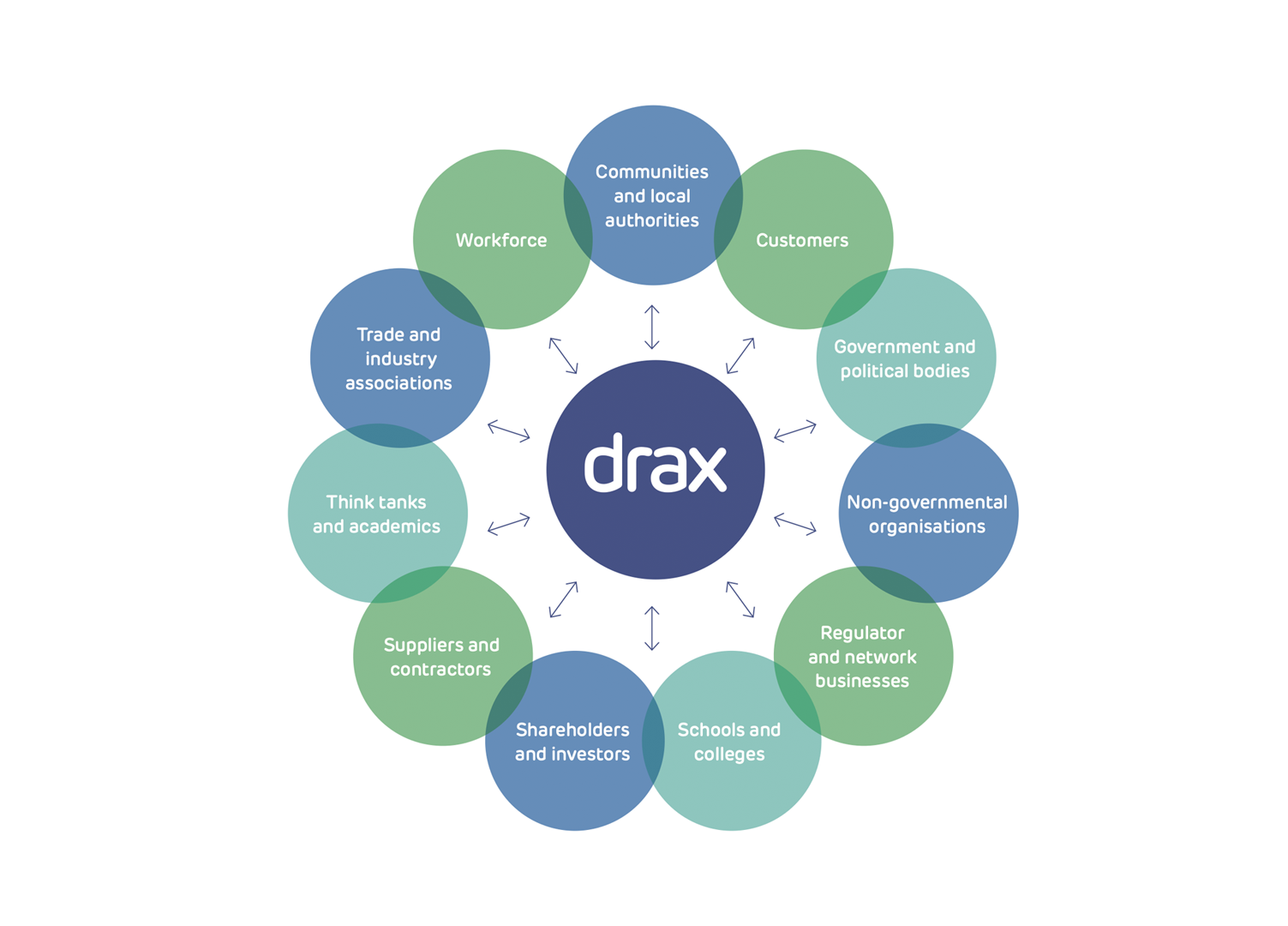
Companies Act, Section 172 Statement
Meaningful engagement with all our stakeholder groups supports our obligations under Section 172 of the Companies Act 2006.
On pages 24 to 29 of the full PDF report we set out how the Board, and the Group more widely, has had regard to stakeholder interests when discharging its duty to promote the success of the Company.
On pages 49 and 50 of the full PDF report we explain how we seek to maintain our high standards of business conduct.
Understanding the needs of our various stakeholders is essential to our long-term success
Engagement takes place at many levels of the business and a judgement about whether Board engagement, Executive Committee engagement, senior management or working level engagement is required is made on a case by case basis. The Group Head of Public Affairs maintains a detailed map of key stakeholders, the concerns they have raised and the date of the last meeting.
Management keeps under review the relevant stakeholders who may be affected by major decisions.
To ensure clear feedback to the Board, the CEO regularly reports to the Board on key stakeholder relations activity, current issues and the relevant feedback received from interaction with stakeholders. This is supported by the Group Director of Corporate Affairs, the Corporate Affairs team and the relevant owners of direct stakeholder engagement.
Supporting the Board’s duty to promote the success of the Company, as set out in Section 172 of the Companies Act 2006, Board and Executive Committee discussions include information on stakeholders likely to be affected by items under discussion and the potential impact. This ensures that the interests of all relevant stakeholders are considered in decision-making.
The Group Director of Corporate Affairs and the Group External Affairs Director presented a detailed report on stakeholder engagement in July 2019, to both the Board and the Executive Committee. This included the Board’s response to the 42% vote against the political donations resolution at the 2019 AGM and the development of a new policy for political expenditure. You can read more about this on page 27 of the full PDF report.
In 2019, we developed a new Remuneration Policy. Nicola Hodson, the Remuneration Committee Chair, led the engagement with our shareholders, to gain their feedback on the proposed Policy. You can read more about the new Policy in the Directors’ Remuneration Report on page 86 of the full PDF report.
As part of his induction, John Baxter visited 12 Drax sites in 2019, meeting with local management to discuss the business, in particular health and safety and plant management.
On appointment as Senior Independent Director in April 2019, David Nussbaum wrote to our largest shareholders to confirm his availability to meet with them. David also attended the Group’s Capital Markets Day in November 2019 and met with a variety of investors.
Communities and local authorities
Why?
Drax is an active participant in the communities in which it operates. Good community relationships strengthen our licence to operate in those areas.
How?
We engage regularly with the communities around our businesses through supporting local initiatives, holding quarterly meetings and formal drop in sessions. For example, we invested £100,000 to support local initiatives via the Galloway Glens Landscape Partnership.
Areas of focus
Jobs and employment, local environmental impact, community initiatives and sponsorship.
Customers
Why?
Engagement allows us to better understand our customers’ needs and how we can deliver continuous improvement in customer service.
How?
Our Customers business engages with our customers through channels including social media, our website, by phone and through our complaints procedure
Areas of focus
Energy costs, customer service support, Third Party Intermediary relationships, sales and product details, energy efficiency, carbon footprint.
Government and political bodies
Why?
Constructive engagement with Government is key to Drax’s purpose to enable a zero carbon lower cost energy future
How?
We regularly engage with regulators in the UK, EU and US on a broad range of topics including the need for decarbonisation, the role of biomass and carbon capture and storage policy. For example, engagement with political stakeholders at Party Conferences through All-Party groups
Areas of focus
Energy costs, Decarbonisation and Carbon Price Support, nationalisation risks, Impact of Brexit, Capacity Market, decarbonisation, climate change mitigation, biomass sustainability, Station ROC cap, development of policy to support BECCS, delivery of UN Climate Change Conference (COP26), unabated coal closure
Non-governmental organisations (NGOs)
Why?
Engagement with NGOs helps us to challenge and enhance our practices on behalf of the wider society
How?
We engage directly with NGOs on a wide range of topics from biomass sustainability through to carbon pricing. For example, our new Biomass Sustainability Policy addresses stakeholder issues
Areas of focus
Biomass sustainability, coal phase out, potential gas phase out, climate change, Carbon price support
Regulators & network operators
Why?
Engagement with Ofgem and National Grid allows us to help deliver a secure, reliable network with the least cost
How?
We engage directly with the relevant teams at Ofgem and National Grid. For example, we engage with National Grid and Ofgem over the growing need for financial mechanisms to support the provision of system services to the grid
Areas of focus
Targeted Charging Review, Smart meter installation, energy trading compliance, environmental compliance, health & safety compliance, compliance with biomass sustainability policy, ROC compliance, and business ethics compliance, including data protection
Schools and colleges
Why?
Engagement with schools and colleges allows us to promote interest in science, engineering and the energy sector, with a particular focus on under-represented sections of society
How?
We engage directly with schools and colleges and offer free access to our site tours for all students in term time. For example, Drax’s Women of the Future event in November 2019 formed part of the Company’s continuing efforts to encourage girls to study STEM subjects
Areas of focus
Jobs and employment, local environmental impact, community initiatives and sponsorship
Shareholders and investors
Why?
Engagement allows us to understand their concerns and priorities and take these into account in our decision-making
How?
We engage through a wide range of channels including our website, AGM, full-year and half-year results, a Capital Markets Day, an ongoing programme of investor relations meetings, engagement by the Chair of the Remuneration Committee on the proposed new Remuneration Policy, engagement on the new Political Engagement Policy and an investor audit
Areas of focus
Drax strategy, capital allocation and dividend policy, reinstatement of the Capacity Market, share price performance, operational performance, remuneration policy, political engagement policy
Suppliers and contractors
Why?
Strong relationships with suppliers and contractors allow us to mitigate health and safety risk, promote high standards and ensure realistic expectations on project delivery
How?
Drax’s procurement, business ethics and sustainability functions engage directly with suppliers around key issues to ensure our values and our policies are upheld throughout our supply chain
Expected standards of conduct and satisfactory responses to our due diligence requests, Prompt Payment Code, provision of guidance regarding statutory obligations, such as Modern Slavery Act
Think tanks and academics
Why?
Engagement allows us to keep abreast of the latest thinking and likely policy developments across a range of areas
How?
We engage with think tanks and academics through direct participation in events and round tables. We directly sponsor several PhDs at British universities. Established an Independent Advisory Board on sustainable biomass
Areas of focus
Carbon pricing, CCS policy, biomass sustainability, future energy policy
Trade and industry associations
Why?
Active membership of a wide range of trade and industry associations allows us to keep track of best practice in our sector
How?
We engage directly with trade bodies focusing on energy and sustainable forestry. For example, Drax is an active member of Energy UK, Biomass UK and the CBI
Areas of focus
Energy policy, reputation of energy sector, reputation of biomass sector, Ofgem’s targeted charging review, Health & Safety best practice
Workforce
Why?
To create an engaging environment where our employees can thrive and people want to work
How?
We maintain regular dialogue with our workforce through our MyVoice Forums, briefings, weekly updates and Q&A from our CEO and our annual survey
Areas of focus
One Drax awards, benefits review, Beyond Coal, impact of transformation and restructure, future strategy, trade union relations, learning and development, career progression and wellbeing
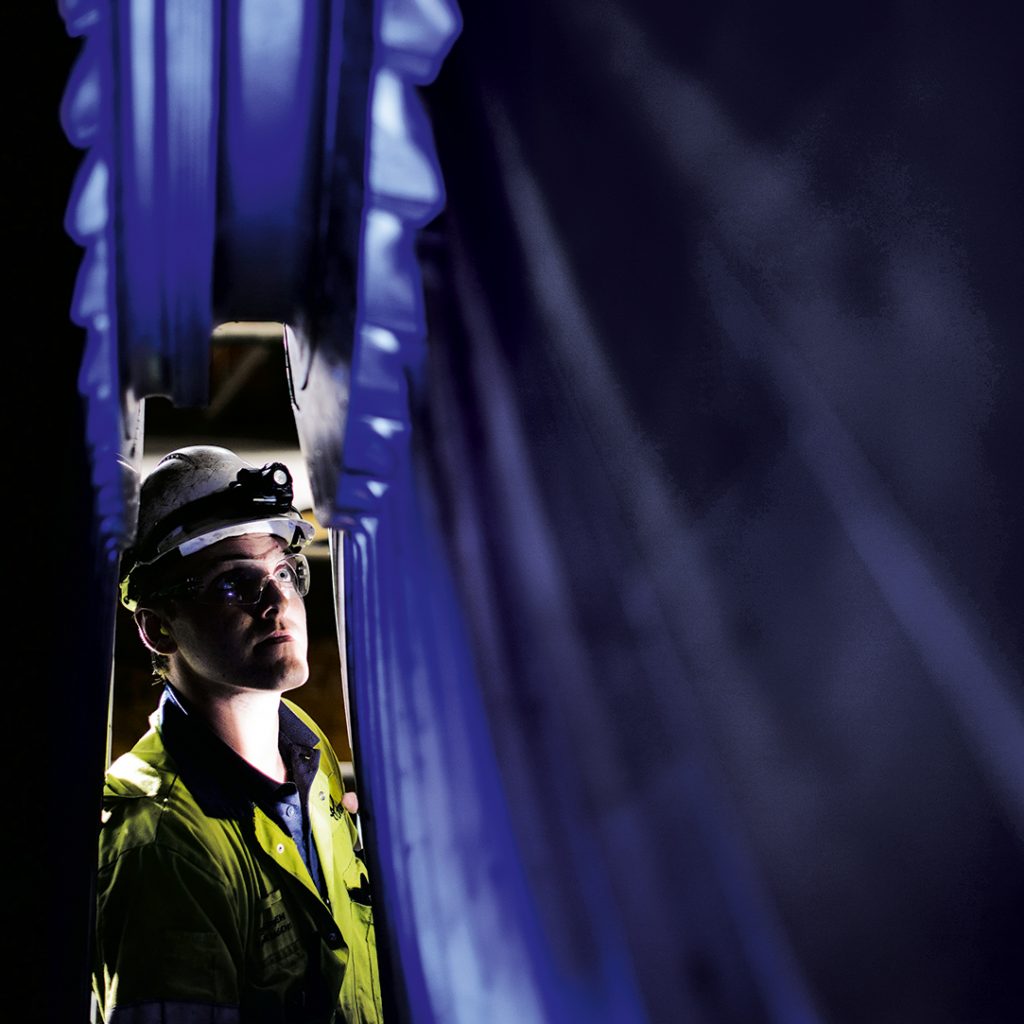
Engagement over political donations policy
While Drax makes no political donations in the generally accepted definition of the term, it is important that we engage with politicians, political parties, policy makers and other stakeholders. The engagement includes, for example, sponsorship of events at party conferences and facilitating visits to the areas in which we operate where such activity is closely tied to our business objectives. While this type of expenditure is typically classified as “commercial spend”, Drax is mindful of the potential for these activities to be considered political, or to be included on the Electoral Commission Register.
At Drax’s 2019 AGM, a majority of shareholders voted in favour of an increase in the authority which would allow for inadvertent political spending. However, 42% of shareholders voted against the proposed increase. This represented a significant fall in support compared to previous years so we implemented a systematic programme to engage with shareholders to understand how our approach could better align with our investors’ expectations and address the concerns expressed at the 2019 AGM.
We reviewed initial feedback received from shareholders at the time of the AGM; analysed spend from political engagement activities; engaged a third party to conduct an external benchmarking exercise on political donations authorities; developed a new Political Engagement Policy (Policy), which included an aggregate expenditure cap of £125,000 reflecting initial shareholder feedback; developed a strategy for engagement with shareholders which was approved by the Board in July 2019, along with the new Policy; engaged with major shareholders both in writing and in person; considered further feedback received; published an update on our website in October 2019, within six months of the AGM, and published the new Policy here.

Workforce engagement
Workforce engagement forums – MyVoice – were implemented in 2019. In determining the most appropriate engagement method to adopt, the Board considered that the workforce forums already in place in parts of the business provided a strong basis on which to develop and grow a Group- wide structure. It was therefore agreed to expand the existing infrastructure, create a more formal governance framework and provide appropriate resourcing to support the forums.
The forums are aligned to our operating model, representing the Pellet Production, Generation and Customers businesses, and Core Services. Each forum comprises up to 12 colleague representatives, including the chair, and meets as regularly as each forum feels is appropriate for local needs.
Each forum is made up of members drawn from nominated colleagues from across the relevant business unit, and each forum chair has been selected by membership vote. MyVoice forum members attended an independently facilitated two-day training course to develop the skills needed to be confident in fulfilling their role. Penny Small, Chief Transformation officer, is the Executive Committee sponsor.
The chairs of each of the forums come together quarterly to discuss workforce issues across the business. The chairs then meet with the Group Chair and CEO to discuss the key issues raised, with feedback from these meetings then shared with
all forum members.
Matters discussed during 2019 include how effectively communication filters down from senior leadership to the wider business: wellbeing, including a greater focus on mental health; and living our values. In response to MyVoice feedback, the Safety, Health, Environment and Welfare Leadership Executive Committee, a sub- committee of the Executive Committee, has developed plans to address wellbeing across Drax Group, including mental wellbeing, which have been shared with the MyVoice forums to seek their input before rolling out in 2020.
Capital Markets Day
In November 2019 we hosted a Capital Markets Day to update investors on our strategy. Around 80 participants joined the Capital Markets Day presentation, reflecting a combination of existing shareholders, investors and lenders.
A key theme of the event was the business case behind our plans to increase our self-supply of pellets. The event included a presentation by Dr Rebecca Heaton, our Group Head of Climate Change, on the ways in which we ensure our biomass supply is sustainable (for more on this see page 34 of the full PDF report).
There was an opportunity for attendees to ask questions and, once the main presentations were over, meet with members of senior management, including the CEO, CFO, CEO Generation and Senior Independent Director. Questions focused on the long-term cost of biomass, biomass sustainability and the growing focus on Environmental, Social and Governance (ESG) matters.
Following the Capital Markets Day we hosted an ESG site visit at Drax Power Station to discuss biomass sustainability, the future of gas and the Just Transition.
All materials from the Capital Markets Day, together with a video of the presentations and the Q&A session, have been made available on the website.
In 2019 around 80 participants joined the Capital Markets Day presentation.
Ask the CEO
Each week employees are able to ask, anonymously, questions of the CEO on any subject. The CEO then sends a weekly email to all colleagues with his thoughts and highlights of the week followed by his responses to the latest questions.
In 2019 employees asked nearly 2,000 questions in “Ask Will”. Subjects ranged from questions about strategy – with employees enquiring and challenging to gain deeper understanding of what we do and plan to do; climate change – including what Drax is doing to help to tackle climate change, what employees can do as individuals and Will’s own views; areas of concern around the business; mental health and wellbeing; pay and benefits around the Group and new or innovative ideas.
Examples of action taken as a result of “Ask Will” questions include the development of a car-sharing programme, enhancements to the cycle-to-work scheme and the development of a Group-wide charitable giving programme.
Zero Carbon Humber
In 2019 Drax Group, Equinor and National Grid Ventures launched the Zero Carbon Humber campaign which commits them to work together to explore how a large-scale carbon capture use and storage (CCUS) and hydrogen production facility could be constructed in the Humber in the mid-2020s.
This initiative was the first significant response from industry following the UK Committee on Climate Change’s Net Zero report which found that CCUS and hydrogen technology developed in regional industrial structures is essential if the UK is going to achieve a net zero carbon economy by 2050.
The programme means we will work with partners including the Humber Local Enterprise Partnership, local Councils, trade unions, politicians, and businesses across the region to deliver what could be the world’s first net zero carbon region.
In September 2019, the partnership launched Capture for Growth, a roadmap to guide the delivery of the net zero industrial cluster on Humberside by 2040. The cluster could secure 55,000 jobs and capture 15% of the UK’s current annual CO2 emissions – the biggest contribution to the UK’s climate commitments of any region.
At the UN Climate Change Conference in Madrid in December 2019 we announced our ambition to become a carbon negative company by 2030.
Biomass Cost Reduction
Building a long-term future for sustainable biomass is a key strategic objective for Drax.
The key to delivering this objective is reducing the cost of wood pellets to a level where biomass generation is economic without subsidy.
Current biomass generation at Drax Power Station is supported under two separate schemes. Three biomass units receive support under the Renewable Obligation scheme and one unit receives support under the Contract for Difference scheme. The support under both these mechanisms ends on 31 March 2027. Today, without these schemes, it is uneconomic to produce renewable electricity from biomass.
The Group’s objective is to reduce the cost of biomass by about 30% by 2027 – from around £75/MWh in 2019 to around £50/MWh. We believe that delivering this reduction will establish an economic model for unsubsidised biomass generation beyond 2027.
How will we do this?
Optimise existing capacity and generation
Drax currently uses around seven million tonnes of biomass, 1.4 million tonnes of which are self-supplied by our operations in the US Gulf.
As Drax’s pellet production business is relatively immature – its first assets were commissioned in 2015 – there are significant opportunities to optimise, improve processes and drive greater efficiencies.
Current initiatives:
A co-location agreement with sawmill operator Hunt Forest Products next to the LaSalle pellet plant began production in February 2019 and provides:
- Low-cost sawmill residues
- Reduced transportation costs
- Reduced As sawmill residues are a semi-processed material, we can reduce the number of steps in the production process, eliminating chipping, drying and debarking
A rail spur linking LaSalle to the regional rail network and our port facility at Baton Rouge was commissioned in May 2019. This increases transportation efficiency, economies of scale, reduces cost and carbon footprint.
Development of an enlarged chambering yard at the port of Baton Rouge, by the regional rail operator.
- Economies of scale in rail allowing 80-car train sets to operate from our LaSalle and Morehouse sites (previously 45-car train sets)
These initiatives and others have contributed to a 3% year-on-year reduction in cost per tonne, which represents a saving of $5 per tonne compared to 2018.
The larger projects will be accompanied by small projects to improve operational efficiency such as greater efficiency in the loading of road haulage, which saves 50 cents per tonne. Over time these improvements, when applied across the supply chain, have the potential to deliver significant incremental savings.
We have also identified plans to expand our existing three sites, LaSalle, Morehouse and Amite, by 350,000 tonnes over the next two years – an investment of £50 million. This will expand total capacity to around 1.85Mt, provide economies of scale and allow even greater utilisation of low-cost residues. These projects support lower cost wood pellets, while delivering an attractive return on capital, with payback before 2027.
Further expansion of self-supply capacity
Ownership of the supply chain provides the opportunity to reduce cost and create significant value, both pre- and post-2027. This is why Drax aims to increase self-supply capacity to five million tonnes by 2027.
We are considering the development of low-cost satellite plants in the US Gulf which would be able to use our existing infrastructure and sawmill residues to produce low-cost wood pellets. We believe this could add up to 0.5 million tonnes of new capacity.
We will continue to assess opportunities to build or buy new capacity to support this ambition – both in the US Gulf and elsewhere.
Expansion of the fuel envelope
When we converted Drax Power Station units from coal to biomass we took a conservative approach to boiler chemistry and decided to use sustainable biomass, such as US pine, because we knew it would mitigate the risk of boiler fouling issues.
To date, the operational experience has been positive and this has allowed us to now expand the fuel envelope and chemistries we will consider for renewable residues. This opens up the opportunity to consider a broader range of products and geographies which could have attractive cost characteristics while meeting our strict sustainability criteria.
Over the last decade, as part of our work on biomass, we have screened hundreds of different types of materials, and we’re now using this knowledge of chemistries and operational characteristics to inform the expansion of the fuel envelope.
Examples of these materials include sugar cane residues (bagasse), nuts and agricultural residues.
Trading and optimisation
An integral part of our strategy is to develop a biomass trading capability. This is an optimisation and risk management activity to support our aim to deliver lower-cost pellets, and not proprietary trading, through which we aim to:
- Manage internal supply, or short-term supply imbalances
- Optimise internal and external supply as we build our self-supply capacity
- Manage the different levels of demand we might see after 2027
- Take advantage of opportunities in other markets as the global biomass market develops
Beyond 2027
Biomass cost reduction is a significant value opportunity, with attractive returns delivered pre-2027. With a lower cost base, we believe that biomass can be economic without subsidy. We also believe that reducing costs supports the development of bioenergy with carbon capture and storage (BECCS). The UK requires more renewables and BECCS if it is to achieve its target of net zero by 2050. These factors inform our expectations.
However, if biomass generation is uneconomic post-2027, we retain the option to sell to other international markets which we expect to grow in the coming decade. Being the largest low-cost producer in the world would give us strategic optionality and a competitive advantage in this regard.
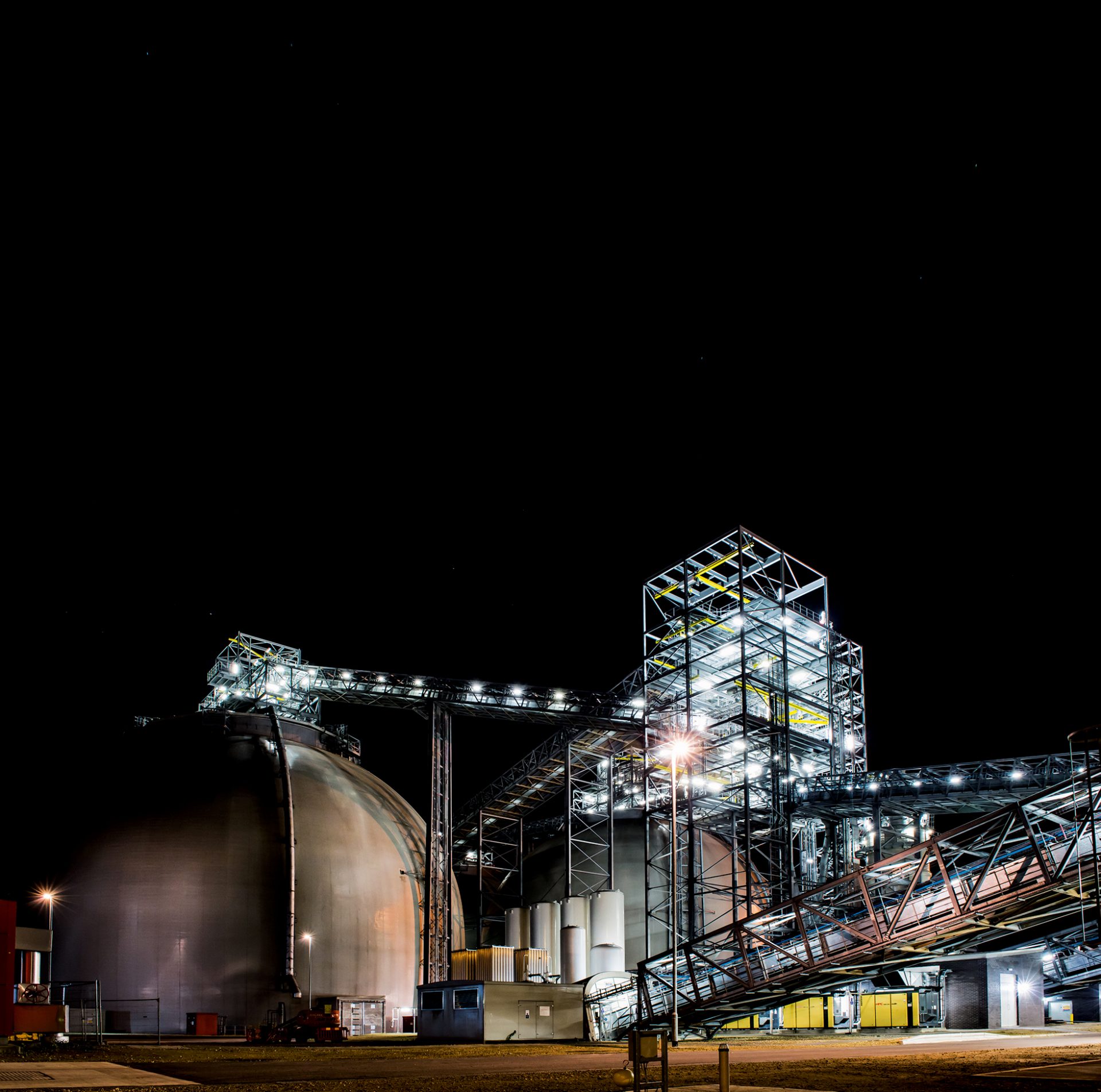
System Stability
How can we be the leading provider of system stability?
What’s the issue?
Keeping the lights on requires not just electricity generation, but also a range of non-generation activities which help provide stability, flexibility and reliability. These system support services include:
Inertia
The stored energy in synchronous generators which slow down the rate of changes in system frequency,
Voltage control/Reactive Power
(MVars) – Reactive power is used to manage power flows around the transmission system and helps to support voltage in the event of a system fault.
Reserve
The system operator must be able to ensure a balance between demand and generation at all times to prevent power cuts at times of peak demand. This increased and decreased generation is sometimes referred to as headroom and footroom respectively. Managing demand can also be used to the same effect.
Response
The automatic change in generation output, or in demand, to maintain a system frequency of 50Hz. This frequency response is required every second of the day.
Black Start
The ability of a generation unit to start up without external electricity supplies following a total or partial loss of power from the transmission system.
Historically, large coal- and gas-fired power stations were able to deliver these services as a by-product of producing reliable baseload electricity. Now, these older coal and gas plants are being shuttered in the UK and being replaced by intermittent renewable energy sources, principally wind. This reduces carbon emissions but makes the provision of these system support services more challenging. Wind, by its nature, is intermittent and, for the most part, unable to provide system support services.
So as demand for system support services increases, there are fewer assets, such as large power stations, able to provide them. This is increasing the cost of operating the system and is a growing source of value for generators like Drax who can provide these services.
How can we do this?
Our focus as a generator is to provide the flexible, renewable and low carbon generation millions of households rely on. Drax operates a portfolio of sustainable biomass, hydro and gas assets which are well positioned, both geographically and operationally, to provide these services to the UK electricity market.
These assets include:
Sustainable biomass
Drax Power Station in north Yorkshire has 2.6GW of flexible renewable generation in the centre of the UK. The power station is well-situated to provide system support services to central and northern England and Scotland.
Pumped Storage Hydro
Cruachan Power Station in western Scotland has 440MW of fully flexible electricity generation that can be brought online in two minutes from rest. Cruachan has large-scale energy storage as well as a full suite of system support capabilities. The power station, which is capable of 15 hours of full-load generation and storage, is well located to support regional nuclear and offshore Scottish wind farms.
Gas
CCGT – Drax has 2GW of flexible generation at Damhead Creek, Shoreham and Rye House power stations in southeast England. These are well located in a key demand centre.
Demand-side response
System support is principally delivered through generation, but we also have a growing opportunity to provide some of these services through our Customers business. We provide electricity to large and industrial customers, in addition to SMEs. Working with these larger customers we expect to provide demand-side response services to the electricity market – reducing demand at times of lower supply and vice versa.
Giving customers control of their energy

We provide all customers with the ability to control and optimise energy use, cost and source.
Through the provision of insight, digitisation, and services, we provide all customers with the opportunity to control and optimise energy use, cost and source.
Demand-side Response
Haven Power is the leading challenger brand provider of renewable energy and services to Industrial and Commercial customers. Haven’s large portfolio of industrial and commercial customers provides opportunities to provide system support services to the energy market and create value for customers.
In November 2019, United Utilities became the first customer to sign up to Haven Power’s Asset Flex project. Known as Demand Side Response (DSR), customers are provided with financial incentives to turn down, or off, non-essential equipment at times of peak demand depending on the customer’s needs.
Haven installs its technology to turn down or off customers’ energy demand in peak times to reduce costs, and is designed to always work within the constraints set by the customer. For example, turning down an industrial fridge or freezer where the ambient temperature can remain within certain limits even if it isn’t running at full blast for the whole time. It’s simple for the customer: Drax has the opportunity to create value from the asset in the provision of system support services and in exchange, customers get a cheaper tariff.
By reducing demand, typically at times of peak demand, which are also periods of higher carbon intensity, Drax Group is supporting the energy system and delivering the Group’s purpose of enabling a zero carbon, lower cost energy future.
Electric Vehicles (EVs)
Drax is developing an end-to-end bundle aimed at making it easier for companies to switch to EVs. SES Water was the first partner to trial this bespoke package, which includes charging infrastructure, operating software, EV leasing, and the renewable electricity needed to power them.
The aim is to deliver EV charging and battery optimisation, which ties into our customer control strategy. By understanding all aspects of EVs from telematics to charge-point hardware and software we are identifying opportunities to create value for customers and the Group.
Battery power
Energy storage through batteries is also being tested with customers who already generate renewable energy onsite.
Energy storage is the key to helping customers maximise the benefit of the energy they generate from their own small-scale renewables, providing greater flexibility to the grid and smoothing volatility in the system.
Drax has partnered with energy storage company Eaton, which offers new and second-life batteries, such as used EV batteries, for installations on customer sites. Eaton can quickly scale-up the deployment of small commercial energy storage systems to larger, industrial-scale units, helping to support more customers.
Customers are asking us about technologies to make their sites more efficient and sustainable, so we’re reacting to that. Lots of our customers want to improve the resilience of their sites. This area will continue to grow.
Biomass sustainability
Why sustainable biomass is good for forests and the climate
Q&A with Dr Rebecca Heaton, Group Head of Climate Change at Drax

“We’re committed to sustainable biomass which is why our biomass sourcing policy goes beyond existing regulations.”
Dr Rebecca Heaton, Group Head of Climate Change
There’s widespread recognition among leading science-based organisations, such as the UN’s Intergovernmental Panel on Climate Change, that sustainable biomass has a vital role to play in meeting climate targets. Sustainable biomass has three big benefits: it generates renewable electricity, supports forest growth and is a route to negative emissions using BECCS. At Drax, replacing coal with biomass to generate power has already delivered carbon savings of more than 80% since 2012.
Generation of electricity using biomass functions as a closed loop carbon system. When trees grow, they absorb carbon dioxide. Emissions from using biomass to generate electricity are balanced by the absorption of CO2 from the forests that are growing. This differs from burning coal where the emissions remain in the atmosphere.
It’s important to remember that the carbon benefits are only realised if the biomass is sustainable. There are many criteria for sustainable biomass, including taking wood from managed forests – those that are replanted after harvesting, not causing deforestation, or cutting old-growth forests or harvesting wood from protected areas.
We’re committed to sustainable biomass which is why our Responsible Sourcing Policy for Biomass goes beyond existing regulations, and commits us to only take feedstocks that the science says delivers climate benefits. Sustainable biomass helps to provide a market for the low- value residues from a working forest.
This creates an incentive for landowners to have more forests under management, contributing to greater forest growth and more CO2 captured. Sustainably managed forests are typically healthy, support biodiversity and can absorb more carbon than unmanaged forests.
We can see evidence of this in the US, where we source almost two thirds of our pellets. According to US Forest Service data (Forestry Inventory Analysis database, November 2019) there is an average annual surplus of nearly 200 million m3 of new growth compared to harvesting. In Canada, in 2017, the surplus of growth compared to harvesting was 63 million m3 (National Forestry Database, 2017).
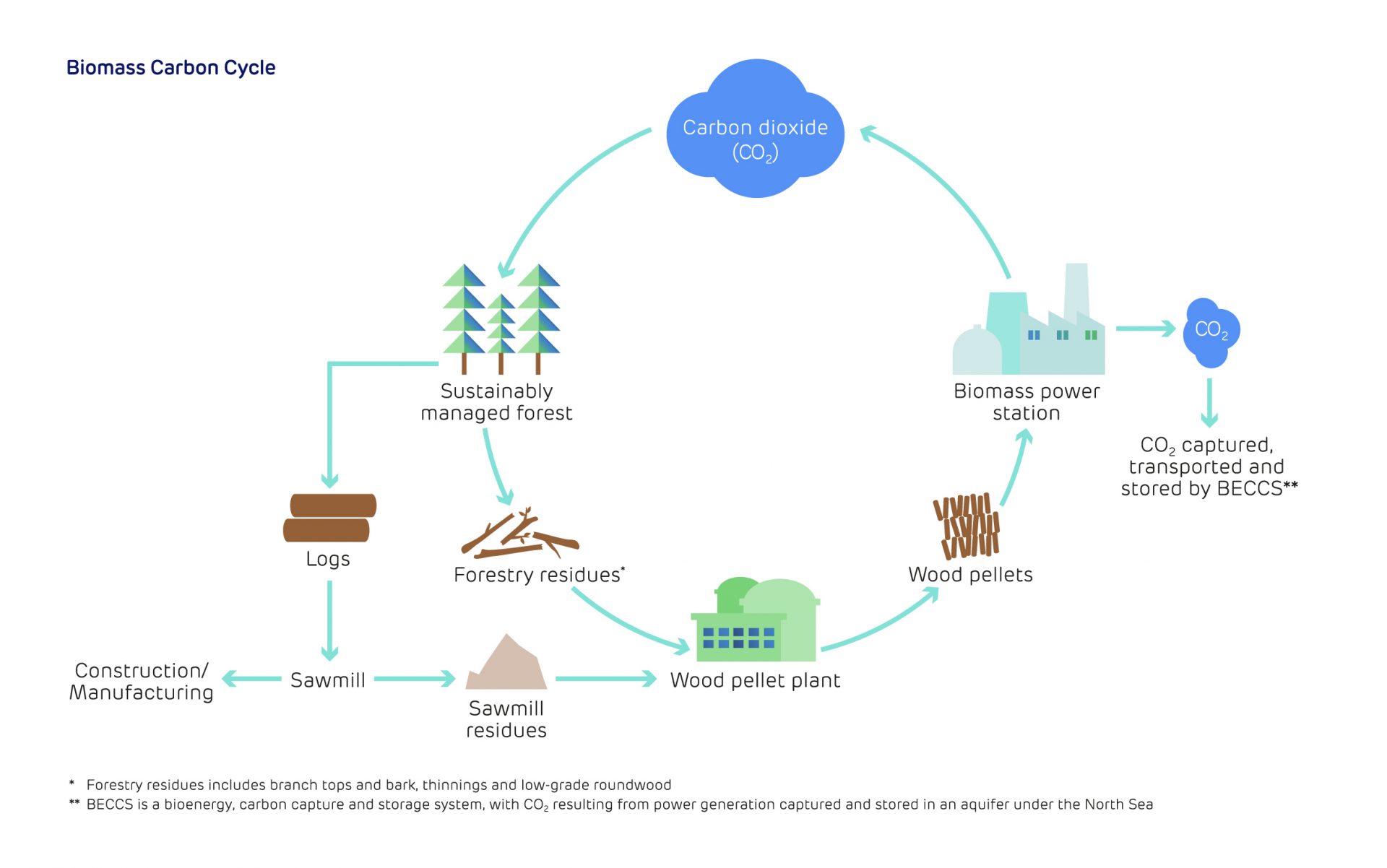
Forests are managed for multiple objectives, including biodiversity, water management and timber production. The main timber product from a forest is saw logs. These large, high-value logs produce wood products for construction or furniture, ending up as long-term carbon storage. Around half of a saw log going into a sawmill comes out as sawdust.
In some parts of the world, that is simply burned or ends up in a landfill. Almost 40% of our wood pellet feedstock is, in fact, those sawmill residues. Of the rest, around 30% is thinnings, branches, tops and bark and 30% low-grade roundwood.
Around a fifth of the material we use to make pellets is thinnings, where trees are taken out at various intervals to allow the remaining trees to grow bigger. Thinning also stops pests, diseases and fire from ripping through the forests and supports biodiversity. Providing a market for these thinnings helps these forests thrive.
How do you know that the wood Drax uses is sustainable?
Everything we do is independently audited and we abide by all the current requirements for sustainable biomass.
The UK and EU have robust regulatory frameworks for sustainable biomass. Drax’s requirements on biomass sustainability exceed these rules. We also use external certification through the Sustainable Biomass Program (SBP), which sets a standard that is audited by independent third-party auditors.
It’s also about choosing the right feedstocks in the first place – something we’re committed to ensuring.
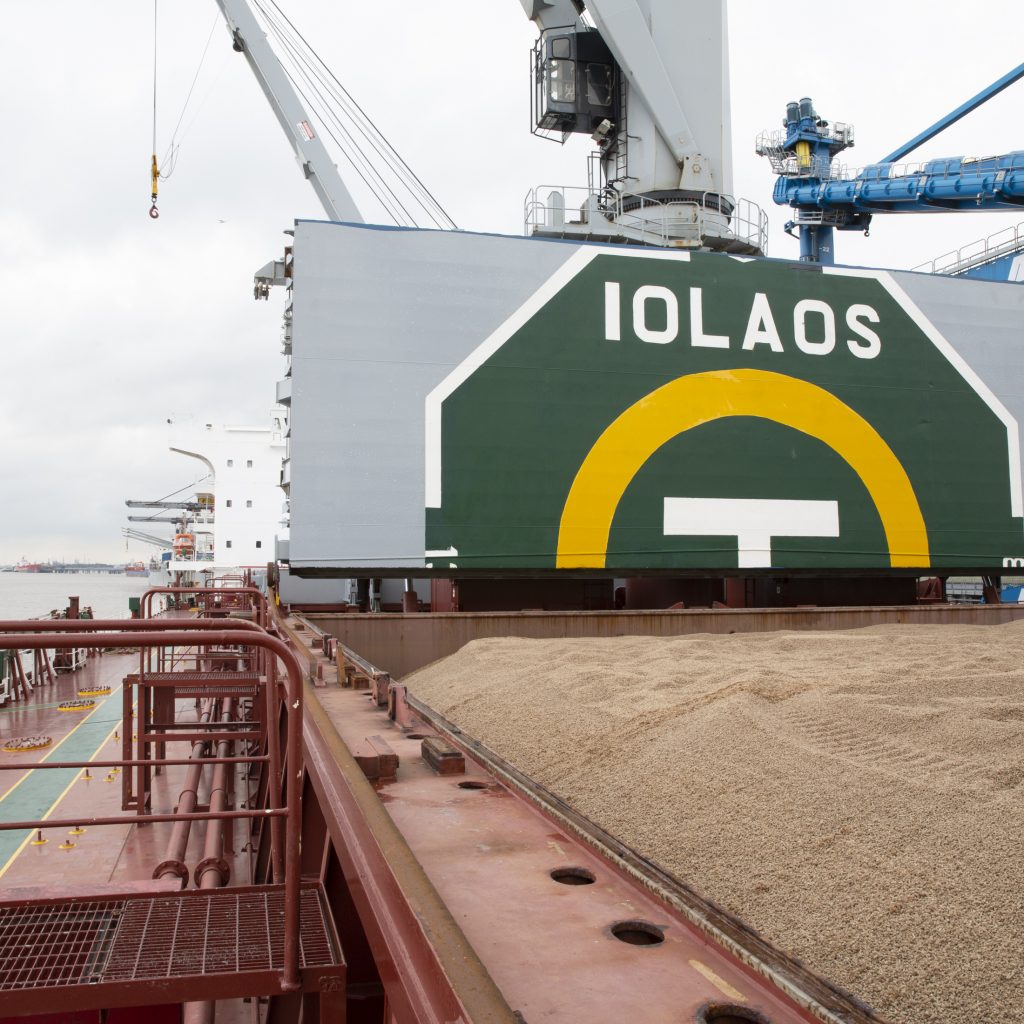
Biomass pellets transported from the US are unloaded at Immingham Port in the UK before being transported to Drax Power Station
Why do you ship wood from the US and Canada to the UK?
Biomass is best sourced from vast forests with established forest industries which generate a lot of low-value residue. North America, with its well-established and sustainable commercial forest industry, meets those conditions. That’s why we bring a lot from the US. We transport the pellets mostly by train and ship, with a small proportion of the journey using fuel-efficient trucks. We track and manage all the journeys to ensure the supply chain is as low carbon as possible, and report the final number for our biomass supply chain on page 43 of the full PDF report, which is independently audited.
We’re also involved in various transportation initiatives such as the Smart Green Shipping Alliance.
Tell us about the new Responsible Sourcing Policy for Biomass
As a significant user of sustainable biomass for energy we wanted our policy to go beyond existing legislation and requirements.
The policy we published in 2019 draws on recommendations made by Forest Research, the research agency of the Forestry Commission, in a report commissioned by the European Climate Foundation. Alongside the new policy, we also launched an Independent Advisory Board of scientists, who will keep us at the forefront of the latest scientific thinking and best practice on biomass sourcing.
Our policy has four parts to it. First, we commit to only use feedstocks which the science says delivers climate benefits. This means we won’t use biomass that drives harvesting decisions that would adversely affect the long-term potential of forests to store carbon. Second, we will protect the natural environment – for example, by not causing deforestation. Third, we will support people and communities. Finally, we committed to carry out research, outreach and intervention, which includes active engagement with the communities where we operate and NGOs.
How will the Independent Advisory Board (IAB) work?
The six-member IAB is chaired by the UK government’s former chief scientific adviser Professor Sir John Beddington. The IAB will help to keep our sourcing guidelines under regular review so they can evolve as the science develops. You can read more about the IAB on page 41 of the full PDF report.
We expect the IAB to challenge us every step of the way, and believe it’s right that companies using biomass go beyond existing regulations to ensure that it makes a positive contribution to our climate and the environment.
What are the next steps?
A big part of our work in 2020 is to increase transparency on our biomass sourcing and its impacts. We will provide that evidence by using big data and satellite images to evaluate the impact on forest cover, forest carbon and biodiversity in areas that supply Drax’s pellet mills (see Healthy Forest Landscapes on page 44 of the full PDF report).
We are working with non-profit groups and NGOs, including Earthworm Foundation and biodiversity-focused group NatureServe, to understand the social and economic impacts and benefits in the areas where we source our biomass.
In 2020, we will broaden our work with Earthworm on our healthy forest landscapes programme. We will also expand the pilot that evaluates the impact on forest cover and biodiversity to more sites and publish findings from our initial work.
Ensuring the sustainability of the biomass we use is vital if we’re to move to the next stage and deliver negative emissions using bioenergy carbon capture and storage while continuing to supply flexible, renewable power to the UK grid.
Dr Rebecca Heaton
Group Head of Climate Change
Chapter 6:
Building a sustainable business
Achieving a positive long-term economic, social and environmental impact together.
At Drax, being a sustainable business means achieving a positive long-term economic, social and environmental impact as part of the Company strategy.
We have identified non- financial priorities that are material to our business and important to our stakeholders. Our 2019 progress and performance are reported under each priority area as follows:
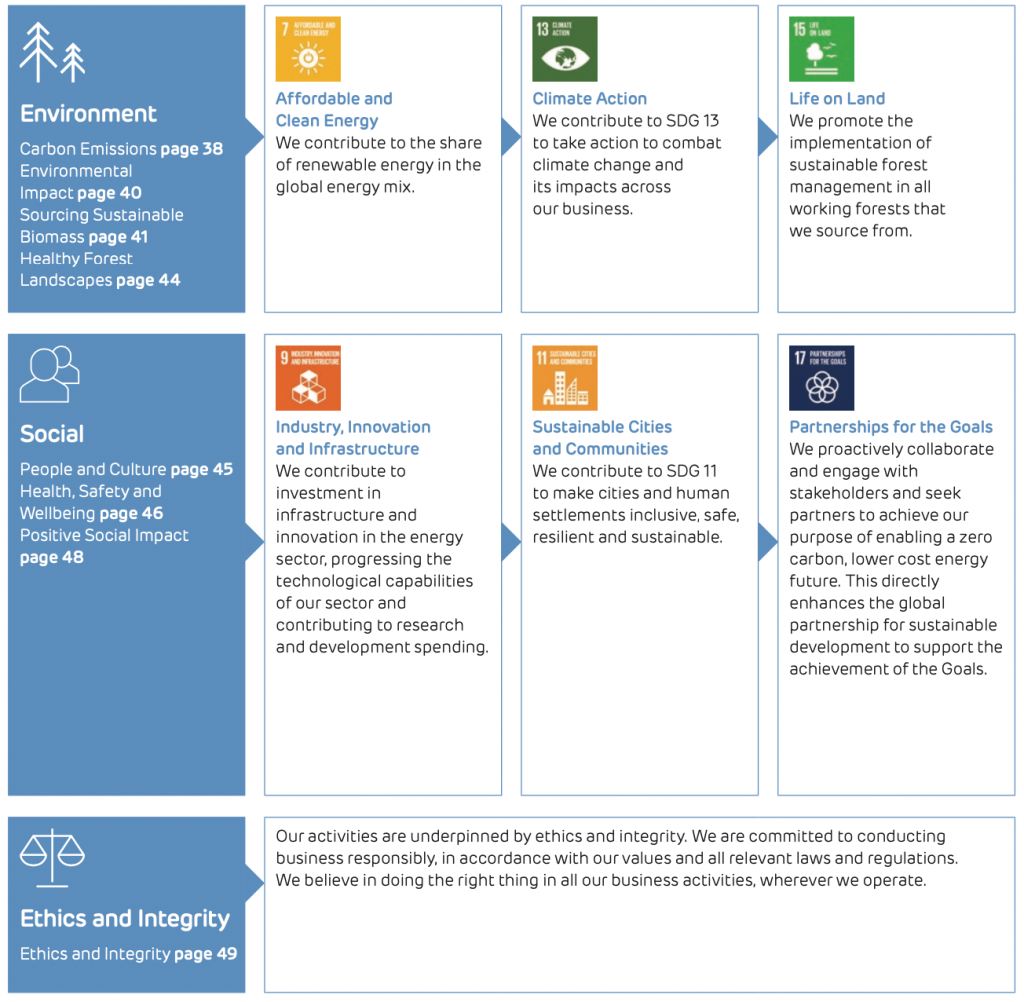
Our Impact on the Sustainable Development Goals
The 17 United Nations’ Sustainable Development Goals (SDGs) are a blueprint to achieve a better and more sustainable future for everyone. We have identified six SDGs and associated targets where we can make the greatest positive impact. Drax is a participant of the United Nations Global Compact (UNGC) and sits on the UNGC UK Advisory Group.
Environment
Carbon Emissions
Drax has a significant role to play in the transition to a low-carbon economy and this informs our purpose to enable a zero carbon, lower cost energy future. We are committed to supporting the UK government to achieve net zero carbon emissions by 2050.
“Drax’s ambition is to be carbon negative by 2030. Having pioneered the use of sustainable biomass, Drax now produces 12% of the UK’s renewable electricity. With the right negative emissions policy, we can do much more, removing millions of tonnes of emissions from the atmosphere each year.”
Will Gardiner, Group CEO
Managing Climate Change Risks and Opportunities
We are committed to the identification, management and disclosure of our climate change risks and opportunities in line with the recommendations of the Task Force on Climate-related Financial Disclosures (TCFD).
In 2019, we responded to the CDP Climate questionnaire and received a score of C. We introduced climate change as a new principal risk category (see Principal Risks and Uncertainties on page 54 of the full PDF report).
Our Negative Emissions Ambition
At the UN Climate Change Conference COP 25 in December 2019, Drax announced our ambition to become carbon negative by 2030. We have signed up to the Science Based Targets initiative to further assure that our target is aligned with climate science.
Using technologies such as Bioenergy with Carbon Capture and Storage (BECCS), Drax aims to remove more carbon dioxide from the atmosphere than it produces, creating a negative carbon footprint for the Group. Our leading ambition is only achievable with an effective negative emissions policy and investment framework for technologies such as BECCS.
Innovating to Decarbonise our Business
Carbon capture and utilisation is part of our business strategy and we made progress on this work in 2019.
Drax has set up a Bioenergy Carbon Capture and Storage (BECCS) demonstration pilot at Drax Power Station with C-Capture, a start-up from the University of Leeds. We also secured funding from the UK Government to explore the feasibility of building a second carbon capture pilot at Drax Power Station, using molten carbonate fuel cells as a technology for capturing carbon dioxide.
In September 2019, together with Equinor and National Grid Ventures, we launched the Zero Carbon Humber Campaign (www.zerocarbonhumber.co.uk) to develop the first zero carbon industrial cluster in the UK by 2040.
Carbon Emissions Performance
Group total carbon emissions (Scope 1 and 2) fell 47% between 2018 and 2019. This reflects a reduction in coal generation and an increased share of generation from biomass, gas, hydro and pumped storage. The reduction in carbon emissions at Drax Power Station had the most significant impact. With four of the six generating units now converted to biomass from coal, emissions from Drax Power Station have fallen from 22.7 million tCO2 in 2012 to below 1 million tCO2 in 2019.
Significant emissions reduction activities undertaken in 2019 included the installation of a new high-pressure turbine on Unit 2 at Drax Power Station, at a cost of £12.5 million, to improve its efficiency. We have also improved the energy efficiency at some of our Customers business facilities, with measures such as installing solar panels, LED lighting and battery storage.
Generation Technology Mix
From 2018 to 2019, the mix of technologies in the Generation business diversified as we expanded our portfolio of dispatchable, flexible assets to support the energy system’s growing use of intermittent renewable energy.


Environmental Impact
We are committed to managing, monitoring and reducing the environmental impact of our operations and the Group environment policy outlines our approach.
The Environmental Management Systems (EMS) at our Generation sites in the UK are certified to ISO 14001. The EMS at our Pellet Production sites in the US are based on the principles of, but not certified to, ISO 14001.
We self-reported one environmental permit breach at Drax Power Station in 2019. The regulator categorised it as having no impact on human health, quality of life or the environment.
Emissions to Air
Our work in 2019 focused on future compliance with the requirements of the EU Best Available Techniques reference documents (BREFs), which will further reduce emission limits, entering into force in 2021.
At Drax Power Station, emissions of nitrogen oxides, sulphur dioxide and particulates continued to trend downward. This can be partially attributed to a reduction in total generation, as well as the first full year of operation of Unit 4 since its conversion to biomass from coal.
Our UK gas generation and biomass production sites are also permitted for releases to air by the Environment Agency and Scottish Environment Protection Agency respectively. 2019 emissions to air were in line with expectations for the generation and production levels achieved.
Water Use
Water is utilised at our thermal generation sites for operational and cooling processes, and losses occur through steam and ancillary processes. Procedures are in place to manage water system efficiency and usage and to ensure that all discharge consent limits are met.
The Galloway and Lanark Hydro Scheme utilises abstracted water that is returned to the environment immediately.
At Cruachan Power Station, water abstracted from the upper reservoir is used for generation and water abstracted from Loch Awe is used for pumping.

Sourcing Sustainable Biomass
At Drax we use wood pellets sourced from sustainably managed working forests and residues from forest industries to generate low-carbon, renewable electricity. We ensure our biomass is sustainable and compliant with appropriate legislation through a combination of proactive supplier engagement, third-party certification schemes and our own audits and checks.
The Group Sustainability policy outlines our requirements and it is evidenced and included in biomass supplier contracts. Details of our due diligence process are available at www.drax.com/uk/sustainability.
Responsible Sourcing Policy for Biomass
In 2019, we published Responsible Sourcing: A policy for biomass from sustainable forests. This Responsible Sourcing policy for biomass strengthens our approach in line with recommendations made by a report commissioned by the European Climate Foundation. This is to provide further assurance that the sustainable biomass we source makes a net positive contribution to climate change, protects and enhances biodiversity and has a positive social impact on local communities.
The Responsible Sourcing policy outlines our forest biomass sustainability commitments:
1. We will reduce carbon dioxide emissions
We are committed to ensuring the biomass we use makes a positive contribution to tackling the climate change crisis and fulfilling the UK’s Paris Agreement targets.
2. We will protect the natural environment
We recognise our duty to keep forests thriving and to respect the many benefits they bring, including carbon storage, protection of soil and water quality, supporting biodiversity and provision of habitat.
3. We will support people and communities
From state-owned forests to smallholdings, and from the US Southeast to the Baltic states, forest owners, forest workers and communities in our sourcing areas are bound by their common reliance on forests for employment, wellbeing and quality of life.
4. We will invest in research, outreach and intervention
The strength of our collaboration with others will improve the sourcing choices we make. We are committed to working with governments, non- governmental organisations, academia and other stakeholders to continually improve biomass sourcing and develop best practice.
Independent Advisory Board
During the year, we established an Independent Advisory Board (IAB) of scientists and leaders in the field of sustainability to provide impartial advice and guidance. The IAB will advise on feedstock options, forest science and how Drax can optimise carbon benefits. It will also give advice on the role of sustainable biomass in Drax’s climate change mitigation activities and in supporting the transition to a net zero energy system.
The advice from the IAB means our stakeholders can be assured that Drax will keep our Sustainability and Responsible Sourcing policies under review and that the biomass we use follows the latest scientific research and best practice.
The independent group is chaired by Professor Sir John Beddington, former UK government Chief Scientific Adviser. It will meet twice a year and will provide feedback and make recommendations on Drax’s sustainable biomass approach and performance, which will be published on our website.
“As the science evolves, we will make recommendations to ensure that the biomass used at Drax makes a positive contribution to our climate and the environment.”
Sir John Beddington, IAB Chair
Our Sustainable Biomass Sourcing Requirements
At Drax, all our biomass suppliers must demonstrate that all necessary sustainability and legal requirements are met. Supplier compliance is evidenced either by our own checks and third-party audits or by Sustainable Biomass Program (SBP) certification. Drax was instrumental in the creation of SBP, which is a certification system for woody biomass. We encourage our suppliers to progress from our own checks and third-party audits commissioned by Drax towards SBP certification. In 2019 93% of the woody biomass we sourced was SBP certified, an increase compared to 86% in 2018 and exceeding our target of 92% for 2019.
No concerns regarding biomass supplier sustainability compliance were raised or escalated to the Group Ethics and Business Conduct Committee or the Executive Committee in 2019.

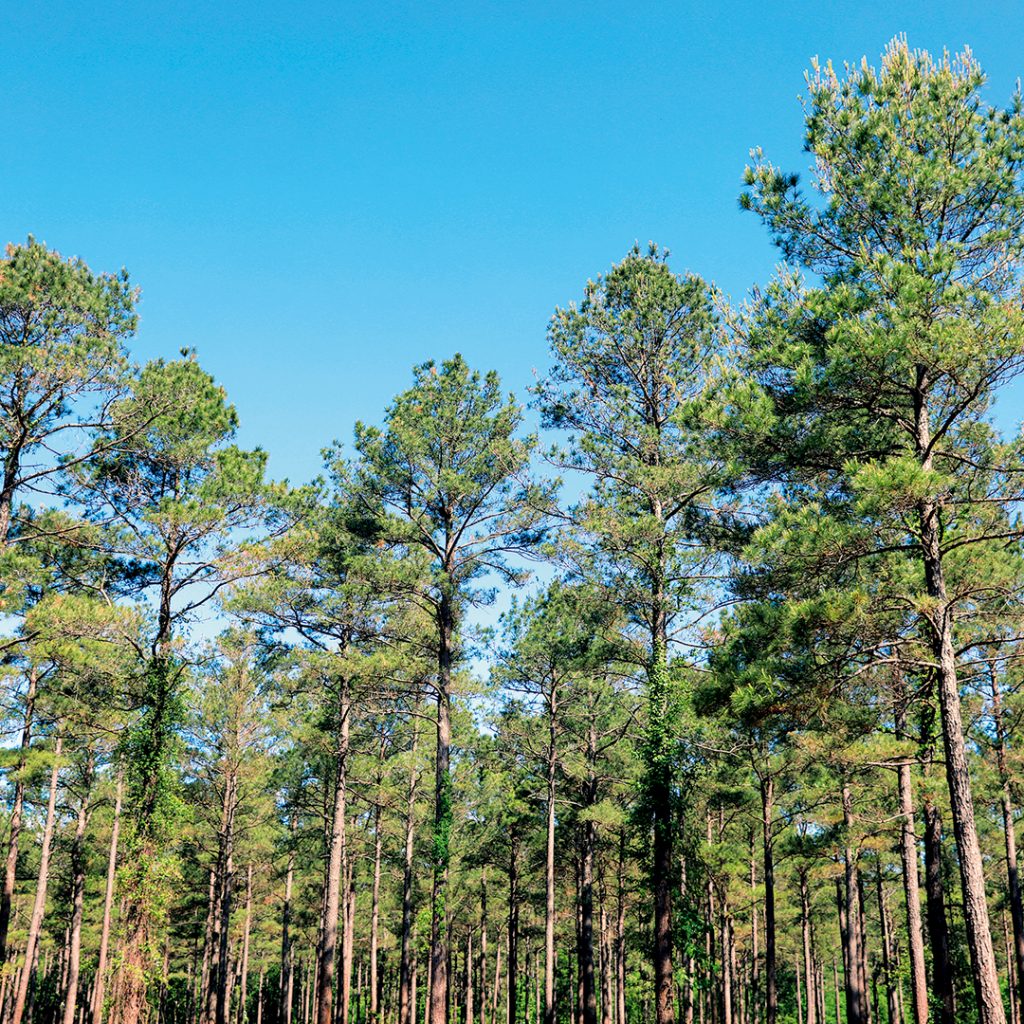
Maintaining Forest Carbon Stocks
We are committed to sourcing sustainable biomass that contributes to the long-term maintenance of growing stock and productivity and that helps to improve the health and quality of forests at a local and regional level.
We monitor forest inventory data and local industry trends, in addition to certification and our auditing process, to determine whether biomass demand is having an impact on regional forest industries. This allows us to make informed sourcing decisions.
Drax has recently completed the first phase of our planned Catchment Area Analysis reports at the Drax Biomass Amite and Morehouse Bioenergy Plants in the US South and also for our suppliers in Estonia. These reports are available on the Drax website. The aim of this analysis is to evaluate the trends occurring in the forestry sector around the plant and to determine what impact the pellet mill may have had in influencing those trends, positively or negatively. This includes the impact on harvesting levels, carbon stock, growth rate, wood prices and the production of all wood products.
The “total growing stock” is the amount of wood stored in the forest. Between 2006 and 2018 the total growing stock surrounding the Drax Biomass Morehouse Bioenergy Plant increased by 68 million metric tonnes.
Biomass Sources in 2019
In 2019 our biomass was sourced from established, responsibly managed working forests in the US South, Europe, Canada, South America and Russia. To enhance our biomass supply chain transparency, we provide detailed supply chain information at Drax ForestScope.

Biomass Supply Chain Emissions
We monitor each step in the supply chain to ensure our requirements are met and greenhouse gas (GHG) emissions associated with producing our biomass are calculated according to regulatory requirements.
The UK Government has set a limit on biomass supply chain GHG emissions which must be met by generators to be eligible for support under the Renewables Obligation and Contract for Difference schemes. The current limit is 285 kgCO2-eq/MWh of electricity, reducing to 200 kgCO2-eq/MWh of electricity in 2020. In 2019, our average biomass supply chain GHG emissions amounted to 124 kgCO2- eq/MWh* of electricity. This is lower than our 2018 average biomass supply chain GHG emissions and 56% less than the UK Government limit.
* Limited external assurance using the assurance standard ISAE 3000 for 2019 data as indicated. For assurance statement and basis of reporting see www.drax.com/uk/sustainability

Healthy Forest Landscapes
Our Partnership with Earthworm
Drax has partnered with Earthworm Foundation (formerly The Forest Trust) to support our approach to responsible biomass sourcing. Earthworm are not-for -profit, responsible sourcing experts, experienced in working with corporate entities developing landscape scale approaches in similar commodity supply chains.
The core programme we are jointly pioneering has been called Healthy Forest Landscapes.
Healthy Forest Landscapes Programme
At Drax, our approach to sourcing biomass responsibly is governed by environmental regulation, our Sustainability and Responsible Sourcing policies, our own checks and third-party audits or Sustainable Biomass Program (SBP) certification.
We recognise such traditional approaches and certification audits are detailed and, although we publish summaries of the output, are not readily digestible by a wide, interested audience. The Healthy Forest Landscapes programme aims to provide further objective and quantified transparency and assurance on our ecological, social and economic impacts in our supply catchment areas. The programme is piloting an approach to capturing remotely sensed data, and other credible origin publicly available information, and sharing the arising metrics that consider the entire source catchment area we are operating in – albeit that the Drax demand is only one small part of a larger, dynamic market for wood in each catchment.
Alongside this, we are looking for opportunities to proactively intervene, as appropriate and feasible, in those instances where changes in our sourcing landscapes have been identified.
Developing our Programme Approach
During the year, we undertook a stakeholder engagement process with Earthworm in the source catchment area around one of our pellet mills and with other stakeholders. We identified and confirmed four key forest biomass source catchment metrics to be used as common indicators across all our sourcing geographies. These are: forest cover, biodiversity, carbon stock and socio-economic wellbeing.
Looking Ahead
During 2020, we will continue piloting technology options in other geographies with third party providers. We aim to be in a position to share more widely the selected technology, programme challenges and more detailed output during 2020. We expect to socialise the approach with other purchasers of wood products derived from the same geographies to test the appetite for broader collaborative adoption.
Over the next four years, we aim to roll out the Healthy Forest Landscapes programme for all our wood source catchment areas. Ultimately Drax will be able to track and report these key metrics for our specific and aggregate impact on key dimensions of forest landscape health in a very timely and accessible way.
Piloting Technology Options
In 2019, we began to pilot technology options to establish how best to gather the data needed to provide credible and replicable measures for our identified metrics.
We piloted the use of big data and remote sensing in the source catchment area of our Amite BioEnergy Plant in Mississippi, USA. Big data and automated interpretation of satellite imagery was applied to develop a time series from before our plant started operation of forest cover, biodiversity and carbon stock metrics.
Forest Cover Maps
The forest cover analysis is arguably the simplest, of the metrics.

The mapping captures the changes in forest cover across the Amite source catchment area from 2010, before the Amite BioEnergy Plant was commissioned in 2015, until 2018. Analysis then shows forest cover, in aggregate, modestly increasing over the time series – supporting our commitment and other publicly available data that there has been no deforestation in the catchment. Detailed analysis shows a working landscape where forests are harvested and replanted, as we’d expect, in a continuous cycle. Satellite data supports on the ground analysis (Forest Inventory and Analysis data) that also indicates an increase in forest cover of 1% (4,000 ha) since the plant opened.
Social
People and Culture
We work to maintain consistently high standards in our employment practices and all our colleagues benefit from policies to support them in the workplace. These include policies designed to enable different work and lifestyle preferences, processes for employees to raise grievances or concerns about safety, along with supporting a diverse and inclusive workplace. Our people strategy focuses on valuing our people, driving business performance and developing talent to deliver our strategic and operational objectives.
During 2019, we focused on the integration of our new Generation colleagues following the acquisition of hydro and gas generation assets in December 2018. We reorganised our structure to align with our business strategy. We are centralising Finance, Procurement, HR and Internal Communications in order to deliver core services consistently across the Group.
Investing in the development of our people is essential to the delivery of our business strategy. Our Potential and Succession processes enable senior leaders to identify individuals with the skills and capability needed for critical roles. Individuals identified can be nominated for our Future Creators programme. Launched in 2019, the programme is designed to develop and retain 22 high-potential individuals and grow our leadership pipeline. Each individual has a personal development plan and an Executive Committee mentor with whom they meet regularly throughout the year. A One Drax award may also be awarded for those identified as having potential to add significant value to Drax.

Diversity and Inclusion
Drax Group is fully committed to the elimination of unlawful and unfair discrimination and we value the benefits that a diverse workforce brings to the organisation. Our goal is to create and maintain a working environment that is both safe and supportive of all our people and where every employee has the opportunity to realise their potential.
Our Diversity and Inclusion Steering Group meets monthly to consider and recommend plans to increase diversity and inclusion. The Steering Group is co-sponsored by the Chief Transformation Officer and Director of Corporate Affairs, both of whom are members of the Executive Committee.
Our 2019 progress included the roll out of eLearning training to all managers, to understand and promote appreciation to correct unconscious bias. We introduced a voluntary keep in touch days process for colleagues on parental leave and reviewed internal data on gender pay. We also focused on recruitment and added a diversity and equality statement to our careers webpages. We hosted around 100 female students from our partner schools at Drax Power Station in November to meet female colleagues and understand the diverse career opportunities in our sector.
Going forward we will set diversity and inclusion objectives for all managers and include diversity training in our leadership and management development programmes. In our recruitment practices, we will provide gender ratio guidance for interview lists and more broadly seek to improve the gender and diversity balance for our apprentice and graduate recruitment. Through our My Voice Forums we will also seek colleague views on establishing diversity networks.
In our 2019 annual survey, we included questions on diversity and inclusion and we will continue to track our performance in this area.
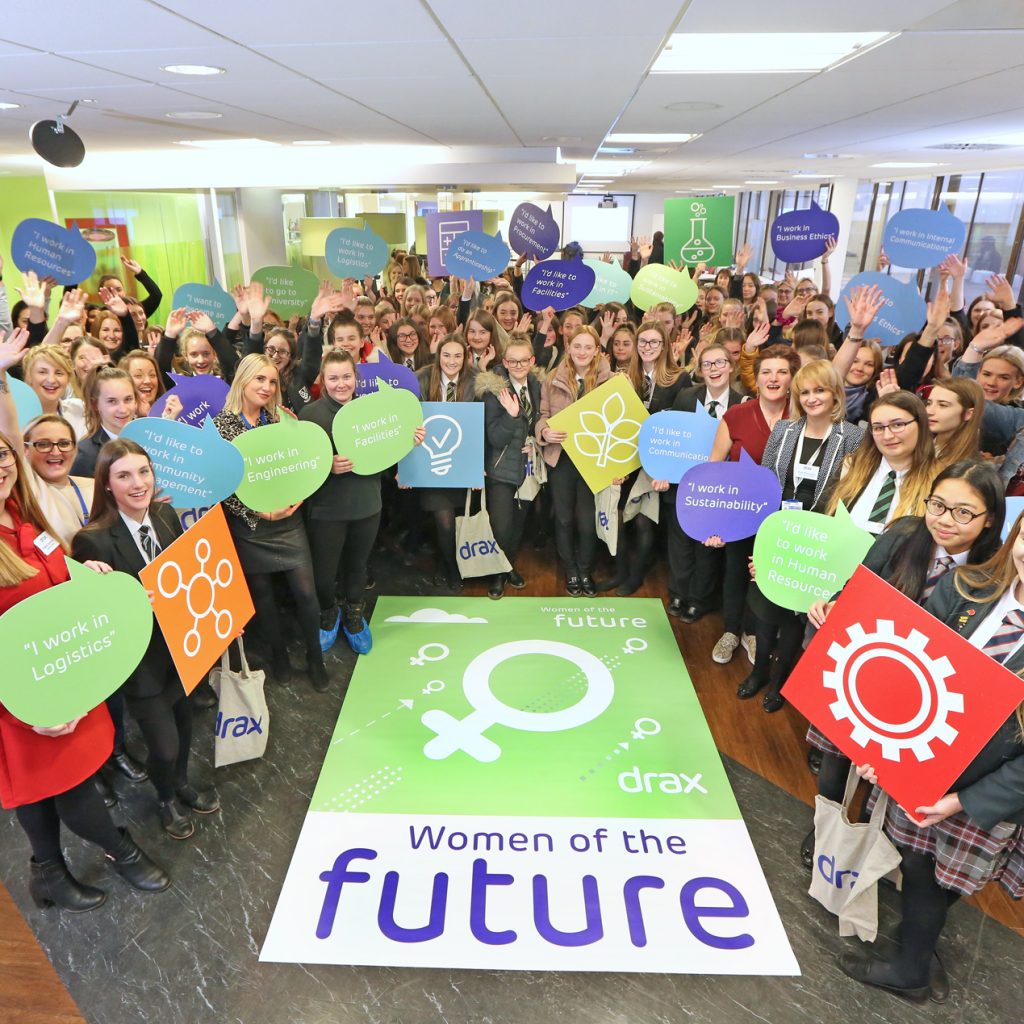
Women of the Future Event Inspires Next Generation
In November 2019 we hosted our first Women of the Future event at Drax Power Station.
Around 100 girls from local schools and colleges, aged between 14 and 18, attended the event, as part of our ongoing efforts to encourage young women to study science, technology, engineering and maths (STEM) subjects, increase diversity in our workforce and support the communities where we operate.
Female colleagues ran group activities, games and mini workshops to illustrate the skills they use in their daily jobs and explained their own career stories.
Employee Representation and Engagement
We have two main sets of arrangements to engage colleagues and provide them with representation across the Group. We engage with colleagues who are represented by trade unions (22% of our workforce is covered by collective bargaining) and we have employee representative consultation and information arrangements in place for employees with individual employment contracts.
We communicate with our workforce through channels including our intranet, quarterly newsletter and Open Forum meetings. Colleagues can ask our Group CEO questions through a weekly online question and answer portal, with the CEO’s responses shared across the Group. During the year, we established My Voice Forums, one for each business unit and each with up to 12 colleague representatives. The Forum Chairs meet quarterly with our Group CEO and Group Chair to provide feedback on topics raised by colleagues. For more information on our workforce engagement, please see the case study on page 28 of the full PDF report.
We track employee engagement through our annual survey and in 2019 this was completed by 67% of employees. Key themes highlighted included colleague careers, manager development and the wellbeing of our colleagues. Responding to themes raised in our 2018 survey, we introduced employee volunteering days and established the My Voice Forums as an additional colleague feedback mechanism.
Health, Safety and Wellbeing
As explained by our CEO Will Gardiner (see page 12), the health, safety and wellbeing of our employees and contractors is vital to the success of the Group and remains our priority.
In 2019, we established our vision for health and safety with One Safe Drax: everyone, every day, safe and well. The building blocks to this are Safe People, Safe Systems & Process, and Safety Assurance.
Safe People
Suitably trained, qualified and experienced people who know what’s expected of them and choose to do the right thing.
Safe Systems and Process
Fit for purpose plant, operations and maintenance activities. Robust management systems.
Safety Assurance
The checks and balances put in place to ensure things are working as intended and to provide continual improvement.
Health and Safety Performance
In 2019, our Group TRIR was 0.22 per 100,000 hours worked (2019 target: 0.18) (2018: 0.22 per 100,000 hours worked). Our LTIR in 2019 was 0.08 per 100,000 hours worked (2018: 0.09 per 100,000 hours worked). This represents an improvement compared with the previous year.

We have Safety Management Systems (SMS) in place to ensure safe workplaces for all our people. At Drax Power Station, the SMS is certified to OHSAS 18001 and subject to regular audits. Our hydro and gas generation assets have an integrated management system covering Safety, Environment & Quality and the safety component will transition to ISO 45001 in 2020. Our Pellet Production sites in the US meet the requirements of OSHA 1910 and the SMS is aligned with, but not certified to, OHSAS 18001. At our Customers and Core Services sites in the UK, we began implementing a Health and Safety Management System in 2019, to create a health and safety culture which prevents accidents and promotes both physical and mental wellbeing.
Safety performance is reported and reviewed regularly by each local management team. Incidents and findings are shared across the Company via safety bulletins, enabling preventative action to be taken to mitigate the risk of future occurrences. Each business unit reports monthly on Key Performance Indicators (KPIs), including Total Recordable Incident rate (TRIR), Lost Time Incident Rate (LTIR). Business units also report Reporting of Injuries, Diseases and Dangerous Occurrences Regulations (RIDDORs) to regulators in the UK. The Board receives monthly reports.
In 2019, we established the Safety, Health, Environment and Wellbeing Leadership Executive Committee (SHEWLEC). The Committee is chaired by the CEO Generation and meets quarterly to receive reports regarding significant safety, health, environmental and wellbeing aspects that are prominent within the business. The Committee also establishes standards for relevant health, safety, environmental and wellbeing issues. It oversees the implementation of relevant policies and principles across the business, reflecting Group philosophy, best practice and regulatory and statutory requirements. It also oversees governance arrangements across the business. Key risks and mitigation associated with health, safety, environment and welfare are routinely reported to the SHEWLEC. The Committee also receives a summary of results of internal and external audits where the scope falls within the remit of the Committee. In addition, the Committee receives and considers potential implications for the Group of information regarding any significant changes in regulation or legislation and oversees how business units amend their arrangements accordingly.
Key issues raised in 2019 include: management of dust at relevant locations, tracking of findings from third-party audits, development and implementation of a Group-wide Wellbeing policy and framework and standardisation of a set of group-wide minimum standards for safety Golden Rules.
Process safety is a key focus for the operational business units. Drax implemented lessons learned from the fire at Drax Power Station pellet handling system in 2017 to make the plant more robust to potential ignition events by installing additional fire detection and suppression equipment. Work on the installation will complete in 2020. Incoming fuel quality and metallic contamination in fuel are key performance measures, since these factors can influence levels of dust, potential for fuel line blockages or ignition events. In 2019, there was greater collaboration with the supply chain and our UK port operators. Drax held a conference in April to share best practice.
Following a major safety incident in December 2018 at our Pellet Production site LaSalle in the US, we identified 42 action items. In 2019, we implemented and closed these corrective action items and focused on supervisor training and improving safety culture.
In 2019, multiple assurance audits were completed across the Group. Drax Power Station was externally audited to OHSAS 18001 with no major findings and the Health and Safety Executive completed a scheduled control of major accident hazards (COMAH) audit with no major findings.
In 2019, Drax introduced Intelex as our Group reporting tool for Safety, Health, Environment and Production incidents. The system went live at our Pellet Production sites in July and at Drax Power Station, our Customer sites and our Head Office in November. We are considering plans to align all Drax sites to a common integrated incident management system.
Process safety is a key focus for the operational business units. Drax implemented lessons learned from the fire at Drax Power Station pellet handling system in 2017 to make the plant more robust to potential ignition events by installing additional fire detection and suppression equipment. Work on the installation will complete in 2020. Incoming fuel quality and metallic contamination in fuel are key performance measures, since these factors can influence levels of dust, potential for fuel line blockages or ignition events. In 2019, there was greater collaboration with the supply chain and our UK port operators. Drax held a conference in April to share best practice.
Following a major safety incident in December 2018 at our Pellet Production site LaSalle in the US, we identified 42 action items. In 2019, we implemented and closed these corrective action items and focused on supervisor training and improving safety culture.
In 2019, multiple assurance audits were completed across the Group. Drax Power Station was externally audited to OHSAS 18001 with no major findings and the Health and Safety Executive completed a scheduled control of major accident hazards (COMAH) audit with no major findings.
Wellbeing at Drax
The Drax-wide Wellbeing programme encompasses three areas and focuses on building resilience.
• Healthy Body–A healthy body means looking after yourself first – finding ways to incorporate a healthy diet, an active lifestyle and healthy habits into the routines of work and home.
• Healthy Mind–A healthy mind is about colleagues being able to focus on what’s important at work.
• Healthy Workplace–We believe that a healthy workplace at Drax supports and encourages healthy behaviours in our colleagues, making healthy choices easy.

Internal Audit commissioned Turner & Townsend to complete a Group-wide audit of health and safety which confirmed that the control framework is generally designed and operating effectively, and effective health and safety management systems were in place. The audit made recommendations to help advance the management of health and safety across the Group as it evolves and an action plan to implement the recommendations has been put in place.
Wellbeing
We recognise the importance of promoting the physical and mental wellbeing of all our colleagues. In 2019, we began implementing a holistic Wellbeing programme across Drax, covering the three areas of Healthy Body, Healthy Mind and Healthy Workplace.
To oversee the programme and measure progress, we set up a Wellbeing Steering Committee. The Committee represents all business units across Drax and meets monthly to ensure effective implementation.
In 2019, we introduced a single private medical insurance and reward programme to our UK colleagues. We aim to achieve complete coverage for UK colleagues in 2020, after the roll out to our hydro and gas generation sites. In addition, all colleagues have access to an Employee Assistance Programme.
Our Customers business continued to expand their workplace wellbeing education programmes in 2019. We have trained nearly 200 Customers colleagues over 2018 and 2019 on the topics of mental health and emotional resilience.
Positive Social Impact
We provide jobs, support economic growth, pay tax responsibly and deliver charitable and employee volunteering initiatives in the communities where we operate.
Our social strategy focuses on improving opportunity and social mobility by promoting education, science, technology, engineering and maths (STEM) skills and employability. We signed the UK cross-party Social Mobility Pledge, demonstrating our commitment to accessing and progressing talent from all backgrounds. In 2019, we recruited 18 apprentices and 6 graduates. This included expanding our apprenticeship scheme to Drax’s Scottish sites where we recruited 5 new apprentices. Our partnership with Teach First enabled the recruitment, placement and training of eight STEM teachers in 2019, improving the STEM education of 1,000 students.
We pledged £100,000 support over four years to support the Galloway Glens Landscape Partnership where our Galloway Hydro Scheme operates.
The funding will be used to promote the region’s heritage, boost the local economy and support sustainability initiatives in local communities.
Community and Charitable Giving
During the year, we launched our new Community and Charity policy, strengthening our charitable giving across the business and enabling colleagues to volunteer one working day annually. In 2019, Drax colleagues volunteered over 2,000 hours and we contributed £290,000 through community partnerships, employee match funding, payroll giving, our community fund and national fundraising days.
Drax Power Station welcomed 9,763 visitors in 2019. Our tours are focused on learning outcomes and tailored for visitors of all ages. Cruachan Power Station in Scotland received 36,646 visitors in 2019 and offers free tours to school children and academic institutions.
Ethics and Integrity
At Drax Group, we are committed to conducting business ethically and in compliance with all relevant laws and regulations. We do not tolerate any form of bribery, corruption or other unethical business conduct.
Our compliance framework consists of principles, policies and guidance. The principles are set out in our ethics handbook, Doing the right thing, which identifies the behaviours expected from colleagues and contractors on topics including human rights, ethical business conduct and integrity. The Doing the right thing principles form part of our terms of employment and have been converted into a series of training videos used in our new starter induction programme. The scope of Doing the right thing will be expanded with the implementation of a new Group Code of Conduct in 2020.
Our policies and guidance documents provide further instruction. These include our Group Corporate Crime policy and Gifts and Hospitality, Conflicts of Interest and Due Diligence guides. In 2019, we published board-approved updates to our Group Corporate Crime policy, Fair Competition policy and associated guides.
In 2019, we established and deployed new eLearning across the Group, including Data Protection and Anti-Bribery and Corruption training for all colleagues. Targeted training on Supply Chain Human Rights, the Criminal Finances Act and Fair Competition was provided for managers and teams in higher risk areas. Refresher training was also provided on Market Abuse Regulation for the Board, Executive Committee and relevant management and employees.
Responsibility for Ethics
Governance of our framework is overseen by the Group Ethics and Business Conduct Committee (EBCC). The EBCC comprises of senior leaders, meets quarterly and is chaired by the Group CFO. EBCC activities are reported annually to the Audit Committee. Management across the Group is responsible for demonstrating leadership on ethical matters and supporting teams to apply our ethical principles, set out in our Doing the right thing booklet, and business ethics policies.
Our Group Business Ethics team manages our various business ethics programmes, taking steps to understand our risk profile, developing policy and procedures, awareness raising and training, as well as investigating any potential breaches of policy, and administrating our external Speak Up (Whistleblowing) service. Our Internal Audit team provides assurance on the robustness of our business ethics programmes and any recommendations for improvement are duly considered and as appropriate, implemented.
The Group Business Ethics team conducts annual risk assessments of each of its programmes, which relate to areas including anti-bribery and corruption, conflicts of interest, data protection, fair competition, and human rights in the supply chain. This is to ensure policy and procedures remain fit for purpose and to recommend any further mitigation measures. Our annual review timetable also includes a review of the Group gifts and hospitality record and a colleague business ethics declaration. Results of annual reviews, details of investigations conducted, whistleblowing reports, and audit outcomes are reported quarterly to both the EBCC and the Audit Committee.
Working with Others
We are a signatory to the UN Global Compact (UNGC) and maintained our representation on their Modern Slavery Working Group in 2019. This enables us to benchmark our compliance programmes and exchange experience with peers, with a particular focus on our response to modern slavery.
We seek to work with suppliers, partners, agents, intermediaries, contractors, consultants and counterparties whose standards are consistent with our own. Third parties are subject to our precontract due diligence checks and regular monitoring through the lifecycle of the contract, via our third-party due diligence system. In cases where a red flag is raised, we follow an EBCC-approved escalation protocol. Depending on the nature of the flagged issue, we may decide not to engage with a new third party, to engage on a conditional basis, to collaborate on remedial action or to end an existing business relationship.
At Drax Group, we are committed to conducting business ethically and in compliance with all relevant laws and regulations.
In 2019, we enhanced our due diligence process, which assesses for risks associated with financial crime, conflicts of interest, anti-competitive behaviour, trade sanctions and other improprieties, such as modern slavery. We centralised these across the business.
Anti-bribery and Anti-corruption
Our internal processes ensure consistency with our zero-tolerance approach to bribery and corruption. Geographic risk is factored into our third-party due diligence system. Conducting business in higher risk countries must receive prior approval from the Group Ethics and Business Conduct Committee.
Following country approval, third parties are then put forward for our due diligence process. Suppliers in higher risk countries receive a higher level of initial due diligence and ongoing monitoring.
We also screen the affiliates (directors, shareholders) of these suppliers and refresh their information on a more frequent basis, compared to our lower risk suppliers. Third parties with operations in, or linked to, higher risk countries are escalated to the EBCC for review prior to engagement. Ongoing monitoring is performed with new information provided to the Group Ethics and Business Conduct Committee, as appropriate.
Modern Slavery
Our Modern Slavery Working Group, chaired by a member of the Business Ethics team, oversees a three-year rolling programme and reports quarterly to the EBCC.
In 2019, we published our third board-approved modern slavery statement in accordance with the UK Modern Slavery Act (www.drax.com/uk/modern-slavery-act/). It describes the steps we are taking to reduce the risk of modern slavery in our supply chain.
We keep our programme and statement under review to ensure it reflects our activities, global presence and wider evolving practice.
Labour and Human Rights
Our commitment to the protection of human rights includes not tolerating the use of underage workers or forced labour. This is set out in our Corporate Crime policy and our Corporate Responsibility (CR) statement.
Our CR statement outlines the standard of ethical business conduct we expect from suppliers. Businesses in our supply chain should offer a safe workplace for their employees that is free from harm, intimidation, harassment and fear. We have incorporated further provisions in our statement template to manage these risks within our procurement contracts and further advanced this effort in 2019 with the drafting of a Code of Conduct and a Supplier Code of Conduct.
With the implementation of a Supplier Code of Conduct in 2020, we will emphasise our requirement for our suppliers and contractors working on our behalf to challenge unethical behaviour and promote a “speak up” culture. We will provide the details of our Speak Up service for their use.
Data Privacy and Security
We take seriously the privacy and security of the personal data we control. We are committed to maintaining effective privacy and security programmes to ensure our people, customers and the third parties we engage with have confidence in our data handling practices.
The EBCC supports and oversees the Group privacy programme and reviewed the first formal programme risk assessment and risk register in 2019. In addition, policies, guides, privacy notices, third party due diligence questionnaires and contractual terms were updated and our first eLearning refresher training (“Overview of Data Protection”) was developed and deployed across the Group. Internal Audit completed an audit of our privacy programme and no red-rated findings were identified.
We continue to monitor and adapt our compliance with the requirements of the General Data Protection Regulation, the UK Data Protection Act 2018, regulatory guidance and other associated legislation such as the e-Privacy & Electronic Communications Regulation.
Security risk management has continued to mature through 2019, with a comprehensive improvement plan implemented and intended to enable key IT Security control effectiveness to achieve best practice. The plan was initiated in 2019 and work will continue through 2020. In addition, a security governance structure was put in place to assess and communicate the evolving threat landscape and identify appropriate responses. An ongoing security assurance programme is in place.
We maintain risk-based security controls to protect our employee and customer data, by detecting and preventing threats and security breaches. In addition to traditional security measures, we undertake advanced threat monitoring and analytics measurement intended to detect, identify, respond to and resolve cyber threats and attacks. We are conscious that such threats continue to change. Accordingly, our security programme seeks to evolve our controls and response to cyber threats.
Speak Up (Whistleblowing)
As part of our commitment to transparency and openness, we encourage those working for or on behalf of Drax to raise genuine concerns about practices which could breach laws, regulations or standards. This is supported by our Doing the right thing handbook and Speak Up (Whistleblowing) policy. Colleagues can either raise concerns internally, through line management, a member of the Group Business Ethics team, the Group Company Secretary (Whistleblowing Officer), directly with a member of the EBCC or externally through our anonymous third-party Speak Up service.
The Group Business Ethics team manages the Speak Up (Whistleblowing) programme. The team maintains relevant records and investigates ethical-related matters under the supervision of the Whistleblowing Officer and governance of the EBCC and Board. Where required, relevant senior leadership are consulted, and a course of action agreed. Drax has a zero tolerance of retaliation and considers it a disciplinary matter to victimise or retaliate in any way against someone who has raised a genuine concern.
During 2019, communications on speaking up were rolled out to all colleagues, temporary colleagues and certain contractors as part of the 2019 Business Ethics policy deployment and eLearning programme. In 2019, six concerns were reported via internal channels and two via our anonymous third-party Speak Up service. This is an increase from zero reports in the previous year and demonstrates the effectiveness of our efforts to increase awareness of our reporting channels and promote an open, “speak up” culture.
Non-Financial Information Statement
We have summarised in this Annual Report and Accounts our policies, standards and disclosures in relation to non-financial matters in line with the Non-Financial Reporting (NFR) requirements of the Companies Act 2006. This report forms our UN Global Compact (UNGC) Communication on Progress and we have mapped the NFR requirements to the four issue areas of the Ten Principles of the UNGC.

Chapter 7:
Viability Statement & Principal Risks
In accordance with the UK corporate governance code, the Directors have assessed the prospects of the Group over a period significantly longer than the 12 months required by the going concern provision.
The assessment of viability was led by the Group Chief Executive and Chief Financial Officer in conjunction with divisional and functional management teams and presented to the Board as part of the annual planning process. In reviewing this assessment, the Board has considered the principal risks faced by the Group, relevant financial forecasts and sensitivities, the availability of adequate funding and the strength of the Group’s control environment.
Assessment period
The Board conducted this assessment over a period of three years, selected for the following reasons:
- The Group’s BusinessPlan(Plan) which is prepared annually, updated twice during the year and also used for strategic decision-making, includes a range of financial forecasts and associated sensitivity analysis.
This Plan covers a three-year period in detail, before extending into the medium term. - Within the three-year period liquid commodity market curves and established contract positions are used in the forecasts. Liquid curves typically cover a one to two-year window and contracts cover periods between one and ten years. In particular, the Group benefits from the stable and material earnings stream available from the CfD until 2027. Selecting a three-year period balances short-term market liquidity against longer-term contractual positions.
- There is limited certainty around the Group’s markets and regulatory regimes. However, in selecting a three-year period the Board has assumed no material changes to the medium-term regulatory environment and associated support regimes beyond those already announced at the date of this report.
Review of principal risks
The Group’s principal risks and uncertainties, set out in detail on pages 54 to 61 of the full PDF report, have been considered over the period.
The principal risks with the potential to exert significant influence on viability are: commodity price changes, political and regulatory changes, and plant operating failures. A significant adverse change to the status of each risk has the potential to place material financial stress onthe Group.The risks were evaluated, where possible, to assess the potential impact of each on the viability of the Group, should that risk arise in its unmitigated form. The potential inputs were included, where appropriate, as sensitivities tothe Plan and considered by the Board as part of the approval process, in January 2020, before the Plan was adopted by the Group.The Group has a proven track record of adapting to changes to its environment and deploying innovative solutions to protect its financial performance. Previous adverse events have arisen and provided challenges which tested the ability of the Group to deliver on its targets but, on each occasion, it has been able to respond positively and manage the impact. This provides the Board with confidence that risks can be sufficiently mitigated, and viability can be maintained, during the assessment period.
Review of financial forecasts
The Plan considers the Group’s financial position, performance, cash flows, credit metrics and other key financial ratios and was most recently updated to reflect current market and external environment conditions in December 2019. It is built by business and segment and includes growth assumptions appropriate to the markets each business serves.
The Plan includes certain assumptions, the most material of which relate to commodity market price curves and levels of subsidy support available to the Group through the generation of biomass-fuelled renewable power.
It is underpinned by the stable revenues available through the generation of CfD-backed electricity and contracted sales from the Customers business.
The Plan is subject to stress testing, which involves the construction of reasonably foreseeable scenarios, including those aligned to the principal risks, which test the robustness of the Plan when key variables are flexed both individually and in unison. Where such a scenario suggests a risk to viability, the availability and quantum of mitigating actions is considered.
The Board considers the most material scenario in the assessment period to be a significant deterioration of commodity market prices, leading to a fall in the available price for power and thus a fall in the margins available to the Group from power generation and supply activities. This impact would however be partially mitigated through the earnings stability provided by the CfD, the Group’s ability to trade effectively in volatile power markets and reductions to discretionary expenditure.
Based on its review, the Board is satisfied the viability of the Group would be preserved in a range of scenarios, with various mitigating actions available, sufficient to manage the risk, including significant deterioration of commodity market prices.
Availability of adequate funding
The sources of funding available to the Group are set out in note 4.3 to the consolidated financial statements (page 163 of the full PDF report). The Board expects these sources, along with stable cash flows generated by the Group from its normal operations, to provide adequate levels of funding to support the execution of the Group’s Plan.
During the year the Group drew down and subsequently restructured £550 million of its £725 million acquisition bridge facility that was used to partially fund the acquisition of the hydro and gas generation assets. In May 2019 an additional $200 million of the existing 2025 6.625% USD loan notes was issued, the proceeds of which were used to repay £150 million of the acquisition bridge facility. In July 2019 the refinancing of the remaining £400 million was concluded in the form of two new facilities with combined proceeds of £500 million, a £375 million UK infrastructure private placement and an environmental, social and governance facility of £125 million. These arrangements both reduced the overall cost of debt and extended the maturity profile to 2029 to further strengthen the balance sheet.
The Board is confident that the Group has access to a range of options to maintain a diverse and well-balanced capital structure.
Expectations
The Directors have considered a range of factors in their assessment of viability over the next three years, including the latest Plan, scenario analysis, levels of funding, the control environment and the principal risks and uncertainties facing the Group. The Directors have also considered the availability of actions within their control in the event of plausible negative scenarios occurring. The Directors have a reasonable expectation that the Group will be able to continue in operation and meet its liabilities as they fall due over the three-year period of their assessment.
Principal risks and uncertainties
The effective management of risk supports the delivery of our strategy
Identifying, assessing and managing risks across the Group is an integral part of the delivery of our strategy. We manage the commercial and operational risks faced by the Group in accordance with policies approved by the Board.
The Board is responsible for determining risk appetite and ensuring the effectiveness of risk management and internal controls across the Group. The Group has a comprehensive system of governance controls to manage key risks.
Group approach to risk management
The risk appetite determined by the Board varies depending on the risk, and guides the principles of the Group’s culture, behaviour and the intensity of risk management activities in achieving our business objectives. We consider a range of risk categories including environment, health, safety, strategic, financial, political, regulatory and operational. The Group has a Risk Management Policy, approved by the Board, which defines the Group’s approach to risk management. The key elements of the policy are to:
- Identify risks that have the potential to threaten the achievement of our strategic objectives. We then assess the likelihood of the risk occurring and possible impact to the business in the event it should arise. This assessment is based on a risk scoring matrix to ensure we take a consistent approach.
- Assign responsibility and define accountabilities for the identification, assessment and management of risk and provide resources to enable appropriate measures to be taken.
- Put in place appropriate mitigating controls intended to manage identified risks to an acceptable level.
- Escalate and report information on the potential risk and the effectiveness of the mitigations and controls to support management decision making.
- Regularly monitor changes within and outside our business, review the Group’s principal risks against such changes to ensure our analysis remains accurate and up-to-date and review the effectiveness of mitigation strategies and the application of the risk framework.
The approach manages, rather than eliminates, the risk of failure to achieve business objectives, and provides reasonable, not absolute, assurance against material misstatement or loss.
Risk management governance
The risk management governance structure includes Executive Committee level principal risk owners and risk management committees whose responsibilities include:
- Ensuring that risks are identified, assessed and managed effectively within risk appetites and limits.
- Including new and emerging risks.
- Demonstrating robust governance of risk management by reviewing and challenging risk management across the Group and driving the completion of actions to manage risks within risk appetites and limits.
- Driving an appropriate risk management culture and an environment that promotes and creates balanced risk-taking behaviour and clear accountability.
The risk management committees receive reports from business units and risk owners. The Executive Committee receive reports from the risk management committees and principal risk owners and undertake deep dive reviews of the management of principal risks.
In addition, the Audit Committee review the suitability and effectiveness of risk management processes and controls on behalf of the Board.
Internal control
The Group has a well-defined internal control system established through policies and procedures, documented levels of authority which support decision- making and accountability for day-to-day management across the Group.
The Board has adopted a schedule of matters which are required to be brought to it for a decision, below which authority is delegated through the Executive Committee to a combination of sub-committees and individuals enabling them to make decisions on behalf of the Group and its businesses for its day-to- day activities. The internal control system is designed to ensure that the directors and executive maintain effective oversight and direction for all material strategic, operational, financial and organisational issues.
Under authority delegated by the Board, the Audit Committee, implements a programme of internal audits of different aspects of the Group’s activities. The programme is developed based on an assessment of the key risks of the Group, the existing assurance and controls in place to manage the risks and the core financial control framework. The programme is reviewed quarterly and refreshed to reflect developments within the Group as well as changes in wider practices, informed by the experience of internal and external personnel.
Internal audits are performed either by the in-house team members of the internal audit function or by external parties where their appointment has first been considered and approved by the Audit Committee. The findings and recommendations from each internal audit are documented in a report for internal distribution and action. A full copy of the report is distributed to the Executive Committee and the Audit Committee. Each report includes management responses to the findings and recommendations and details of the actions that management propose to take.
Based on the reporting from the Executive Committee and the Audit Committee undertaken during 2019 and considered at the meeting of the Board held in finalising the annual report and financial statements, the Board determined that it was not aware of any significant deficiency or material weakness in the system of internal control. For further information on the work of the Audit Committee, please see the Audit Committee report on page 78 of the full PDF report.
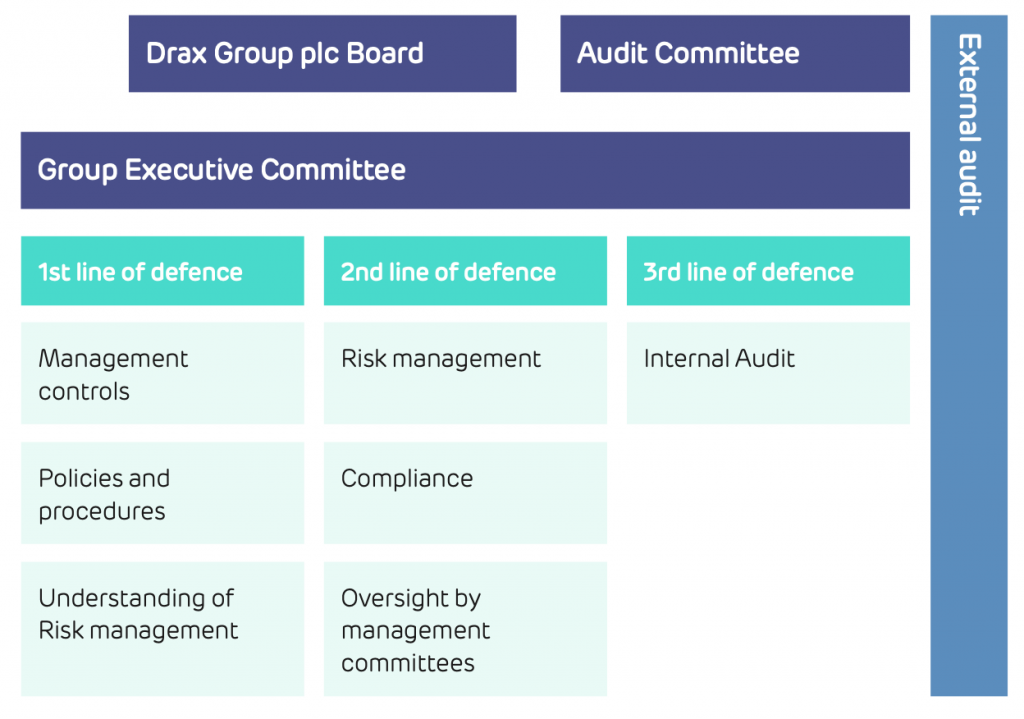
Principal risks and uncertainties
Risks are reported to the Board and disclosed in the Annual Report and Accounts undermine principal risk headings. The Board has assessed the principal risk categories. These are broadly unchanged from 2018 with two exceptions: Transaction risks, which was included in 2018 to reflect the risks associated with the acquisition of hydro and gas assets. The risk category has been removed as these assets have been integrated successfully into our operations during 2019. A new category entitled Climate Change has been created. This reflects the increasing focus on such risks, given the nature of our sector and operations, and our work to implement the recommendations of the Task Force on Climate-related Financial Disclosures (TCFD).
Current Principal Risk categories
1. Environment, Health and Safety
2. Political and Regulatory
3. Strategic
4. Biomass Acceptability
5. Plant Operations
6. Trading and Commodity
7. Information Systems and Security
8. People
9. Climate Change (new)


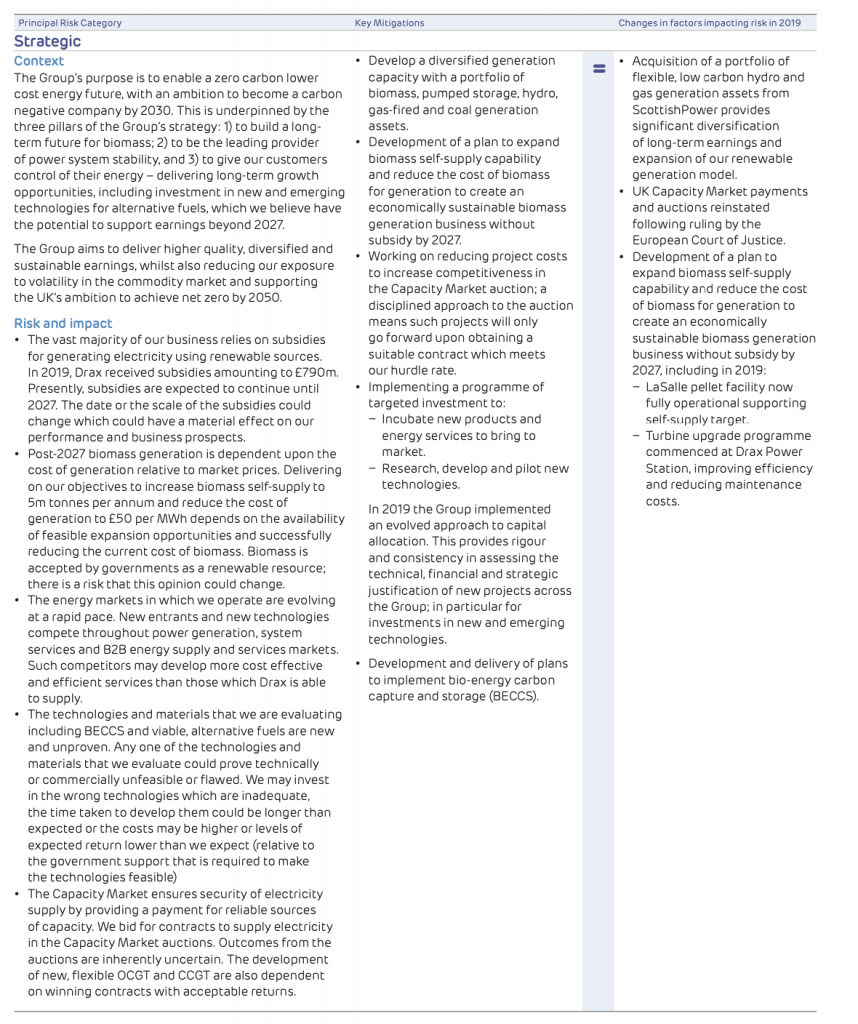



This web page presents the Strategic Report section.
View the full PDF:








